Employee Motivation's Role in Managing Organizational Stress
VerifiedAdded on 2023/01/19

Paraphrase This Document
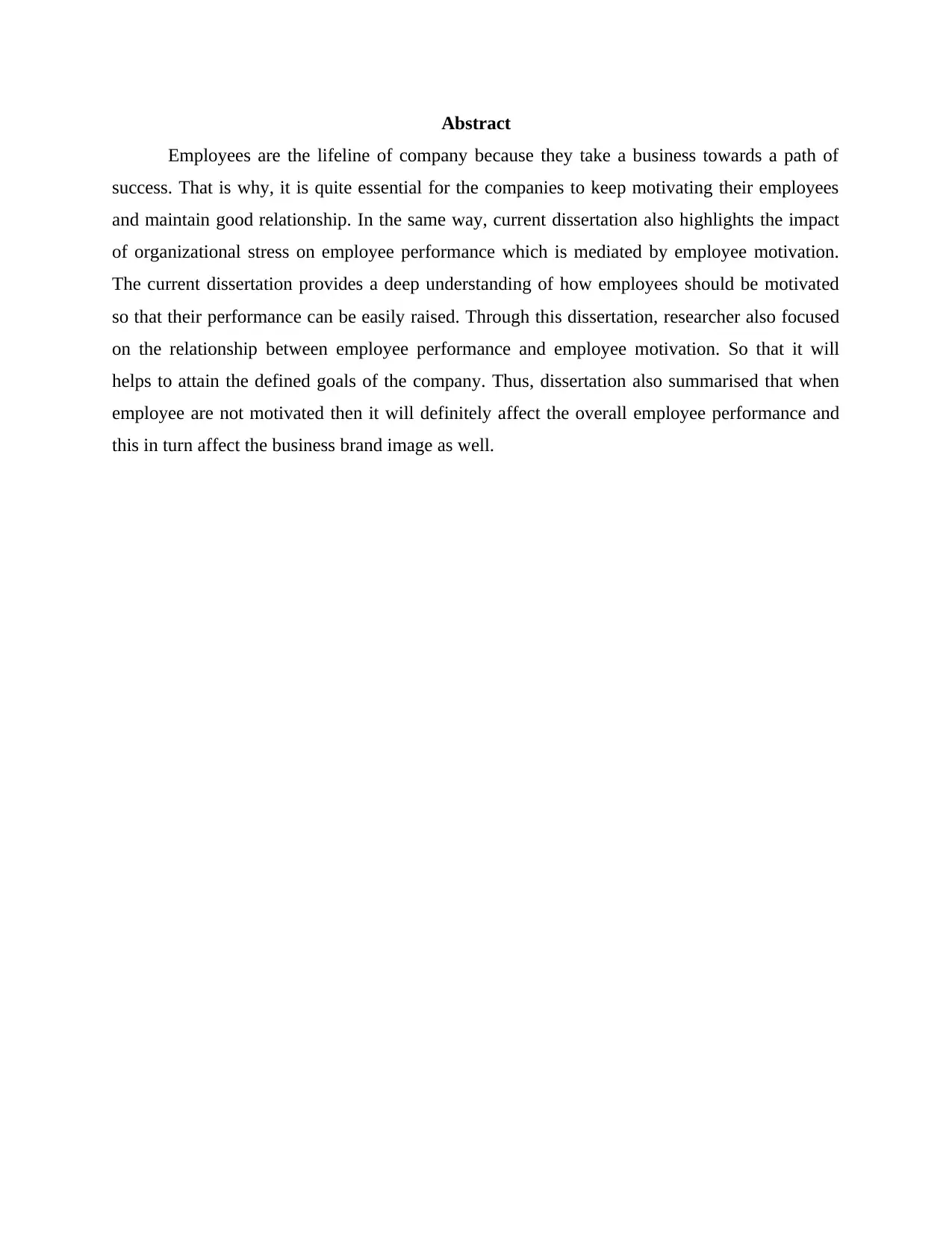
Employees are the lifeline of company because they take a business towards a path of
success. That is why, it is quite essential for the companies to keep motivating their employees
and maintain good relationship. In the same way, current dissertation also highlights the impact
of organizational stress on employee performance which is mediated by employee motivation.
The current dissertation provides a deep understanding of how employees should be motivated
so that their performance can be easily raised. Through this dissertation, researcher also focused
on the relationship between employee performance and employee motivation. So that it will
helps to attain the defined goals of the company. Thus, dissertation also summarised that when
employee are not motivated then it will definitely affect the overall employee performance and
this in turn affect the business brand image as well.
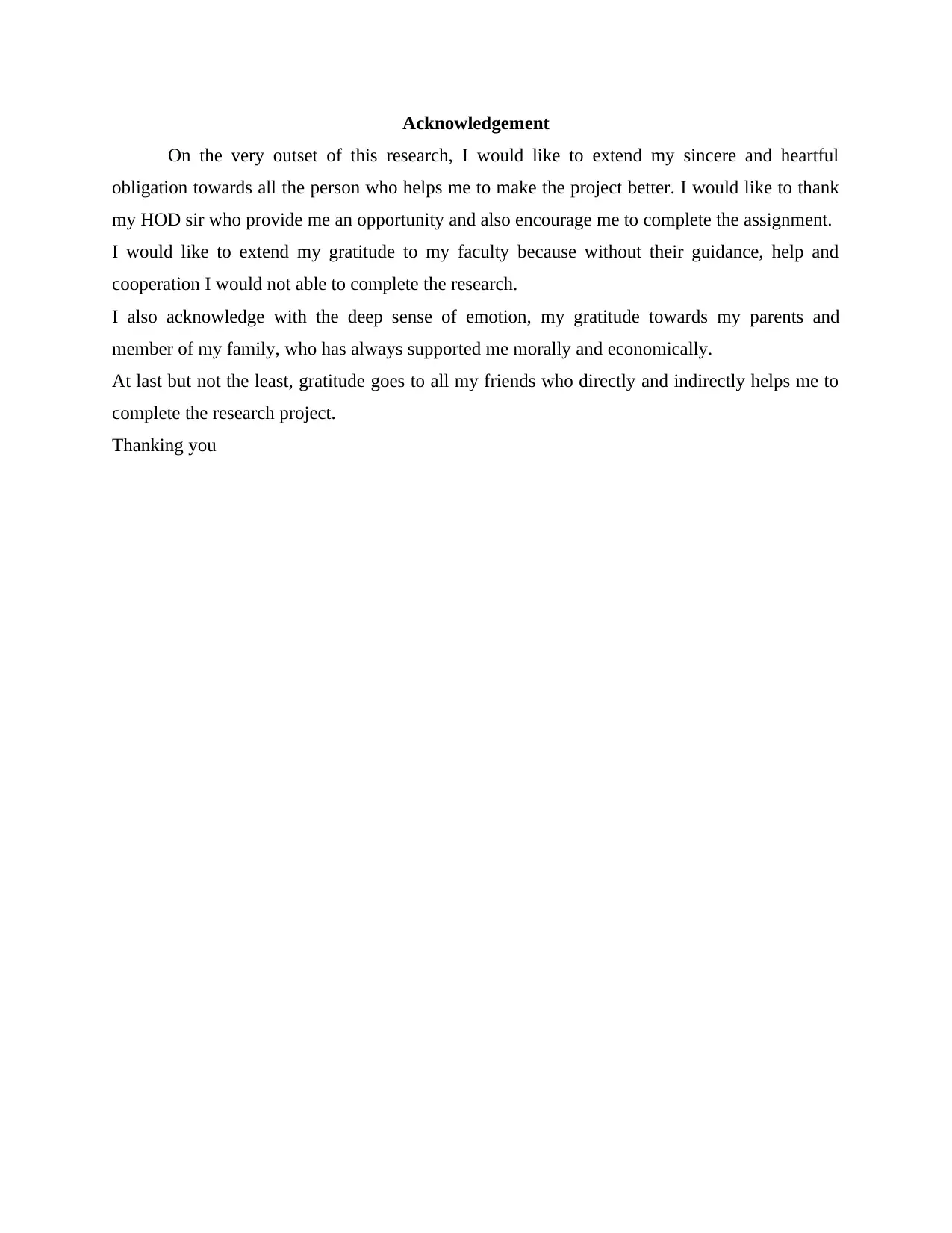
On the very outset of this research, I would like to extend my sincere and heartful
obligation towards all the person who helps me to make the project better. I would like to thank
my HOD sir who provide me an opportunity and also encourage me to complete the assignment.
I would like to extend my gratitude to my faculty because without their guidance, help and
cooperation I would not able to complete the research.
I also acknowledge with the deep sense of emotion, my gratitude towards my parents and
member of my family, who has always supported me morally and economically.
At last but not the least, gratitude goes to all my friends who directly and indirectly helps me to
complete the research project.
Thanking you
⊘ This is a preview!⊘
Do you want full access?
Subscribe today to unlock all pages.

Trusted by 1+ million students worldwide
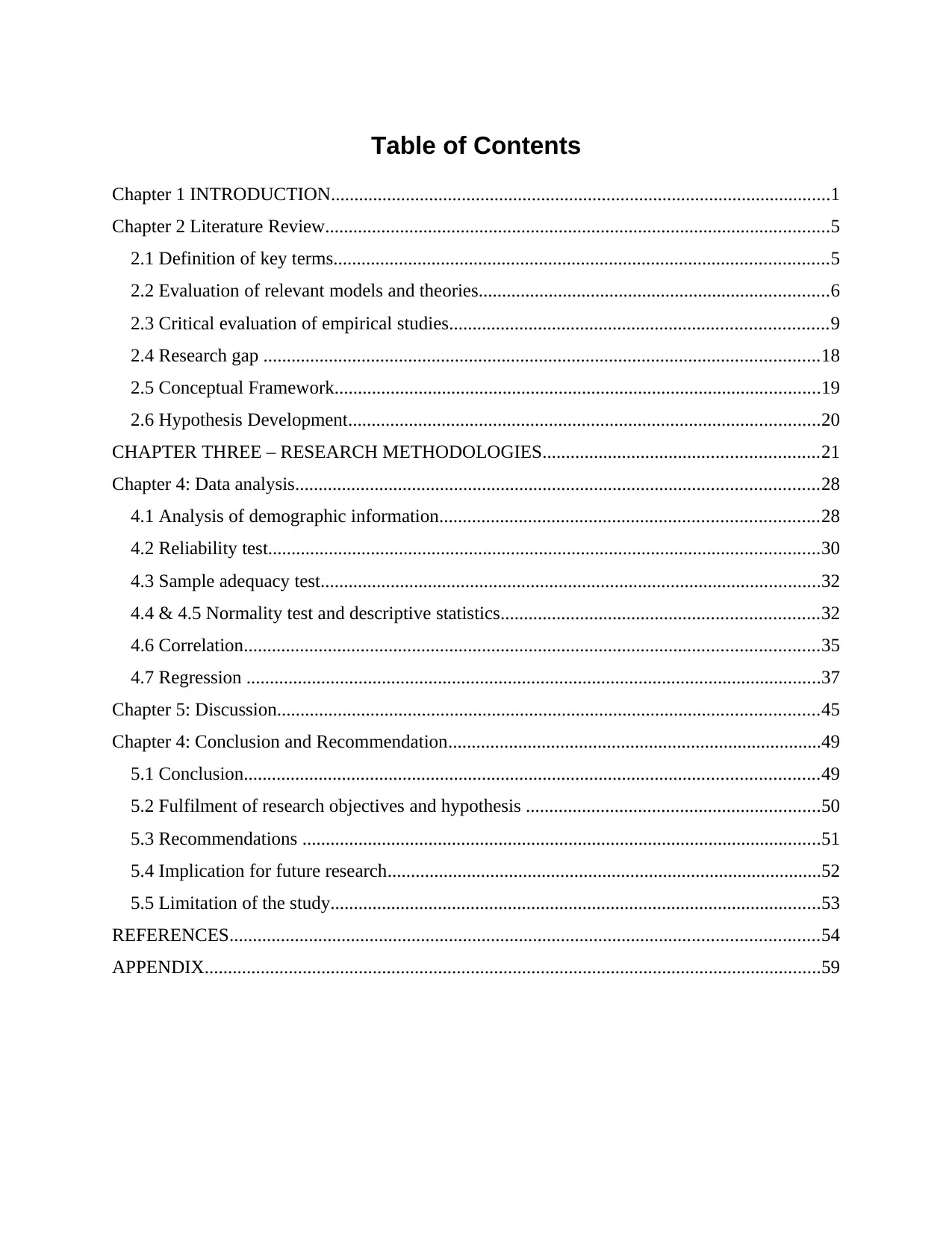
Chapter 1 INTRODUCTION...........................................................................................................1
Chapter 2 Literature Review............................................................................................................5
2.1 Definition of key terms..........................................................................................................5
2.2 Evaluation of relevant models and theories...........................................................................6
2.3 Critical evaluation of empirical studies.................................................................................9
2.4 Research gap .......................................................................................................................18
2.5 Conceptual Framework........................................................................................................19
2.6 Hypothesis Development.....................................................................................................20
CHAPTER THREE – RESEARCH METHODOLOGIES...........................................................21
Chapter 4: Data analysis................................................................................................................28
4.1 Analysis of demographic information.................................................................................28
4.2 Reliability test......................................................................................................................30
4.3 Sample adequacy test...........................................................................................................32
4.4 & 4.5 Normality test and descriptive statistics....................................................................32
4.6 Correlation...........................................................................................................................35
4.7 Regression ...........................................................................................................................37
Chapter 5: Discussion....................................................................................................................45
Chapter 4: Conclusion and Recommendation................................................................................49
5.1 Conclusion...........................................................................................................................49
5.2 Fulfilment of research objectives and hypothesis ...............................................................50
5.3 Recommendations ...............................................................................................................51
5.4 Implication for future research.............................................................................................52
5.5 Limitation of the study.........................................................................................................53
REFERENCES..............................................................................................................................54
APPENDIX....................................................................................................................................59
Paraphrase This Document
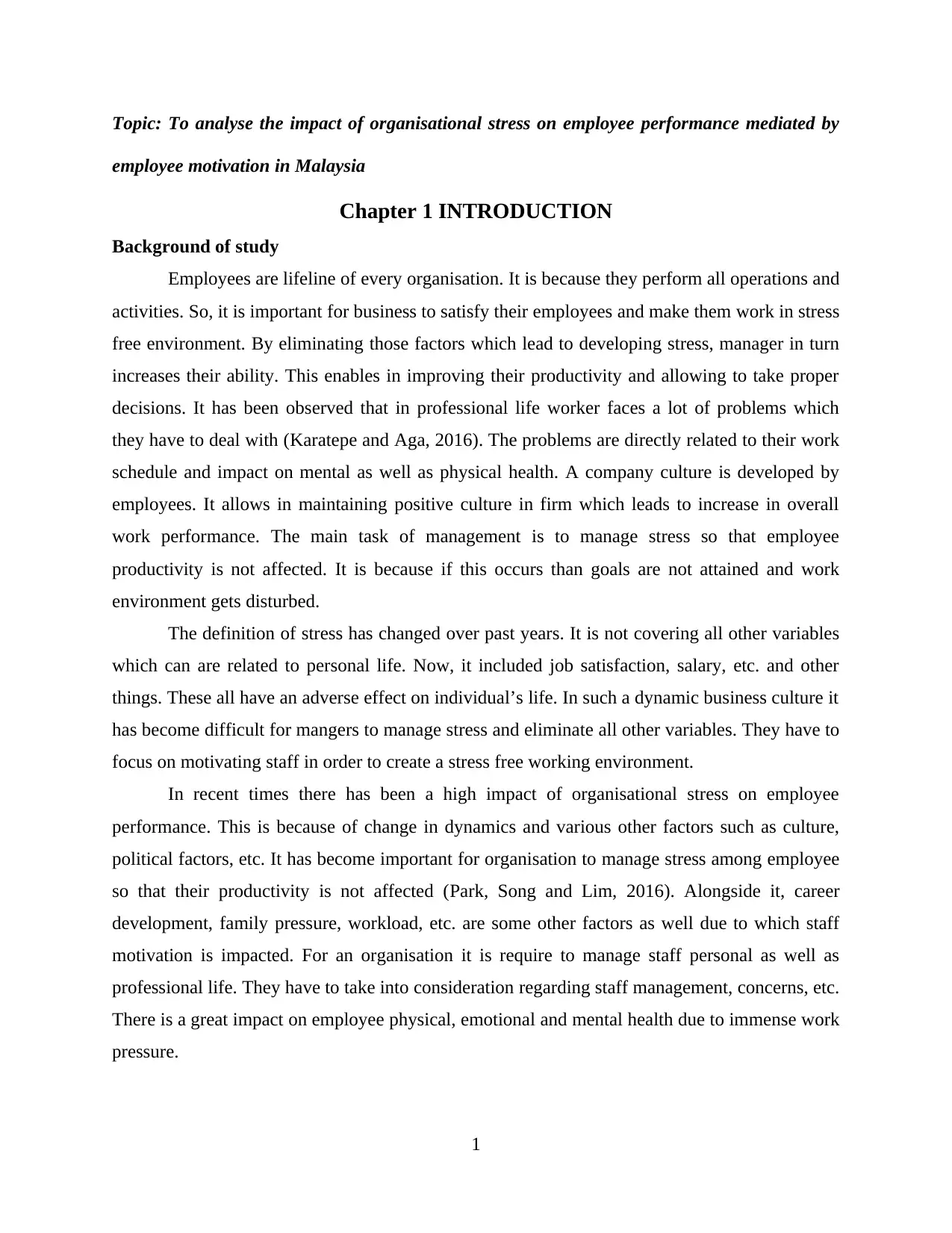
employee motivation in Malaysia
Chapter 1 INTRODUCTION
Background of study
Employees are lifeline of every organisation. It is because they perform all operations and
activities. So, it is important for business to satisfy their employees and make them work in stress
free environment. By eliminating those factors which lead to developing stress, manager in turn
increases their ability. This enables in improving their productivity and allowing to take proper
decisions. It has been observed that in professional life worker faces a lot of problems which
they have to deal with (Karatepe and Aga, 2016). The problems are directly related to their work
schedule and impact on mental as well as physical health. A company culture is developed by
employees. It allows in maintaining positive culture in firm which leads to increase in overall
work performance. The main task of management is to manage stress so that employee
productivity is not affected. It is because if this occurs than goals are not attained and work
environment gets disturbed.
The definition of stress has changed over past years. It is not covering all other variables
which can are related to personal life. Now, it included job satisfaction, salary, etc. and other
things. These all have an adverse effect on individual’s life. In such a dynamic business culture it
has become difficult for mangers to manage stress and eliminate all other variables. They have to
focus on motivating staff in order to create a stress free working environment.
In recent times there has been a high impact of organisational stress on employee
performance. This is because of change in dynamics and various other factors such as culture,
political factors, etc. It has become important for organisation to manage stress among employee
so that their productivity is not affected (Park, Song and Lim, 2016). Alongside it, career
development, family pressure, workload, etc. are some other factors as well due to which staff
motivation is impacted. For an organisation it is require to manage staff personal as well as
professional life. They have to take into consideration regarding staff management, concerns, etc.
There is a great impact on employee physical, emotional and mental health due to immense work
pressure.
1
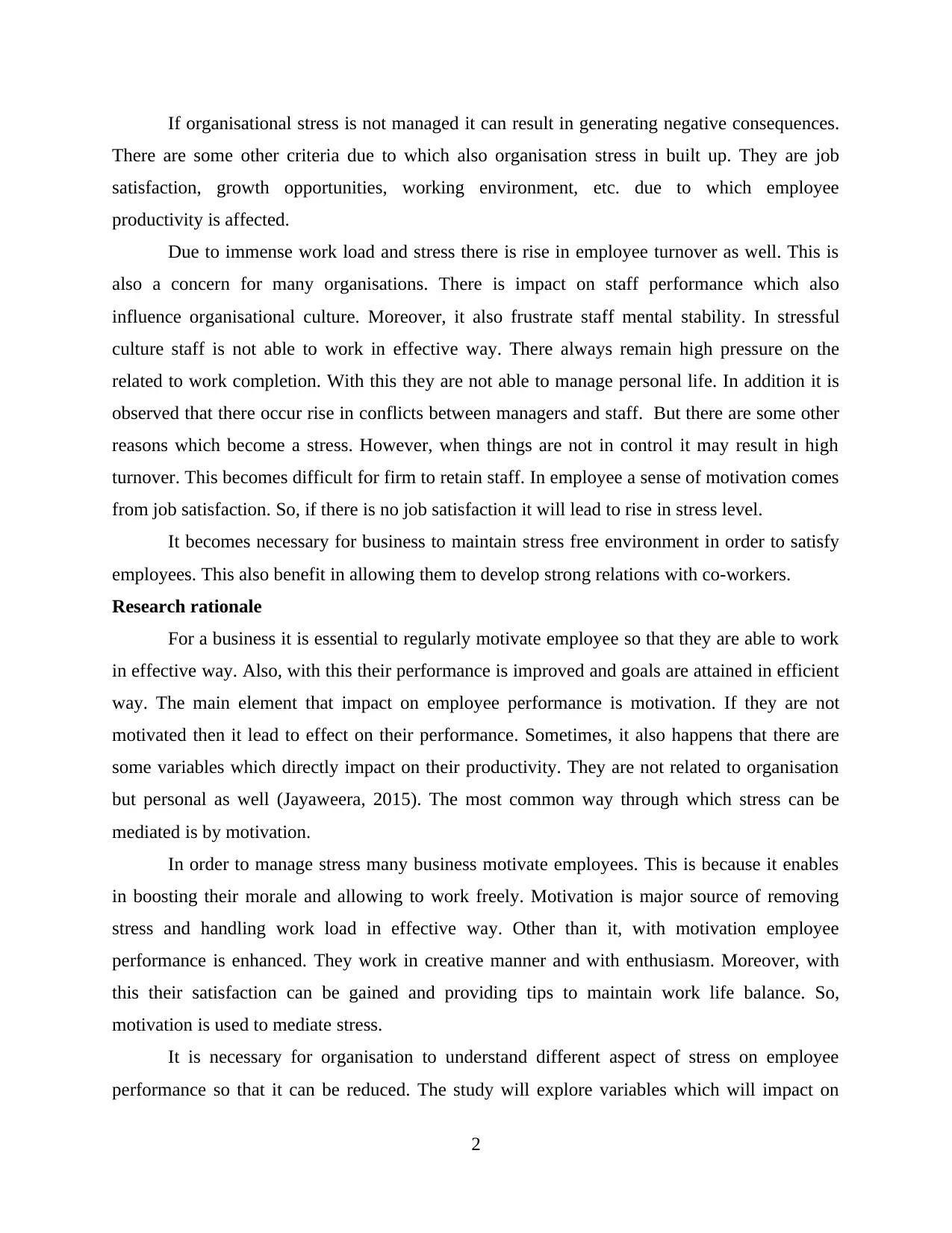
There are some other criteria due to which also organisation stress in built up. They are job
satisfaction, growth opportunities, working environment, etc. due to which employee
productivity is affected.
Due to immense work load and stress there is rise in employee turnover as well. This is
also a concern for many organisations. There is impact on staff performance which also
influence organisational culture. Moreover, it also frustrate staff mental stability. In stressful
culture staff is not able to work in effective way. There always remain high pressure on the
related to work completion. With this they are not able to manage personal life. In addition it is
observed that there occur rise in conflicts between managers and staff. But there are some other
reasons which become a stress. However, when things are not in control it may result in high
turnover. This becomes difficult for firm to retain staff. In employee a sense of motivation comes
from job satisfaction. So, if there is no job satisfaction it will lead to rise in stress level.
It becomes necessary for business to maintain stress free environment in order to satisfy
employees. This also benefit in allowing them to develop strong relations with co-workers.
Research rationale
For a business it is essential to regularly motivate employee so that they are able to work
in effective way. Also, with this their performance is improved and goals are attained in efficient
way. The main element that impact on employee performance is motivation. If they are not
motivated then it lead to effect on their performance. Sometimes, it also happens that there are
some variables which directly impact on their productivity. They are not related to organisation
but personal as well (Jayaweera, 2015). The most common way through which stress can be
mediated is by motivation.
In order to manage stress many business motivate employees. This is because it enables
in boosting their morale and allowing to work freely. Motivation is major source of removing
stress and handling work load in effective way. Other than it, with motivation employee
performance is enhanced. They work in creative manner and with enthusiasm. Moreover, with
this their satisfaction can be gained and providing tips to maintain work life balance. So,
motivation is used to mediate stress.
It is necessary for organisation to understand different aspect of stress on employee
performance so that it can be reduced. The study will explore variables which will impact on
2
⊘ This is a preview!⊘
Do you want full access?
Subscribe today to unlock all pages.

Trusted by 1+ million students worldwide
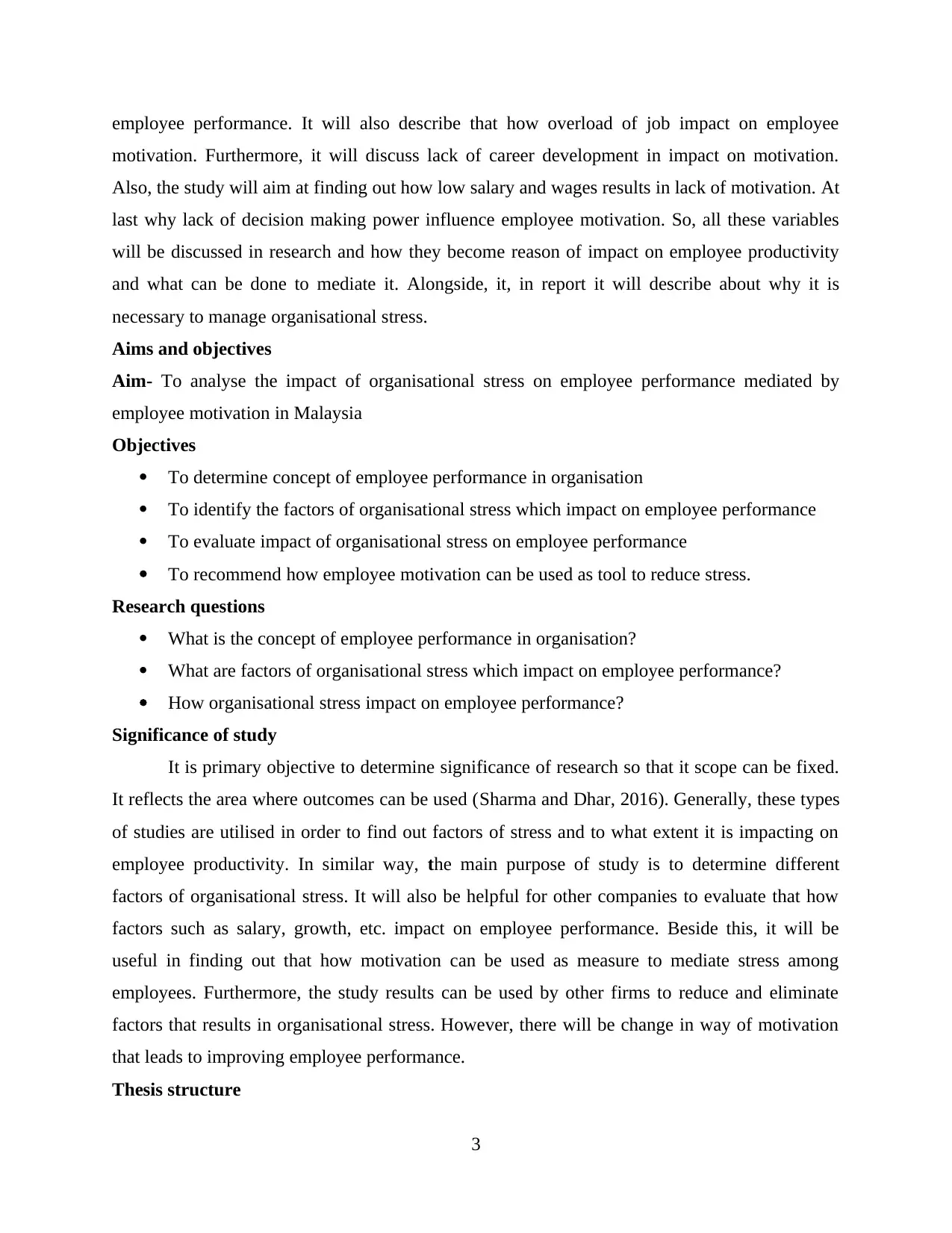
motivation. Furthermore, it will discuss lack of career development in impact on motivation.
Also, the study will aim at finding out how low salary and wages results in lack of motivation. At
last why lack of decision making power influence employee motivation. So, all these variables
will be discussed in research and how they become reason of impact on employee productivity
and what can be done to mediate it. Alongside, it, in report it will describe about why it is
necessary to manage organisational stress.
Aims and objectives
Aim- To analyse the impact of organisational stress on employee performance mediated by
employee motivation in Malaysia
Objectives
To determine concept of employee performance in organisation
To identify the factors of organisational stress which impact on employee performance
To evaluate impact of organisational stress on employee performance
To recommend how employee motivation can be used as tool to reduce stress.
Research questions
What is the concept of employee performance in organisation?
What are factors of organisational stress which impact on employee performance?
How organisational stress impact on employee performance?
Significance of study
It is primary objective to determine significance of research so that it scope can be fixed.
It reflects the area where outcomes can be used (Sharma and Dhar, 2016). Generally, these types
of studies are utilised in order to find out factors of stress and to what extent it is impacting on
employee productivity. In similar way, the main purpose of study is to determine different
factors of organisational stress. It will also be helpful for other companies to evaluate that how
factors such as salary, growth, etc. impact on employee performance. Beside this, it will be
useful in finding out that how motivation can be used as measure to mediate stress among
employees. Furthermore, the study results can be used by other firms to reduce and eliminate
factors that results in organisational stress. However, there will be change in way of motivation
that leads to improving employee performance.
Thesis structure
3
Paraphrase This Document
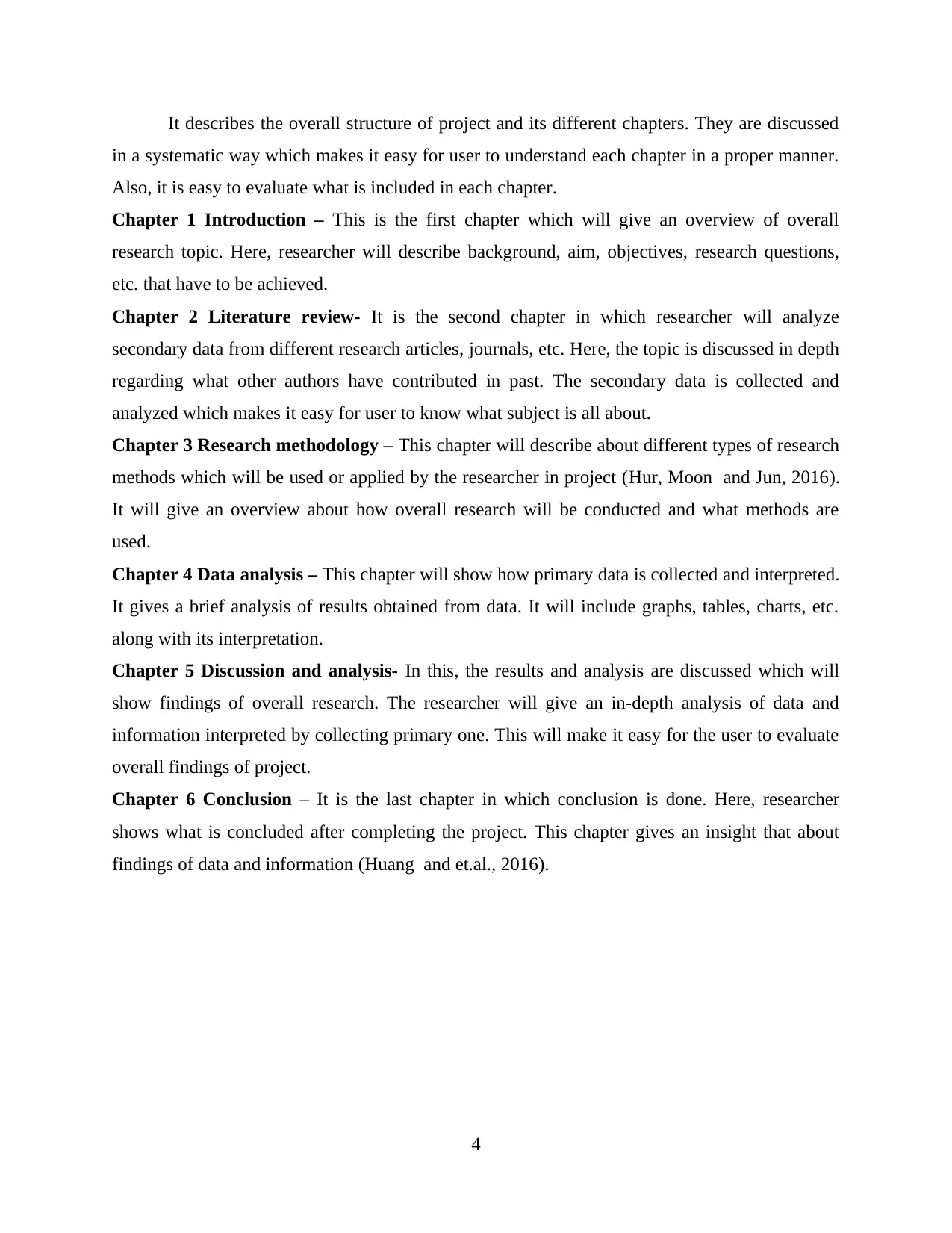
in a systematic way which makes it easy for user to understand each chapter in a proper manner.
Also, it is easy to evaluate what is included in each chapter.
Chapter 1 Introduction – This is the first chapter which will give an overview of overall
research topic. Here, researcher will describe background, aim, objectives, research questions,
etc. that have to be achieved.
Chapter 2 Literature review- It is the second chapter in which researcher will analyze
secondary data from different research articles, journals, etc. Here, the topic is discussed in depth
regarding what other authors have contributed in past. The secondary data is collected and
analyzed which makes it easy for user to know what subject is all about.
Chapter 3 Research methodology – This chapter will describe about different types of research
methods which will be used or applied by the researcher in project (Hur, Moon and Jun, 2016).
It will give an overview about how overall research will be conducted and what methods are
used.
Chapter 4 Data analysis – This chapter will show how primary data is collected and interpreted.
It gives a brief analysis of results obtained from data. It will include graphs, tables, charts, etc.
along with its interpretation.
Chapter 5 Discussion and analysis- In this, the results and analysis are discussed which will
show findings of overall research. The researcher will give an in-depth analysis of data and
information interpreted by collecting primary one. This will make it easy for the user to evaluate
overall findings of project.
Chapter 6 Conclusion – It is the last chapter in which conclusion is done. Here, researcher
shows what is concluded after completing the project. This chapter gives an insight that about
findings of data and information (Huang and et.al., 2016).
4

2.1 Definition of key terms
EMPLOYEE PERFORMANCE
Employee Performance indicates the behaviour of employees in workplace and how they
perform their jobs that employer has obligated them. Employee Performance refers to how well
employees conduct their job or duties that they are required to perform (Shields and et.al., 2015).
The organisation set standards or targets for every individual and hopes that their business offers
value products to the customer's & operates efficiently. Employee performance refers to the
employee’s behaviour at the workplace (Shields and et.al., 2015). Way in which employees are
performing their roles and responsibilities in respect to job is covered by the term employee
performance.
EMPLOYEE SATISFACTION
Employee Satisfaction also called as Job Satisfaction, an extent an employee enjoys their
job role and is happy & satisfied. Employee satisfaction reduce turnover and stress, both of them
impact the performance and productivity of employees. Employee Satisfactions shows that
whether workers are satisfied and fulfilling their needs at workplace. Employee satisfaction show
extent to which employee feel that current job is fulfilling its needs (Bin, 2015). Number of
factors affect employee satisfaction like hygiene factor and financial as well as non-financial
incentives.
EMPLOYEE MOTIVATION
Motivation is the efforts, energy & commitment that a employee brings to the
organisations through their job roles. It shows how committed an individual is to their job roles
and how engaged the individual feel to organisation's goals and objectives. Motivation is drive
from two factors internal and external sources. External sources are rewards and monetary
benefits and on the other hand internal sources like power, independence and acceptance
(Lăzăroiu, 2015).
Lack of employee satisfaction & employee motivation affects employee’s performance
and all of these overall cause organisational stress. Unsatisfied employee will be less productive
as they have no satisfaction and motivation to perform the task. Employee motivation refers the
extent to which individual is dedicated towards its job and intend to achieve target determined by
the managers (Lăzăroiu, 2015). There are number of approaches that are used by the managers to
5
⊘ This is a preview!⊘
Do you want full access?
Subscribe today to unlock all pages.

Trusted by 1+ million students worldwide

2.2 Evaluation of relevant models and theories
Herzberg factor theory
Herzberg theory state that there are multiple factors that motivate an individual to stay for
long time in the business firm. These factors can be classified in to two categories namely
motivator and hygiene theory. Motivator factor cover multiple things like recognition of
achievement, responsibility and opportunity to do something meaningful etc. On other hand,
hygiene factors cover job security, salary, fringe benefits, work conditions, good pay and
vacations etc. There are few one who are motivate by monetary benefits but there are few one
which are motivated by recognition and other factors which are not in monetary terms. Employee
to employee managers need to change use of motivation techniques.
According to Alshmemri, Shahwan-Akl and Maude, (2017) one of main merit of
Herzberg motivation theory is that it helps managers to work on multiple fronts through which
they can be motivated to work hard for benefits of an organization. On other hand Alfayad and
Arif, (2017) major demerit of Herzberg motivation theory is that it is subjective in nature. It
gives large number of options to the managers. Hence, they do not that which option can work to
solve problem. Thus, theory is assumed subjective by many individuals.
Model Variables Strength Weakness Studies
The Person-
Environmental
Fit Theory
Work
environment
Employee
mindset
Talents and the
capability of the
employee.
By employing
theory conflict
can be avoided
at the workplace.
The environment
is certain and the
behaviours or
the compatibility
level of the
employees can
change at any
time
Many studies
conducted in
manufacturing
firms where the
employees have
to face different
situations due to
change in the
work policies,
demands and
needs of the
clients
Job Demand Job desires Allow to People with low Most of the firms
6
Paraphrase This Document
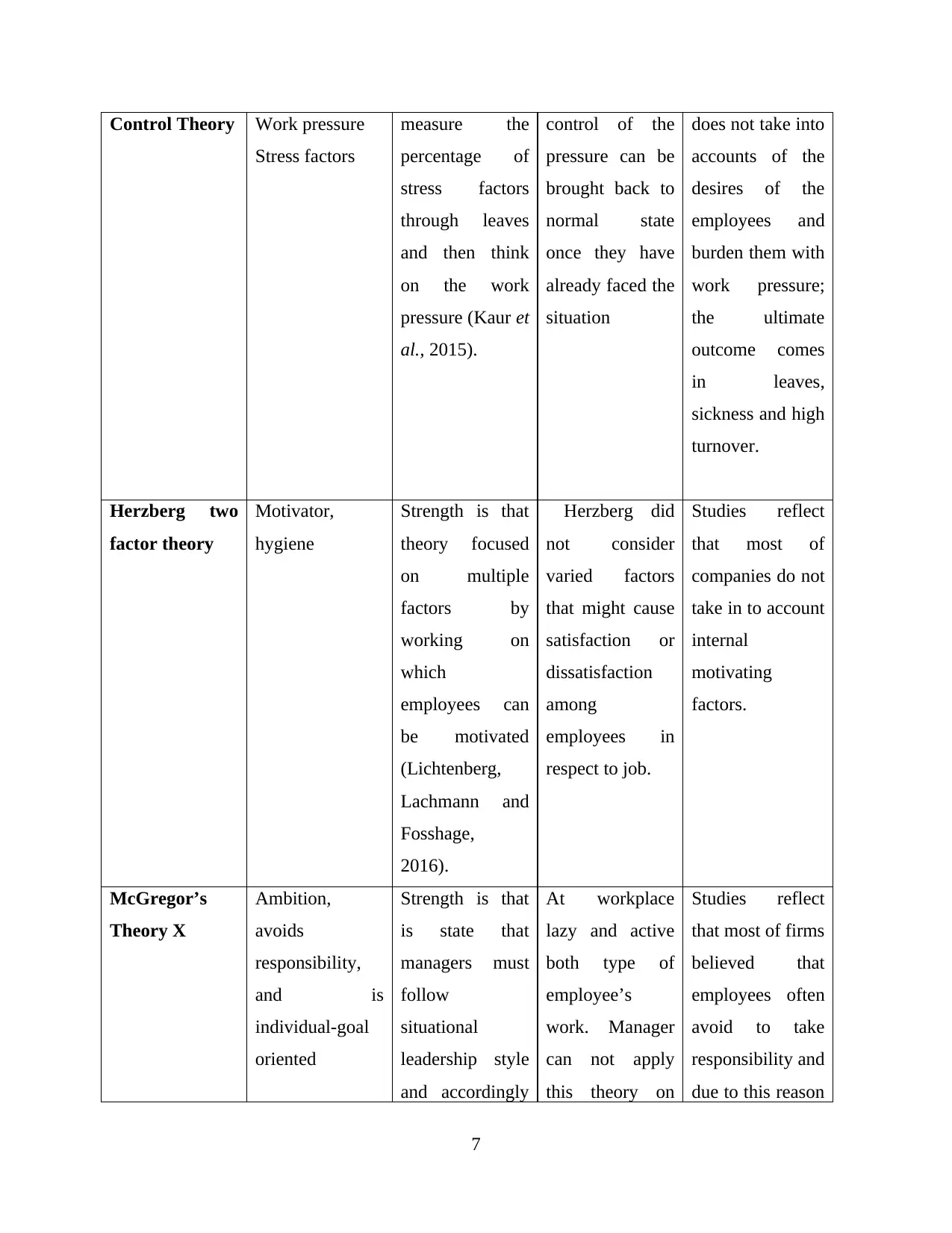
Stress factors
measure the
percentage of
stress factors
through leaves
and then think
on the work
pressure (Kaur et
al., 2015).
control of the
pressure can be
brought back to
normal state
once they have
already faced the
situation
does not take into
accounts of the
desires of the
employees and
burden them with
work pressure;
the ultimate
outcome comes
in leaves,
sickness and high
turnover.
Herzberg two
factor theory
Motivator,
hygiene
Strength is that
theory focused
on multiple
factors by
working on
which
employees can
be motivated
(Lichtenberg,
Lachmann and
Fosshage,
2016).
Herzberg did
not consider
varied factors
that might cause
satisfaction or
dissatisfaction
among
employees in
respect to job.
Studies reflect
that most of
companies do not
take in to account
internal
motivating
factors.
McGregor’s
Theory X
Ambition,
avoids
responsibility,
and is
individual-goal
oriented
Strength is that
is state that
managers must
follow
situational
leadership style
and accordingly
At workplace
lazy and active
both type of
employee’s
work. Manager
can not apply
this theory on
Studies reflect
that most of firms
believed that
employees often
avoid to take
responsibility and
due to this reason
7
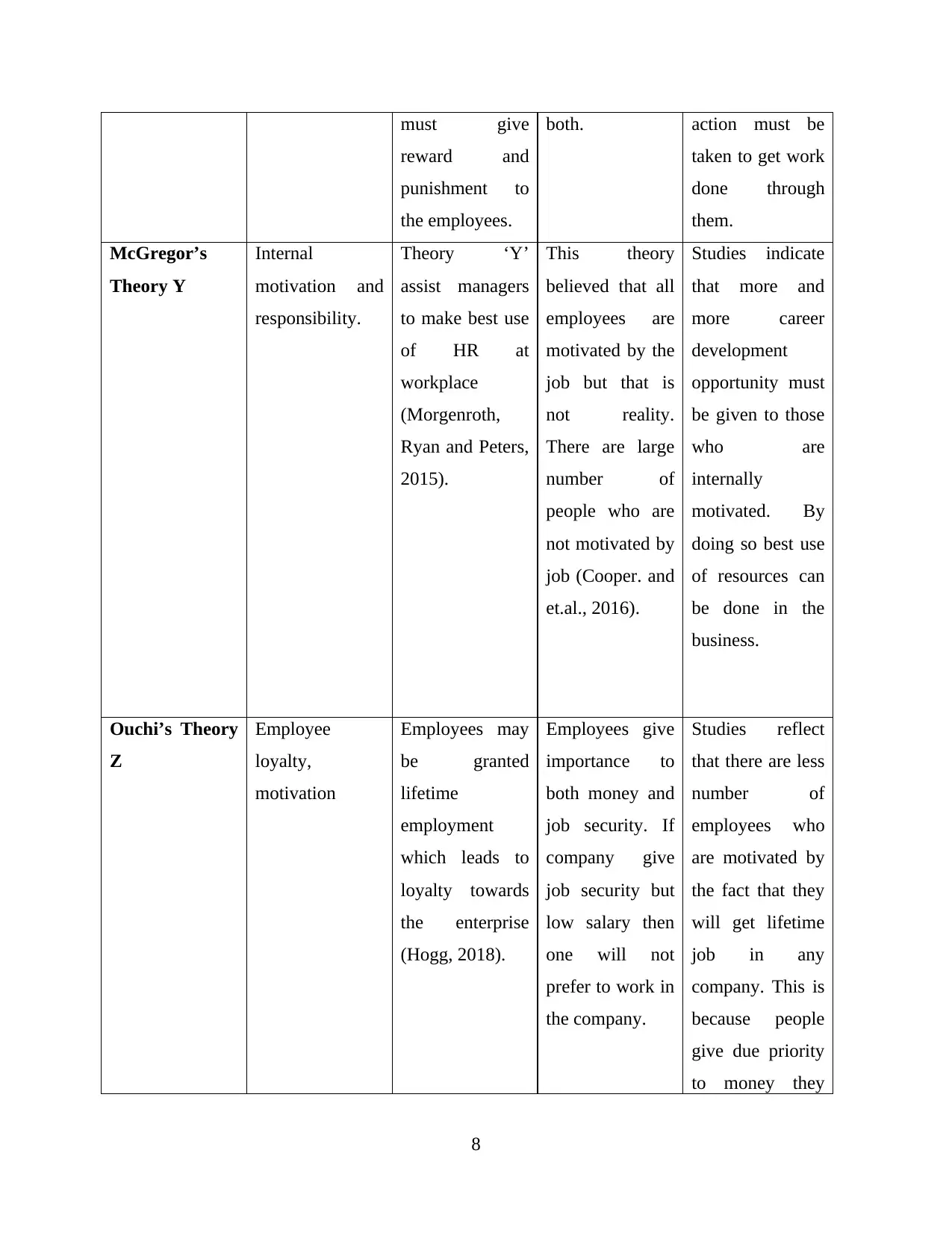
reward and
punishment to
the employees.
both. action must be
taken to get work
done through
them.
McGregor’s
Theory Y
Internal
motivation and
responsibility.
Theory ‘Y’
assist managers
to make best use
of HR at
workplace
(Morgenroth,
Ryan and Peters,
2015).
This theory
believed that all
employees are
motivated by the
job but that is
not reality.
There are large
number of
people who are
not motivated by
job (Cooper. and
et.al., 2016).
Studies indicate
that more and
more career
development
opportunity must
be given to those
who are
internally
motivated. By
doing so best use
of resources can
be done in the
business.
Ouchi’s Theory
Z
Employee
loyalty,
motivation
Employees may
be granted
lifetime
employment
which leads to
loyalty towards
the enterprise
(Hogg, 2018).
Employees give
importance to
both money and
job security. If
company give
job security but
low salary then
one will not
prefer to work in
the company.
Studies reflect
that there are less
number of
employees who
are motivated by
the fact that they
will get lifetime
job in any
company. This is
because people
give due priority
to money they
8
⊘ This is a preview!⊘
Do you want full access?
Subscribe today to unlock all pages.

Trusted by 1+ million students worldwide
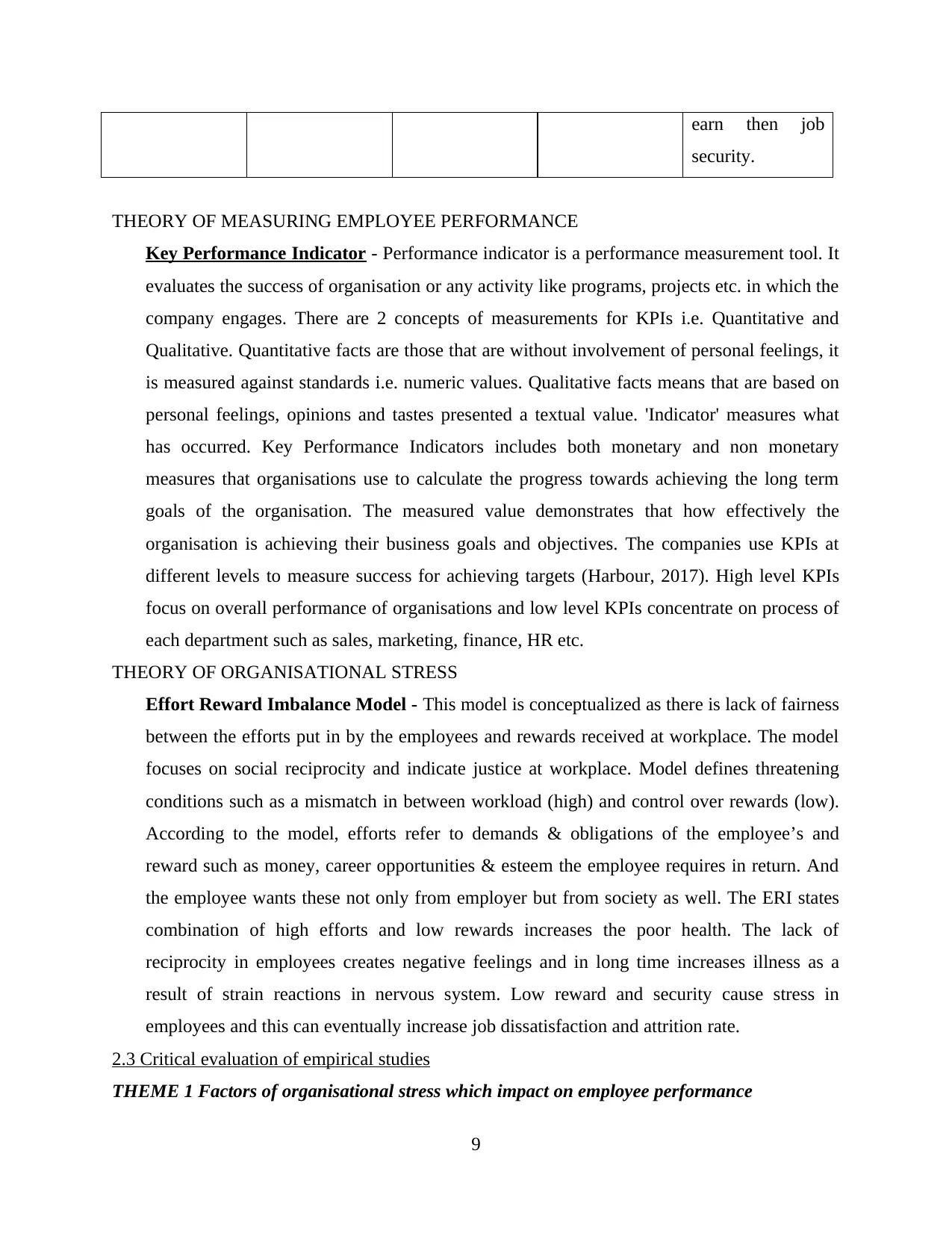
security.
THEORY OF MEASURING EMPLOYEE PERFORMANCE
Key Performance Indicator - Performance indicator is a performance measurement tool. It
evaluates the success of organisation or any activity like programs, projects etc. in which the
company engages. There are 2 concepts of measurements for KPIs i.e. Quantitative and
Qualitative. Quantitative facts are those that are without involvement of personal feelings, it
is measured against standards i.e. numeric values. Qualitative facts means that are based on
personal feelings, opinions and tastes presented a textual value. 'Indicator' measures what
has occurred. Key Performance Indicators includes both monetary and non monetary
measures that organisations use to calculate the progress towards achieving the long term
goals of the organisation. The measured value demonstrates that how effectively the
organisation is achieving their business goals and objectives. The companies use KPIs at
different levels to measure success for achieving targets (Harbour, 2017). High level KPIs
focus on overall performance of organisations and low level KPIs concentrate on process of
each department such as sales, marketing, finance, HR etc.
THEORY OF ORGANISATIONAL STRESS
Effort Reward Imbalance Model - This model is conceptualized as there is lack of fairness
between the efforts put in by the employees and rewards received at workplace. The model
focuses on social reciprocity and indicate justice at workplace. Model defines threatening
conditions such as a mismatch in between workload (high) and control over rewards (low).
According to the model, efforts refer to demands & obligations of the employee’s and
reward such as money, career opportunities & esteem the employee requires in return. And
the employee wants these not only from employer but from society as well. The ERI states
combination of high efforts and low rewards increases the poor health. The lack of
reciprocity in employees creates negative feelings and in long time increases illness as a
result of strain reactions in nervous system. Low reward and security cause stress in
employees and this can eventually increase job dissatisfaction and attrition rate.
2.3 Critical evaluation of empirical studies
THEME 1 Factors of organisational stress which impact on employee performance
9
Paraphrase This Document
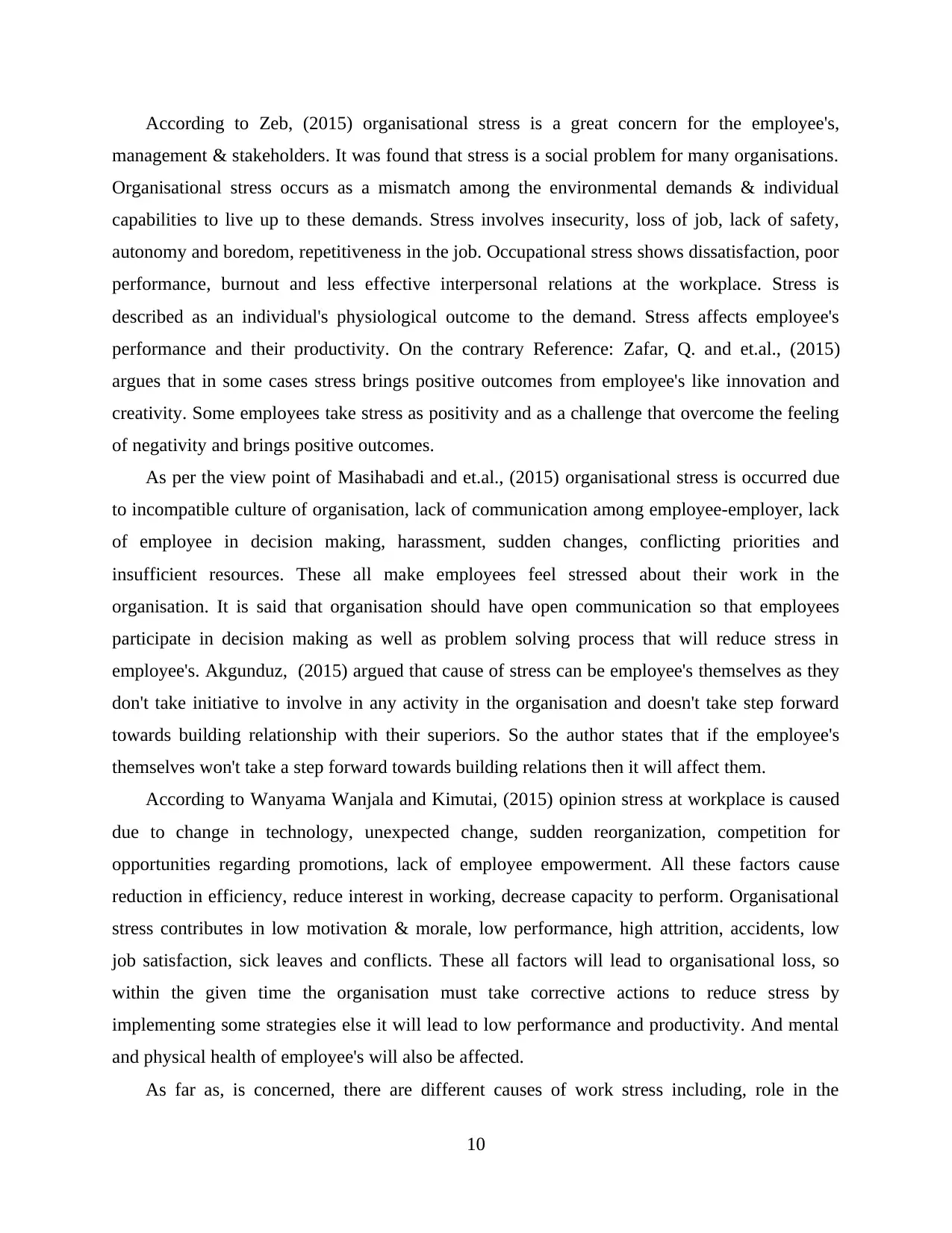
management & stakeholders. It was found that stress is a social problem for many organisations.
Organisational stress occurs as a mismatch among the environmental demands & individual
capabilities to live up to these demands. Stress involves insecurity, loss of job, lack of safety,
autonomy and boredom, repetitiveness in the job. Occupational stress shows dissatisfaction, poor
performance, burnout and less effective interpersonal relations at the workplace. Stress is
described as an individual's physiological outcome to the demand. Stress affects employee's
performance and their productivity. On the contrary Reference: Zafar, Q. and et.al., (2015)
argues that in some cases stress brings positive outcomes from employee's like innovation and
creativity. Some employees take stress as positivity and as a challenge that overcome the feeling
of negativity and brings positive outcomes.
As per the view point of Masihabadi and et.al., (2015) organisational stress is occurred due
to incompatible culture of organisation, lack of communication among employee-employer, lack
of employee in decision making, harassment, sudden changes, conflicting priorities and
insufficient resources. These all make employees feel stressed about their work in the
organisation. It is said that organisation should have open communication so that employees
participate in decision making as well as problem solving process that will reduce stress in
employee's. Akgunduz, (2015) argued that cause of stress can be employee's themselves as they
don't take initiative to involve in any activity in the organisation and doesn't take step forward
towards building relationship with their superiors. So the author states that if the employee's
themselves won't take a step forward towards building relations then it will affect them.
According to Wanyama Wanjala and Kimutai, (2015) opinion stress at workplace is caused
due to change in technology, unexpected change, sudden reorganization, competition for
opportunities regarding promotions, lack of employee empowerment. All these factors cause
reduction in efficiency, reduce interest in working, decrease capacity to perform. Organisational
stress contributes in low motivation & morale, low performance, high attrition, accidents, low
job satisfaction, sick leaves and conflicts. These all factors will lead to organisational loss, so
within the given time the organisation must take corrective actions to reduce stress by
implementing some strategies else it will lead to low performance and productivity. And mental
and physical health of employee's will also be affected.
As far as, is concerned, there are different causes of work stress including, role in the
10
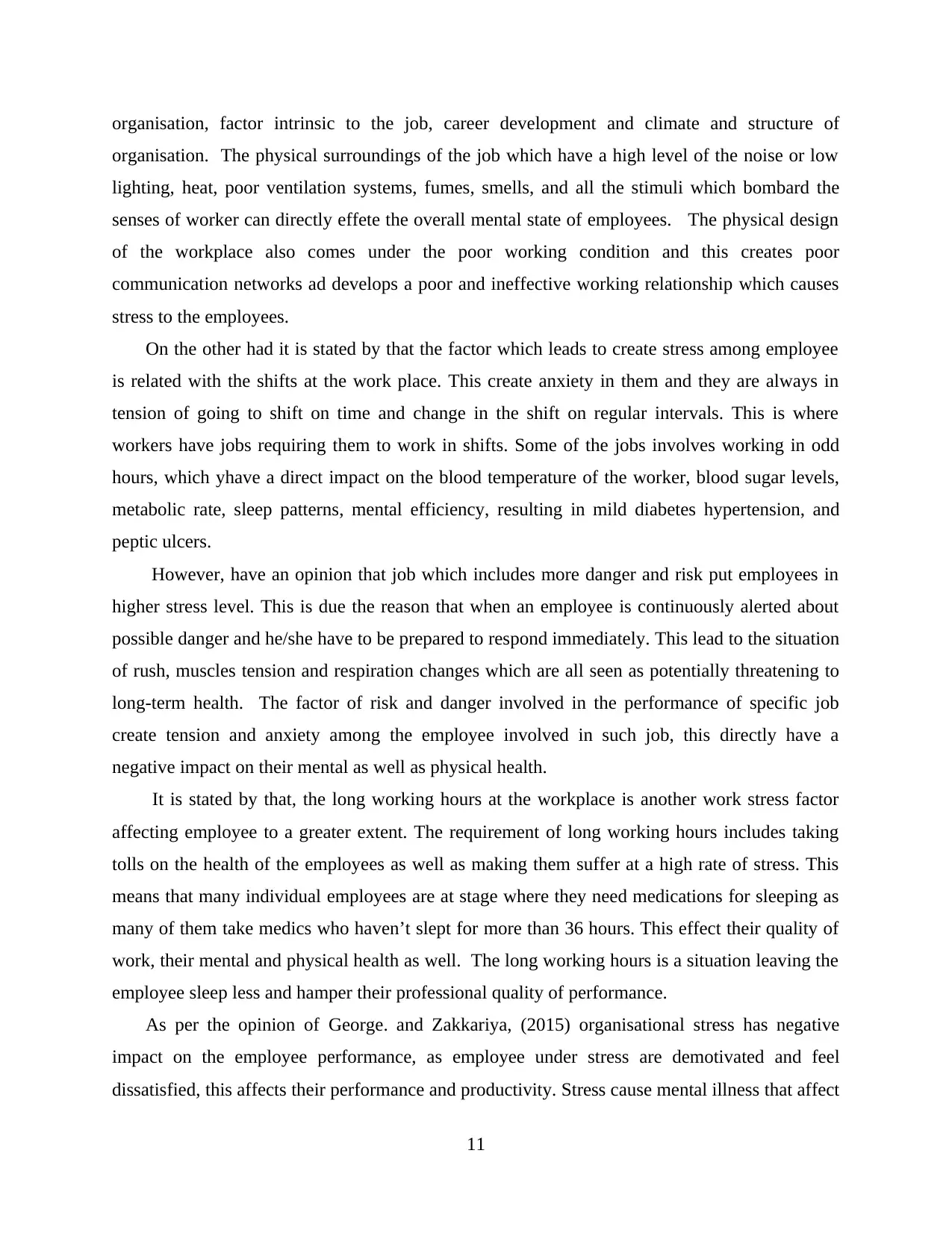
organisation. The physical surroundings of the job which have a high level of the noise or low
lighting, heat, poor ventilation systems, fumes, smells, and all the stimuli which bombard the
senses of worker can directly effete the overall mental state of employees. The physical design
of the workplace also comes under the poor working condition and this creates poor
communication networks ad develops a poor and ineffective working relationship which causes
stress to the employees.
On the other had it is stated by that the factor which leads to create stress among employee
is related with the shifts at the work place. This create anxiety in them and they are always in
tension of going to shift on time and change in the shift on regular intervals. This is where
workers have jobs requiring them to work in shifts. Some of the jobs involves working in odd
hours, which yhave a direct impact on the blood temperature of the worker, blood sugar levels,
metabolic rate, sleep patterns, mental efficiency, resulting in mild diabetes hypertension, and
peptic ulcers.
However, have an opinion that job which includes more danger and risk put employees in
higher stress level. This is due the reason that when an employee is continuously alerted about
possible danger and he/she have to be prepared to respond immediately. This lead to the situation
of rush, muscles tension and respiration changes which are all seen as potentially threatening to
long-term health. The factor of risk and danger involved in the performance of specific job
create tension and anxiety among the employee involved in such job, this directly have a
negative impact on their mental as well as physical health.
It is stated by that, the long working hours at the workplace is another work stress factor
affecting employee to a greater extent. The requirement of long working hours includes taking
tolls on the health of the employees as well as making them suffer at a high rate of stress. This
means that many individual employees are at stage where they need medications for sleeping as
many of them take medics who haven’t slept for more than 36 hours. This effect their quality of
work, their mental and physical health as well. The long working hours is a situation leaving the
employee sleep less and hamper their professional quality of performance.
As per the opinion of George. and Zakkariya, (2015) organisational stress has negative
impact on the employee performance, as employee under stress are demotivated and feel
dissatisfied, this affects their performance and productivity. Stress cause mental illness that affect
11
⊘ This is a preview!⊘
Do you want full access?
Subscribe today to unlock all pages.

Trusted by 1+ million students worldwide
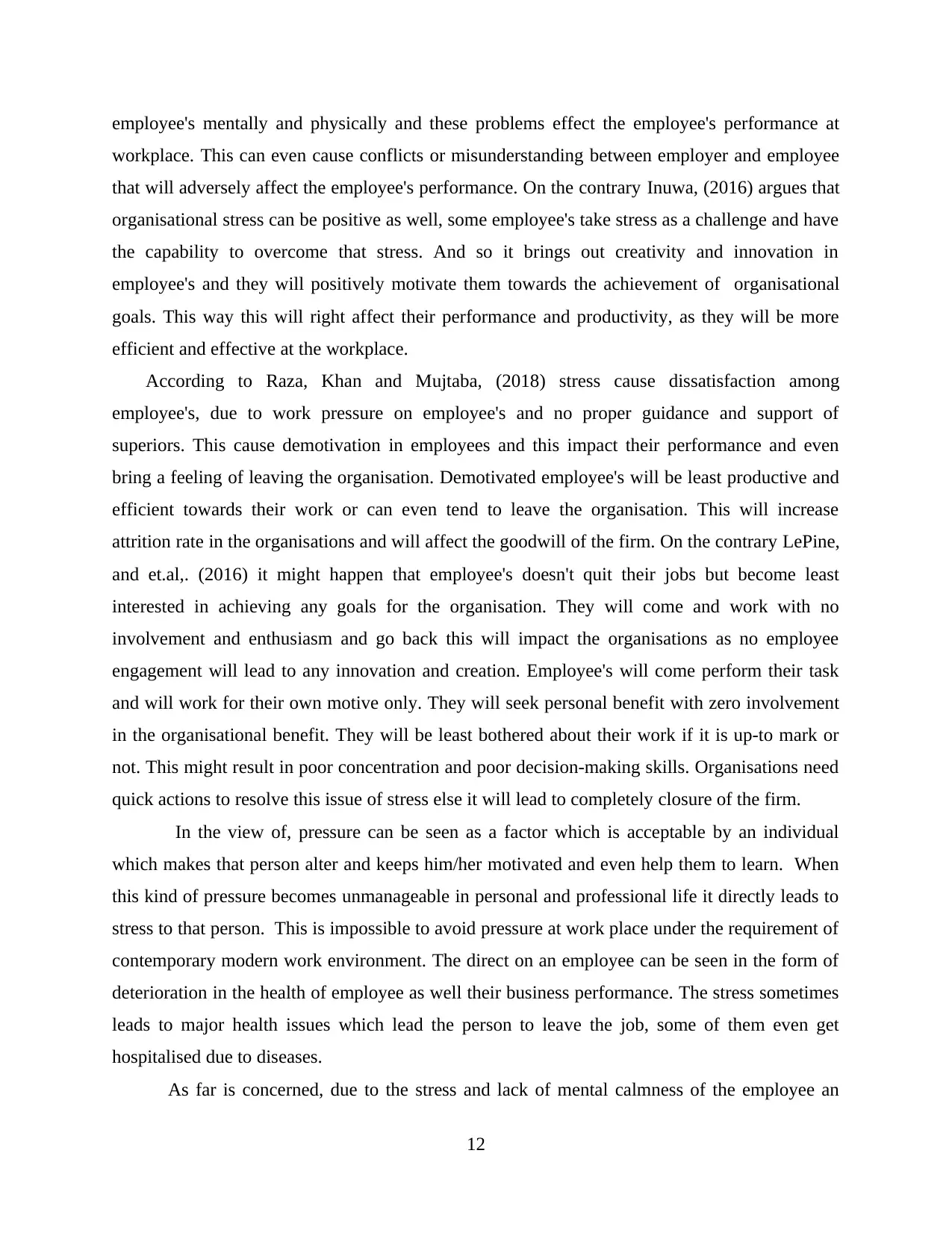
workplace. This can even cause conflicts or misunderstanding between employer and employee
that will adversely affect the employee's performance. On the contrary Inuwa, (2016) argues that
organisational stress can be positive as well, some employee's take stress as a challenge and have
the capability to overcome that stress. And so it brings out creativity and innovation in
employee's and they will positively motivate them towards the achievement of organisational
goals. This way this will right affect their performance and productivity, as they will be more
efficient and effective at the workplace.
According to Raza, Khan and Mujtaba, (2018) stress cause dissatisfaction among
employee's, due to work pressure on employee's and no proper guidance and support of
superiors. This cause demotivation in employees and this impact their performance and even
bring a feeling of leaving the organisation. Demotivated employee's will be least productive and
efficient towards their work or can even tend to leave the organisation. This will increase
attrition rate in the organisations and will affect the goodwill of the firm. On the contrary LePine,
and et.al,. (2016) it might happen that employee's doesn't quit their jobs but become least
interested in achieving any goals for the organisation. They will come and work with no
involvement and enthusiasm and go back this will impact the organisations as no employee
engagement will lead to any innovation and creation. Employee's will come perform their task
and will work for their own motive only. They will seek personal benefit with zero involvement
in the organisational benefit. They will be least bothered about their work if it is up-to mark or
not. This might result in poor concentration and poor decision-making skills. Organisations need
quick actions to resolve this issue of stress else it will lead to completely closure of the firm.
In the view of, pressure can be seen as a factor which is acceptable by an individual
which makes that person alter and keeps him/her motivated and even help them to learn. When
this kind of pressure becomes unmanageable in personal and professional life it directly leads to
stress to that person. This is impossible to avoid pressure at work place under the requirement of
contemporary modern work environment. The direct on an employee can be seen in the form of
deterioration in the health of employee as well their business performance. The stress sometimes
leads to major health issues which lead the person to leave the job, some of them even get
hospitalised due to diseases.
As far is concerned, due to the stress and lack of mental calmness of the employee an
12
Paraphrase This Document
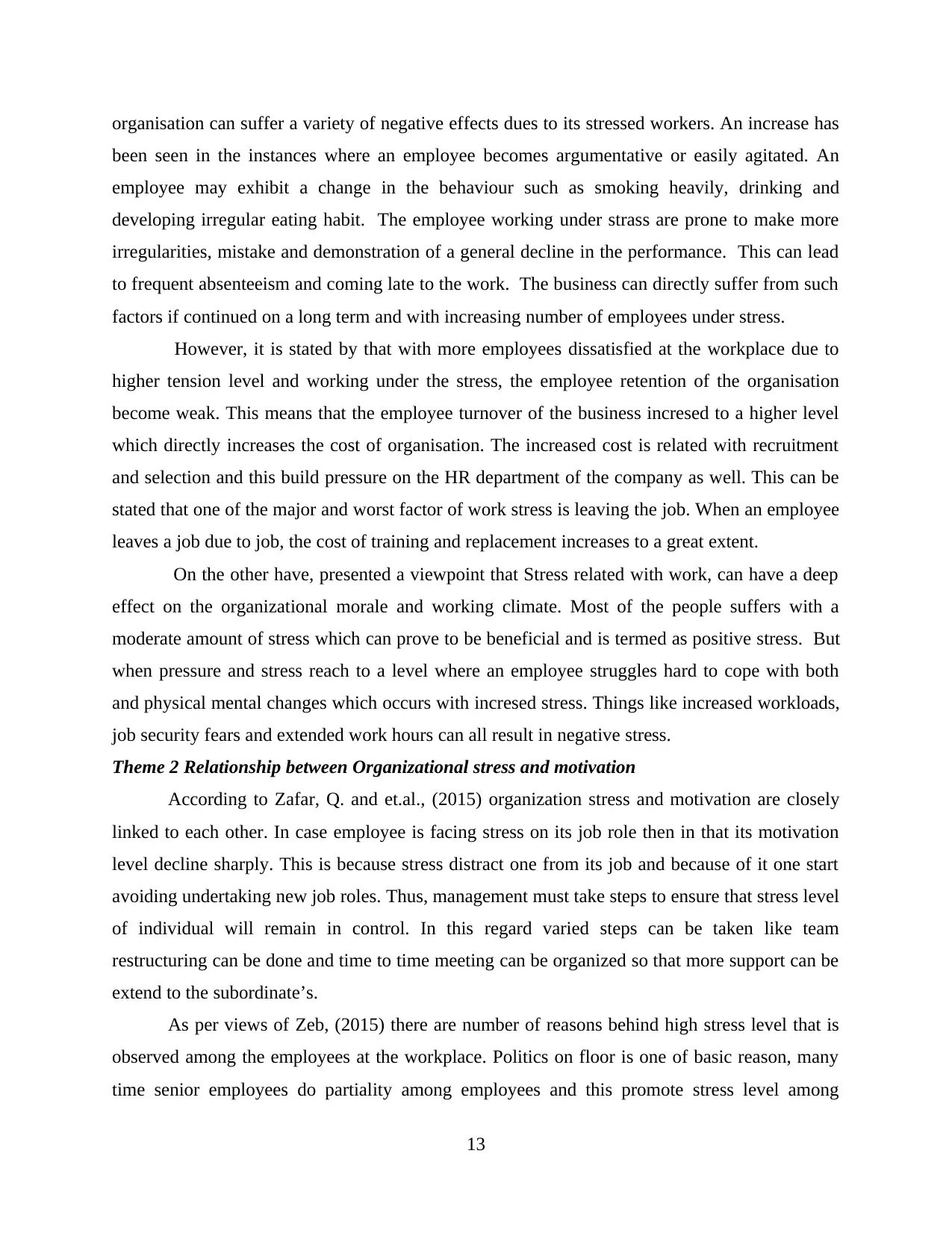
been seen in the instances where an employee becomes argumentative or easily agitated. An
employee may exhibit a change in the behaviour such as smoking heavily, drinking and
developing irregular eating habit. The employee working under strass are prone to make more
irregularities, mistake and demonstration of a general decline in the performance. This can lead
to frequent absenteeism and coming late to the work. The business can directly suffer from such
factors if continued on a long term and with increasing number of employees under stress.
However, it is stated by that with more employees dissatisfied at the workplace due to
higher tension level and working under the stress, the employee retention of the organisation
become weak. This means that the employee turnover of the business incresed to a higher level
which directly increases the cost of organisation. The increased cost is related with recruitment
and selection and this build pressure on the HR department of the company as well. This can be
stated that one of the major and worst factor of work stress is leaving the job. When an employee
leaves a job due to job, the cost of training and replacement increases to a great extent.
On the other have, presented a viewpoint that Stress related with work, can have a deep
effect on the organizational morale and working climate. Most of the people suffers with a
moderate amount of stress which can prove to be beneficial and is termed as positive stress. But
when pressure and stress reach to a level where an employee struggles hard to cope with both
and physical mental changes which occurs with incresed stress. Things like increased workloads,
job security fears and extended work hours can all result in negative stress.
Theme 2 Relationship between Organizational stress and motivation
According to Zafar, Q. and et.al., (2015) organization stress and motivation are closely
linked to each other. In case employee is facing stress on its job role then in that its motivation
level decline sharply. This is because stress distract one from its job and because of it one start
avoiding undertaking new job roles. Thus, management must take steps to ensure that stress level
of individual will remain in control. In this regard varied steps can be taken like team
restructuring can be done and time to time meeting can be organized so that more support can be
extend to the subordinate’s.
As per views of Zeb, (2015) there are number of reasons behind high stress level that is
observed among the employees at the workplace. Politics on floor is one of basic reason, many
time senior employees do partiality among employees and this promote stress level among
13
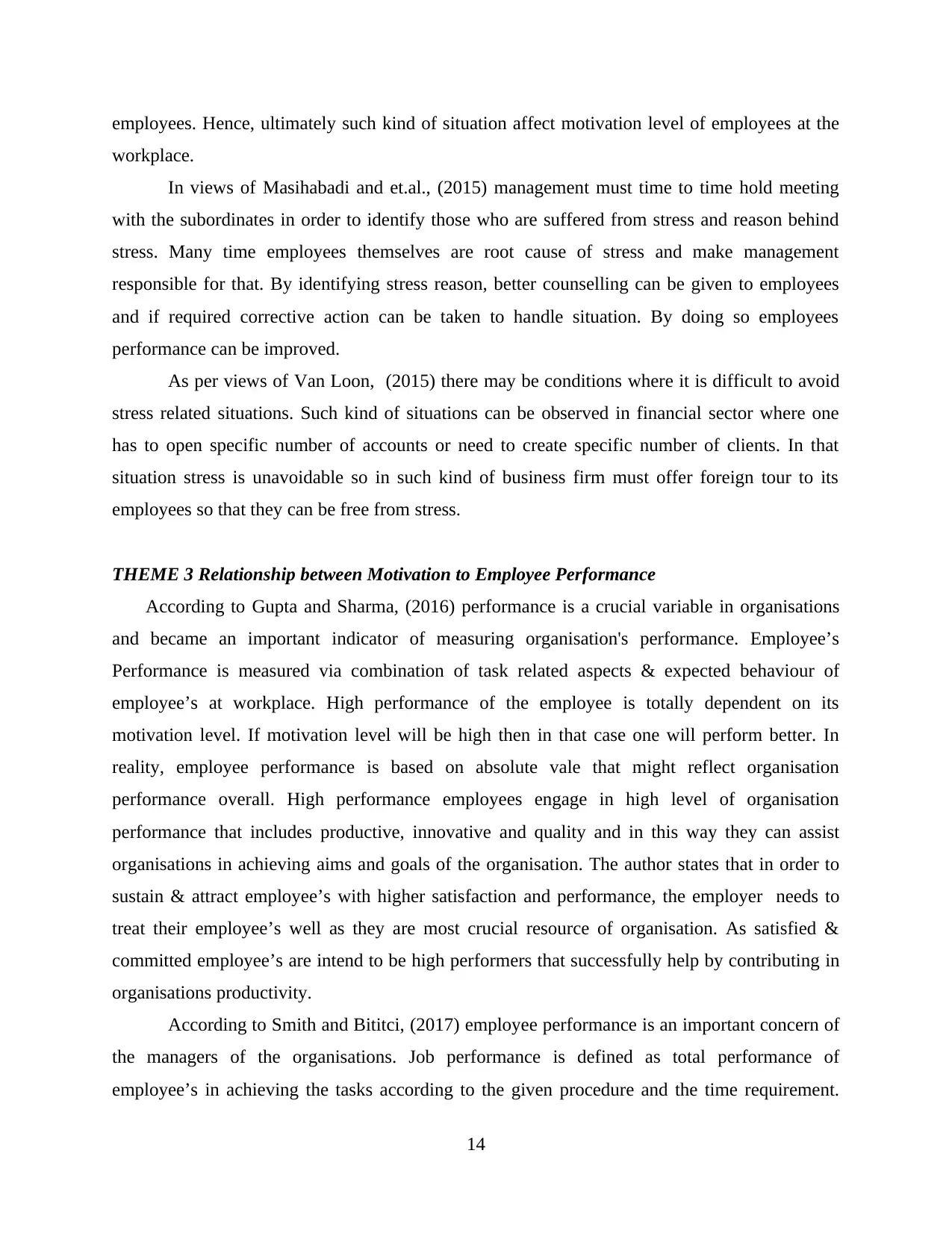
workplace.
In views of Masihabadi and et.al., (2015) management must time to time hold meeting
with the subordinates in order to identify those who are suffered from stress and reason behind
stress. Many time employees themselves are root cause of stress and make management
responsible for that. By identifying stress reason, better counselling can be given to employees
and if required corrective action can be taken to handle situation. By doing so employees
performance can be improved.
As per views of Van Loon, (2015) there may be conditions where it is difficult to avoid
stress related situations. Such kind of situations can be observed in financial sector where one
has to open specific number of accounts or need to create specific number of clients. In that
situation stress is unavoidable so in such kind of business firm must offer foreign tour to its
employees so that they can be free from stress.
THEME 3 Relationship between Motivation to Employee Performance
According to Gupta and Sharma, (2016) performance is a crucial variable in organisations
and became an important indicator of measuring organisation's performance. Employee’s
Performance is measured via combination of task related aspects & expected behaviour of
employee’s at workplace. High performance of the employee is totally dependent on its
motivation level. If motivation level will be high then in that case one will perform better. In
reality, employee performance is based on absolute vale that might reflect organisation
performance overall. High performance employees engage in high level of organisation
performance that includes productive, innovative and quality and in this way they can assist
organisations in achieving aims and goals of the organisation. The author states that in order to
sustain & attract employee’s with higher satisfaction and performance, the employer needs to
treat their employee’s well as they are most crucial resource of organisation. As satisfied &
committed employee’s are intend to be high performers that successfully help by contributing in
organisations productivity.
According to Smith and Bititci, (2017) employee performance is an important concern of
the managers of the organisations. Job performance is defined as total performance of
employee’s in achieving the tasks according to the given procedure and the time requirement.
14
⊘ This is a preview!⊘
Do you want full access?
Subscribe today to unlock all pages.

Trusted by 1+ million students worldwide

motivation is high employee performance will be good. According to the authors employee
performance is based on individual's own reactions and behaviour. High performance employees
bring innovation in the firms that helps the organisation in increasing their profits. Performance
of employees depends on the atmosphere at workplace, employee-employer relationship, relation
with boss, compensation, engagement of employees are factors that determine performance.
Wati Halim and Zainal, (2015) as far as is concerned every organisation have established
certain objectives to achieve. These objectives of the organisations can be achieved through
utilization of organisational resources like men, material and machine and money. It is these
goals and objectives which motivate one to hard work. All of these resources are used by the
organisation as an important aspect of accomplishment of the goals. Availability of sufficient
amount of resources play vital role in motivating one to work hard. One of the important factors
in accomplishment of goals of the organisation is the manpower. It depends on the manpower
that how they utilise other resources of the organisation. Employee performs different jobs in
business enterprise depending on the nature of organisation. This means that depending on the
nature of work a person does, reflects directly on how that employee performs in the job given.
Li, Y. and et.al., (2015) however, it is critiqued by that, employee performance is a concept
which is related with the evaluation of the task performed by an employee in the organisation
assigned to him/her. The performance of an employee is analysis of the employee behaviour in
relation to the overall organisational performance which it can manifest in different ways. These
three ways includes, individual task performed, organisational citizen behaviour and the
workplace deviant behaviour. The effective performance of an employee add tremendous value
to the organisation and no value is added to the business when the performance of its employee
is not good.
Omollo and Oloko, (2015) stated by that, every employee makes individual contribution
towards the performance of than organisational unit and thus to the whole of the business as
well. If each employee will be fully motivated then overall organization will grow at fast pace.
When the performance of organisational unit or individual employee falls behind for a starched
time period because of less motivation then this will directly lead to reorganisation or
redundancy in the business. In the present time where the competitive environment exists, which
is also very fierce then ever the importance of continuous effective performance of employee has
15
Paraphrase This Document
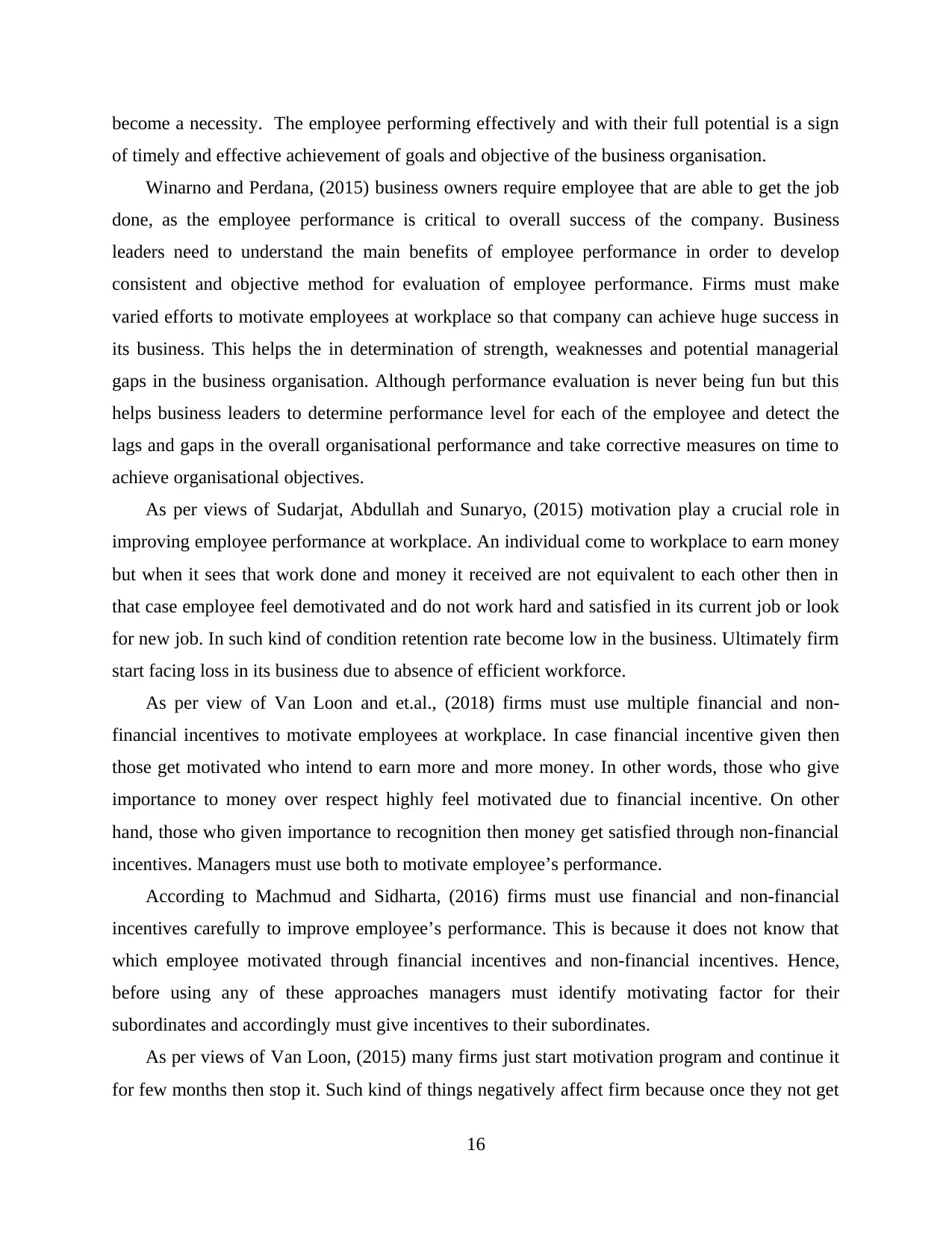
of timely and effective achievement of goals and objective of the business organisation.
Winarno and Perdana, (2015) business owners require employee that are able to get the job
done, as the employee performance is critical to overall success of the company. Business
leaders need to understand the main benefits of employee performance in order to develop
consistent and objective method for evaluation of employee performance. Firms must make
varied efforts to motivate employees at workplace so that company can achieve huge success in
its business. This helps the in determination of strength, weaknesses and potential managerial
gaps in the business organisation. Although performance evaluation is never being fun but this
helps business leaders to determine performance level for each of the employee and detect the
lags and gaps in the overall organisational performance and take corrective measures on time to
achieve organisational objectives.
As per views of Sudarjat, Abdullah and Sunaryo, (2015) motivation play a crucial role in
improving employee performance at workplace. An individual come to workplace to earn money
but when it sees that work done and money it received are not equivalent to each other then in
that case employee feel demotivated and do not work hard and satisfied in its current job or look
for new job. In such kind of condition retention rate become low in the business. Ultimately firm
start facing loss in its business due to absence of efficient workforce.
As per view of Van Loon and et.al., (2018) firms must use multiple financial and non-
financial incentives to motivate employees at workplace. In case financial incentive given then
those get motivated who intend to earn more and more money. In other words, those who give
importance to money over respect highly feel motivated due to financial incentive. On other
hand, those who given importance to recognition then money get satisfied through non-financial
incentives. Managers must use both to motivate employee’s performance.
According to Machmud and Sidharta, (2016) firms must use financial and non-financial
incentives carefully to improve employee’s performance. This is because it does not know that
which employee motivated through financial incentives and non-financial incentives. Hence,
before using any of these approaches managers must identify motivating factor for their
subordinates and accordingly must give incentives to their subordinates.
As per views of Van Loon, (2015) many firms just start motivation program and continue it
for few months then stop it. Such kind of things negatively affect firm because once they not get
16
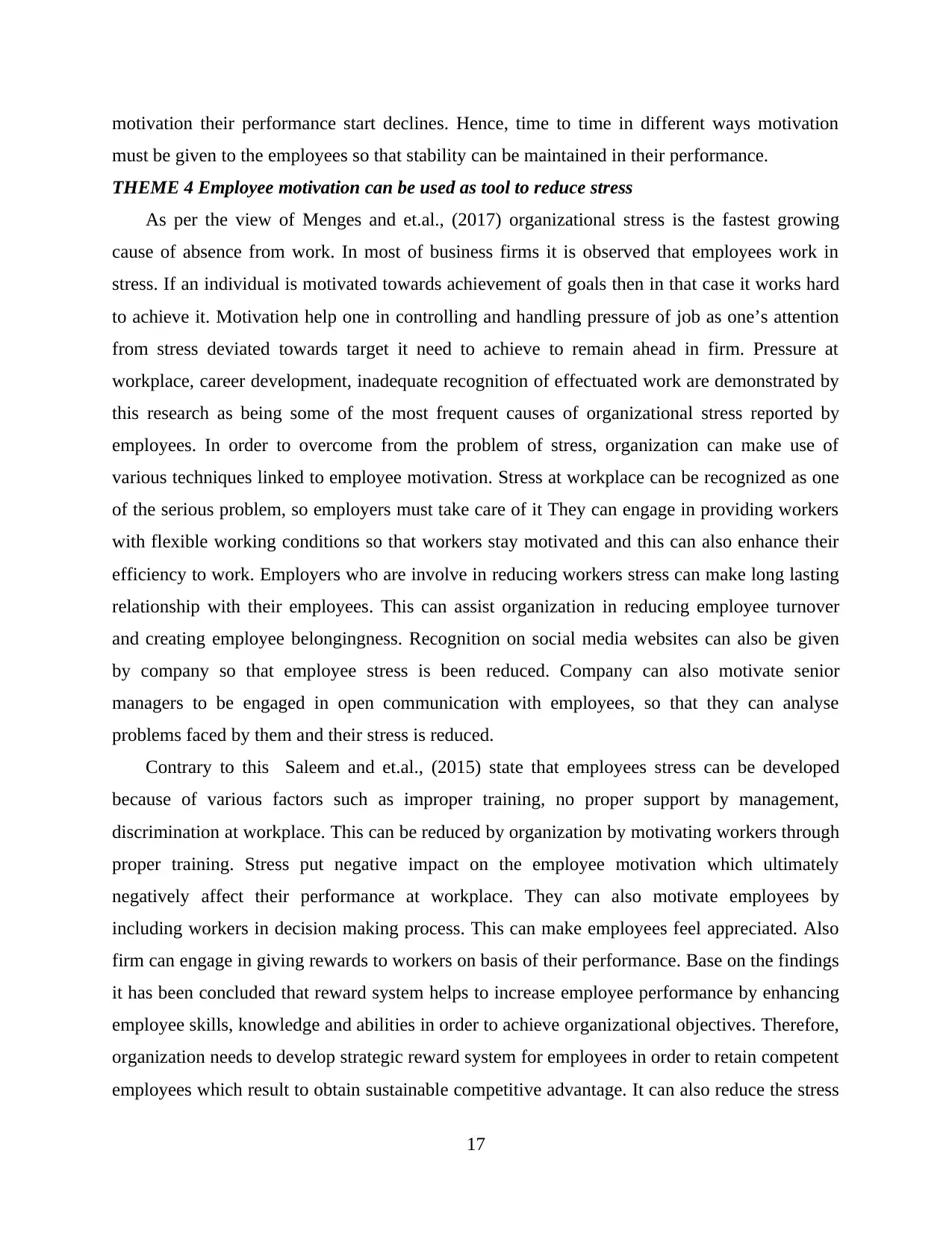
must be given to the employees so that stability can be maintained in their performance.
THEME 4 Employee motivation can be used as tool to reduce stress
As per the view of Menges and et.al., (2017) organizational stress is the fastest growing
cause of absence from work. In most of business firms it is observed that employees work in
stress. If an individual is motivated towards achievement of goals then in that case it works hard
to achieve it. Motivation help one in controlling and handling pressure of job as one’s attention
from stress deviated towards target it need to achieve to remain ahead in firm. Pressure at
workplace, career development, inadequate recognition of effectuated work are demonstrated by
this research as being some of the most frequent causes of organizational stress reported by
employees. In order to overcome from the problem of stress, organization can make use of
various techniques linked to employee motivation. Stress at workplace can be recognized as one
of the serious problem, so employers must take care of it They can engage in providing workers
with flexible working conditions so that workers stay motivated and this can also enhance their
efficiency to work. Employers who are involve in reducing workers stress can make long lasting
relationship with their employees. This can assist organization in reducing employee turnover
and creating employee belongingness. Recognition on social media websites can also be given
by company so that employee stress is been reduced. Company can also motivate senior
managers to be engaged in open communication with employees, so that they can analyse
problems faced by them and their stress is reduced.
Contrary to this Saleem and et.al., (2015) state that employees stress can be developed
because of various factors such as improper training, no proper support by management,
discrimination at workplace. This can be reduced by organization by motivating workers through
proper training. Stress put negative impact on the employee motivation which ultimately
negatively affect their performance at workplace. They can also motivate employees by
including workers in decision making process. This can make employees feel appreciated. Also
firm can engage in giving rewards to workers on basis of their performance. Base on the findings
it has been concluded that reward system helps to increase employee performance by enhancing
employee skills, knowledge and abilities in order to achieve organizational objectives. Therefore,
organization needs to develop strategic reward system for employees in order to retain competent
employees which result to obtain sustainable competitive advantage. It can also reduce the stress
17
⊘ This is a preview!⊘
Do you want full access?
Subscribe today to unlock all pages.

Trusted by 1+ million students worldwide
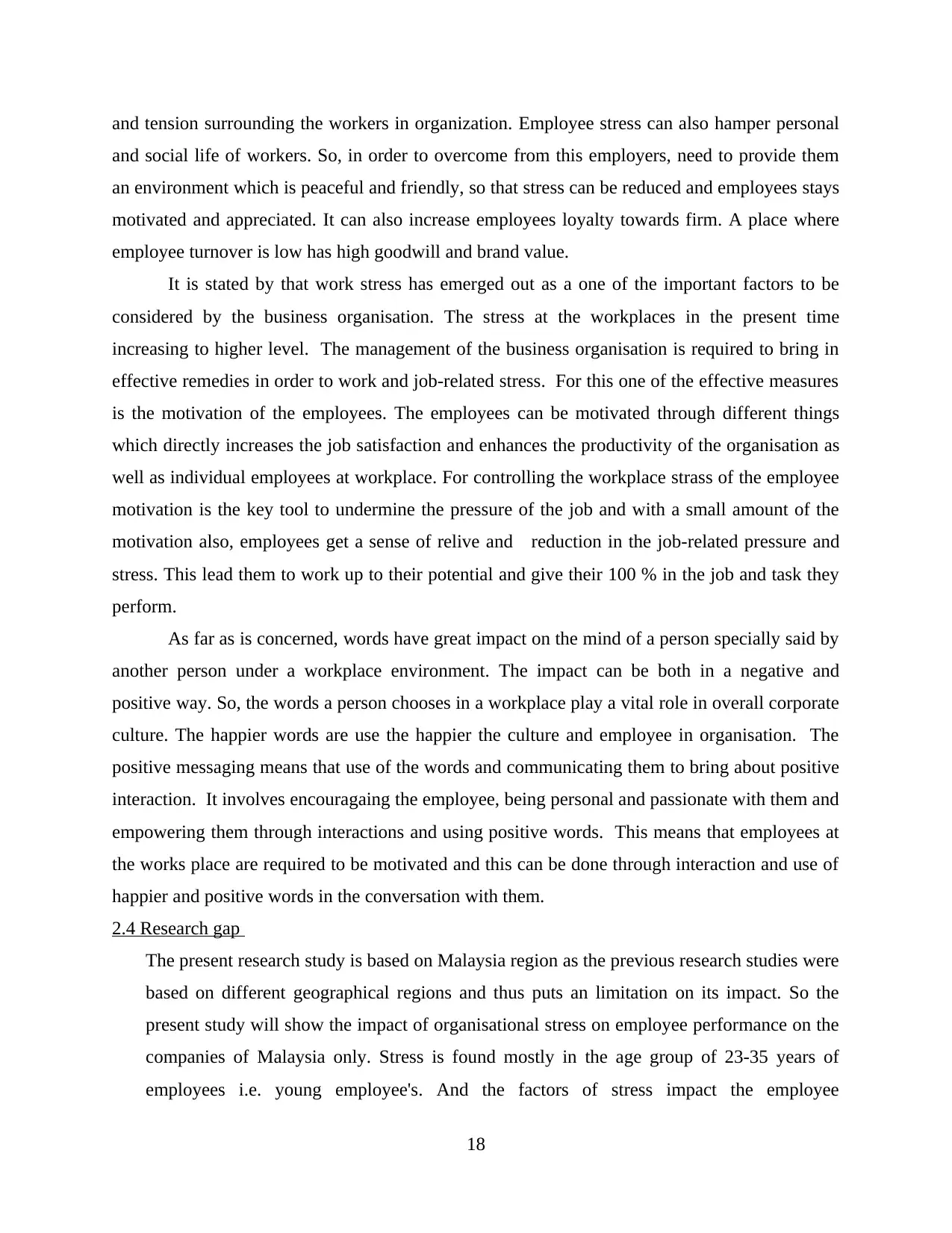
and social life of workers. So, in order to overcome from this employers, need to provide them
an environment which is peaceful and friendly, so that stress can be reduced and employees stays
motivated and appreciated. It can also increase employees loyalty towards firm. A place where
employee turnover is low has high goodwill and brand value.
It is stated by that work stress has emerged out as a one of the important factors to be
considered by the business organisation. The stress at the workplaces in the present time
increasing to higher level. The management of the business organisation is required to bring in
effective remedies in order to work and job-related stress. For this one of the effective measures
is the motivation of the employees. The employees can be motivated through different things
which directly increases the job satisfaction and enhances the productivity of the organisation as
well as individual employees at workplace. For controlling the workplace strass of the employee
motivation is the key tool to undermine the pressure of the job and with a small amount of the
motivation also, employees get a sense of relive and reduction in the job-related pressure and
stress. This lead them to work up to their potential and give their 100 % in the job and task they
perform.
As far as is concerned, words have great impact on the mind of a person specially said by
another person under a workplace environment. The impact can be both in a negative and
positive way. So, the words a person chooses in a workplace play a vital role in overall corporate
culture. The happier words are use the happier the culture and employee in organisation. The
positive messaging means that use of the words and communicating them to bring about positive
interaction. It involves encouragaing the employee, being personal and passionate with them and
empowering them through interactions and using positive words. This means that employees at
the works place are required to be motivated and this can be done through interaction and use of
happier and positive words in the conversation with them.
2.4 Research gap
The present research study is based on Malaysia region as the previous research studies were
based on different geographical regions and thus puts an limitation on its impact. So the
present study will show the impact of organisational stress on employee performance on the
companies of Malaysia only. Stress is found mostly in the age group of 23-35 years of
employees i.e. young employee's. And the factors of stress impact the employee
18
Paraphrase This Document
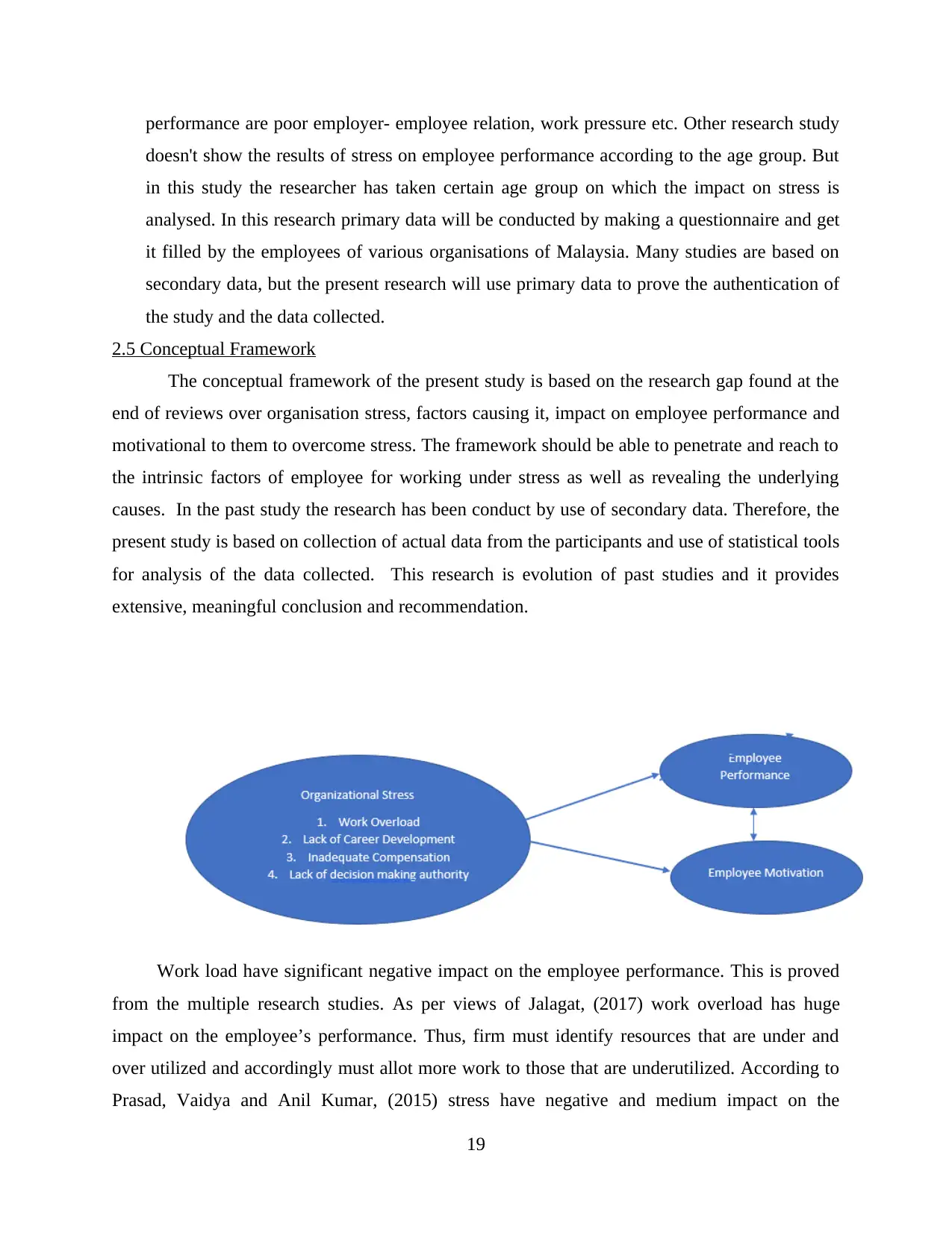
doesn't show the results of stress on employee performance according to the age group. But
in this study the researcher has taken certain age group on which the impact on stress is
analysed. In this research primary data will be conducted by making a questionnaire and get
it filled by the employees of various organisations of Malaysia. Many studies are based on
secondary data, but the present research will use primary data to prove the authentication of
the study and the data collected.
2.5 Conceptual Framework
The conceptual framework of the present study is based on the research gap found at the
end of reviews over organisation stress, factors causing it, impact on employee performance and
motivational to them to overcome stress. The framework should be able to penetrate and reach to
the intrinsic factors of employee for working under stress as well as revealing the underlying
causes. In the past study the research has been conduct by use of secondary data. Therefore, the
present study is based on collection of actual data from the participants and use of statistical tools
for analysis of the data collected. This research is evolution of past studies and it provides
extensive, meaningful conclusion and recommendation.
Work load have significant negative impact on the employee performance. This is proved
from the multiple research studies. As per views of Jalagat, (2017) work overload has huge
impact on the employee’s performance. Thus, firm must identify resources that are under and
over utilized and accordingly must allot more work to those that are underutilized. According to
Prasad, Vaidya and Anil Kumar, (2015) stress have negative and medium impact on the
19
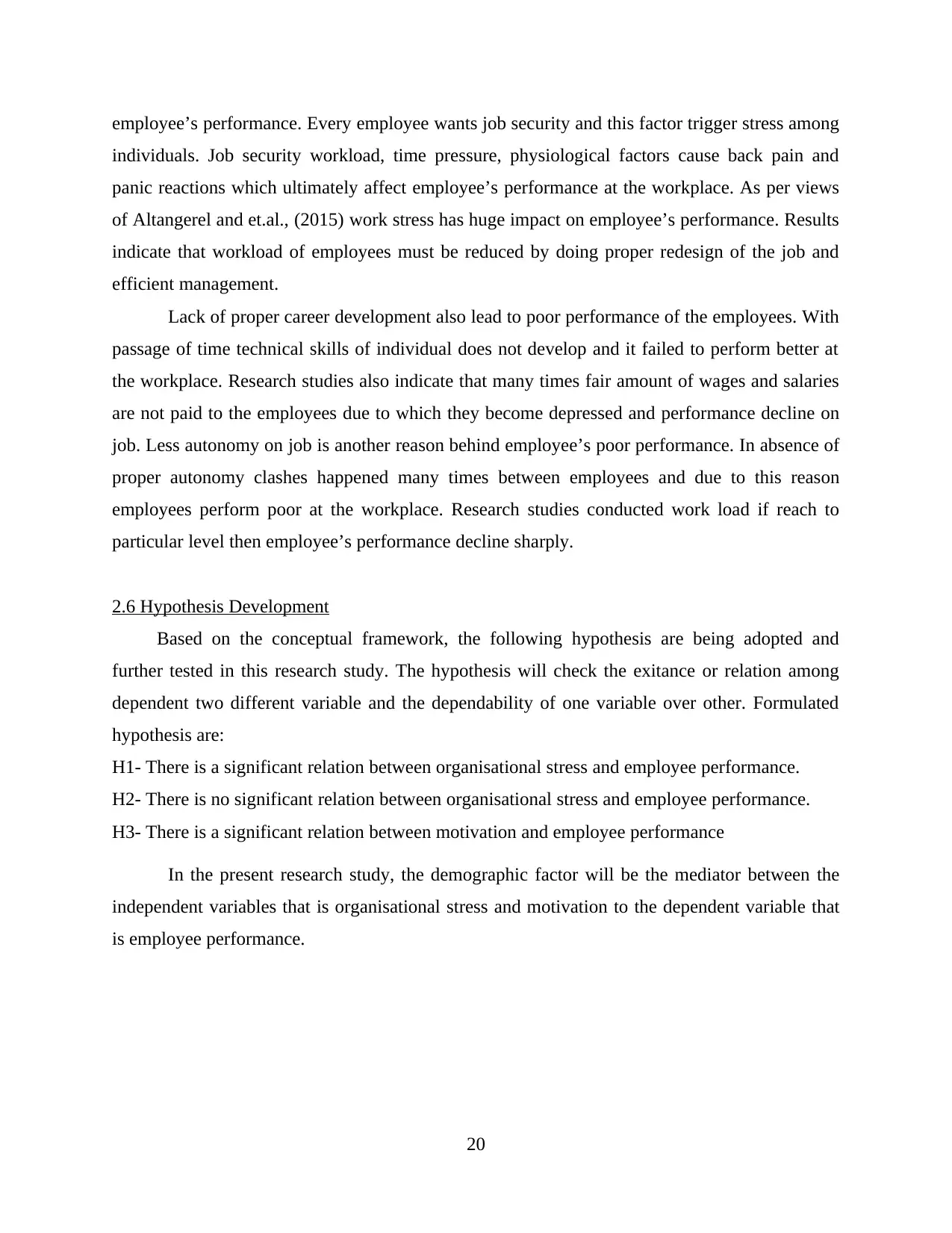
individuals. Job security workload, time pressure, physiological factors cause back pain and
panic reactions which ultimately affect employee’s performance at the workplace. As per views
of Altangerel and et.al., (2015) work stress has huge impact on employee’s performance. Results
indicate that workload of employees must be reduced by doing proper redesign of the job and
efficient management.
Lack of proper career development also lead to poor performance of the employees. With
passage of time technical skills of individual does not develop and it failed to perform better at
the workplace. Research studies also indicate that many times fair amount of wages and salaries
are not paid to the employees due to which they become depressed and performance decline on
job. Less autonomy on job is another reason behind employee’s poor performance. In absence of
proper autonomy clashes happened many times between employees and due to this reason
employees perform poor at the workplace. Research studies conducted work load if reach to
particular level then employee’s performance decline sharply.
2.6 Hypothesis Development
Based on the conceptual framework, the following hypothesis are being adopted and
further tested in this research study. The hypothesis will check the exitance or relation among
dependent two different variable and the dependability of one variable over other. Formulated
hypothesis are:
H1- There is a significant relation between organisational stress and employee performance.
H2- There is no significant relation between organisational stress and employee performance.
H3- There is a significant relation between motivation and employee performance
In the present research study, the demographic factor will be the mediator between the
independent variables that is organisational stress and motivation to the dependent variable that
is employee performance.
20
⊘ This is a preview!⊘
Do you want full access?
Subscribe today to unlock all pages.

Trusted by 1+ million students worldwide
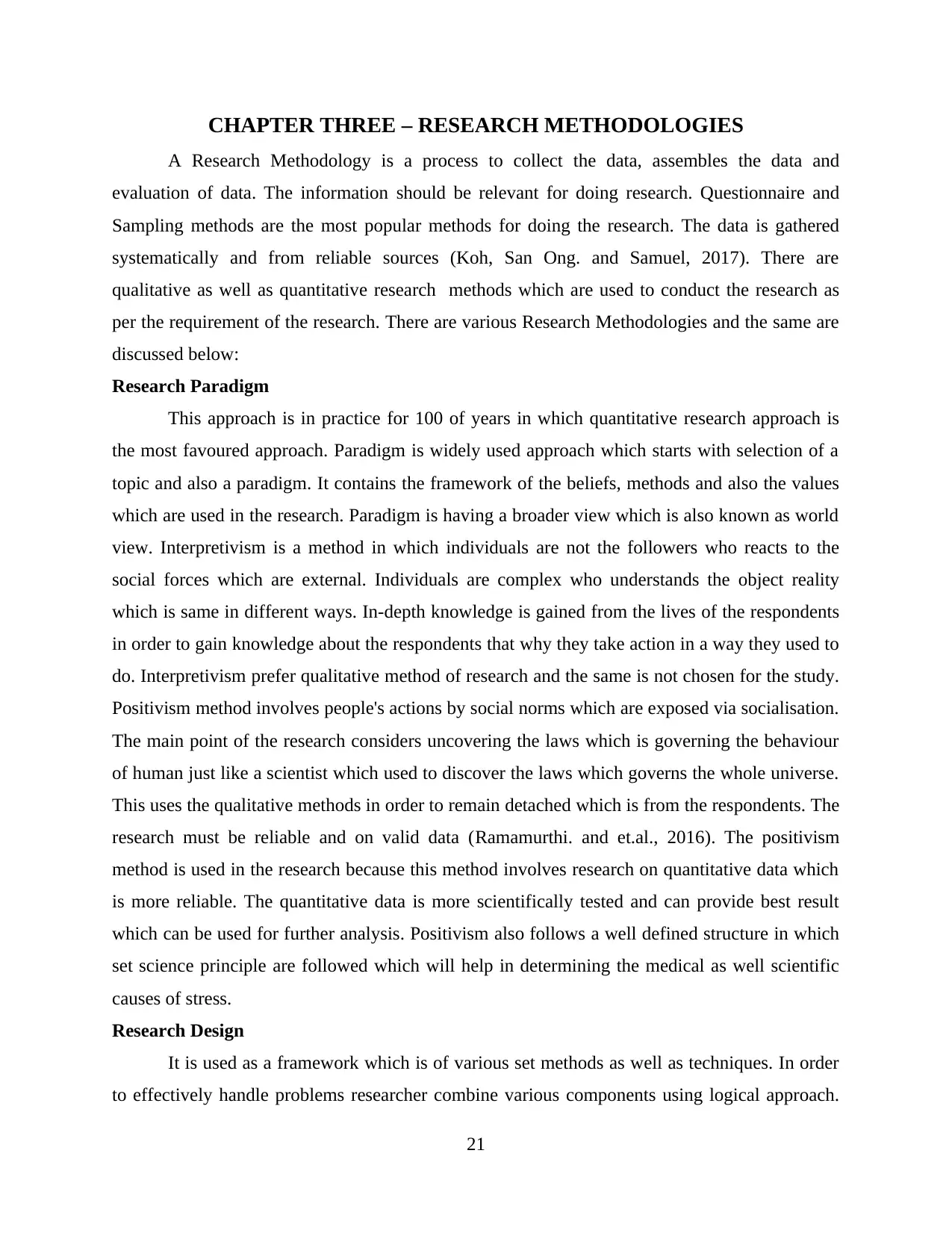
A Research Methodology is a process to collect the data, assembles the data and
evaluation of data. The information should be relevant for doing research. Questionnaire and
Sampling methods are the most popular methods for doing the research. The data is gathered
systematically and from reliable sources (Koh, San Ong. and Samuel, 2017). There are
qualitative as well as quantitative research methods which are used to conduct the research as
per the requirement of the research. There are various Research Methodologies and the same are
discussed below:
Research Paradigm
This approach is in practice for 100 of years in which quantitative research approach is
the most favoured approach. Paradigm is widely used approach which starts with selection of a
topic and also a paradigm. It contains the framework of the beliefs, methods and also the values
which are used in the research. Paradigm is having a broader view which is also known as world
view. Interpretivism is a method in which individuals are not the followers who reacts to the
social forces which are external. Individuals are complex who understands the object reality
which is same in different ways. In-depth knowledge is gained from the lives of the respondents
in order to gain knowledge about the respondents that why they take action in a way they used to
do. Interpretivism prefer qualitative method of research and the same is not chosen for the study.
Positivism method involves people's actions by social norms which are exposed via socialisation.
The main point of the research considers uncovering the laws which is governing the behaviour
of human just like a scientist which used to discover the laws which governs the whole universe.
This uses the qualitative methods in order to remain detached which is from the respondents. The
research must be reliable and on valid data (Ramamurthi. and et.al., 2016). The positivism
method is used in the research because this method involves research on quantitative data which
is more reliable. The quantitative data is more scientifically tested and can provide best result
which can be used for further analysis. Positivism also follows a well defined structure in which
set science principle are followed which will help in determining the medical as well scientific
causes of stress.
Research Design
It is used as a framework which is of various set methods as well as techniques. In order
to effectively handle problems researcher combine various components using logical approach.
21
Paraphrase This Document
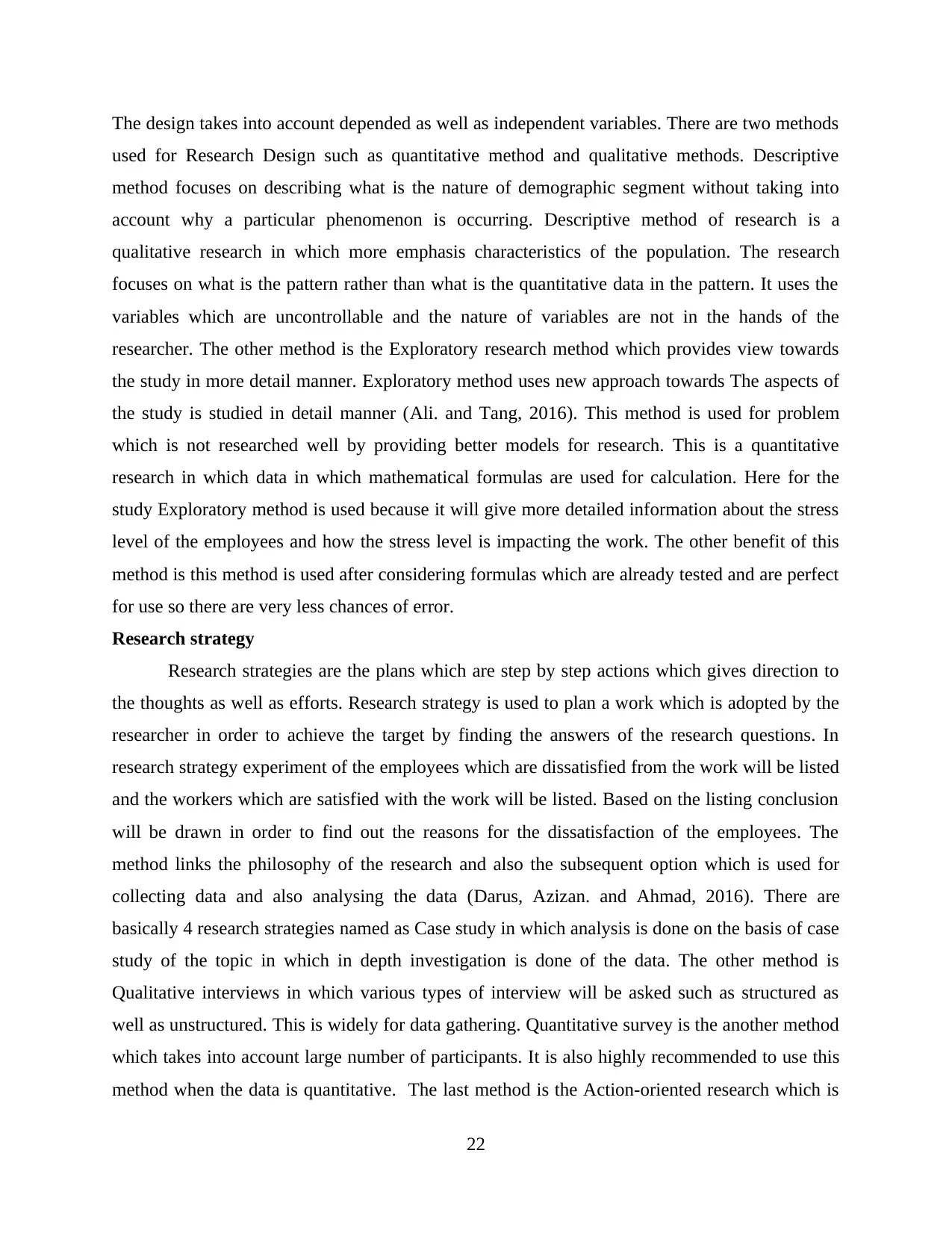
used for Research Design such as quantitative method and qualitative methods. Descriptive
method focuses on describing what is the nature of demographic segment without taking into
account why a particular phenomenon is occurring. Descriptive method of research is a
qualitative research in which more emphasis characteristics of the population. The research
focuses on what is the pattern rather than what is the quantitative data in the pattern. It uses the
variables which are uncontrollable and the nature of variables are not in the hands of the
researcher. The other method is the Exploratory research method which provides view towards
the study in more detail manner. Exploratory method uses new approach towards The aspects of
the study is studied in detail manner (Ali. and Tang, 2016). This method is used for problem
which is not researched well by providing better models for research. This is a quantitative
research in which data in which mathematical formulas are used for calculation. Here for the
study Exploratory method is used because it will give more detailed information about the stress
level of the employees and how the stress level is impacting the work. The other benefit of this
method is this method is used after considering formulas which are already tested and are perfect
for use so there are very less chances of error.
Research strategy
Research strategies are the plans which are step by step actions which gives direction to
the thoughts as well as efforts. Research strategy is used to plan a work which is adopted by the
researcher in order to achieve the target by finding the answers of the research questions. In
research strategy experiment of the employees which are dissatisfied from the work will be listed
and the workers which are satisfied with the work will be listed. Based on the listing conclusion
will be drawn in order to find out the reasons for the dissatisfaction of the employees. The
method links the philosophy of the research and also the subsequent option which is used for
collecting data and also analysing the data (Darus, Azizan. and Ahmad, 2016). There are
basically 4 research strategies named as Case study in which analysis is done on the basis of case
study of the topic in which in depth investigation is done of the data. The other method is
Qualitative interviews in which various types of interview will be asked such as structured as
well as unstructured. This is widely for data gathering. Quantitative survey is the another method
which takes into account large number of participants. It is also highly recommended to use this
method when the data is quantitative. The last method is the Action-oriented research which is
22
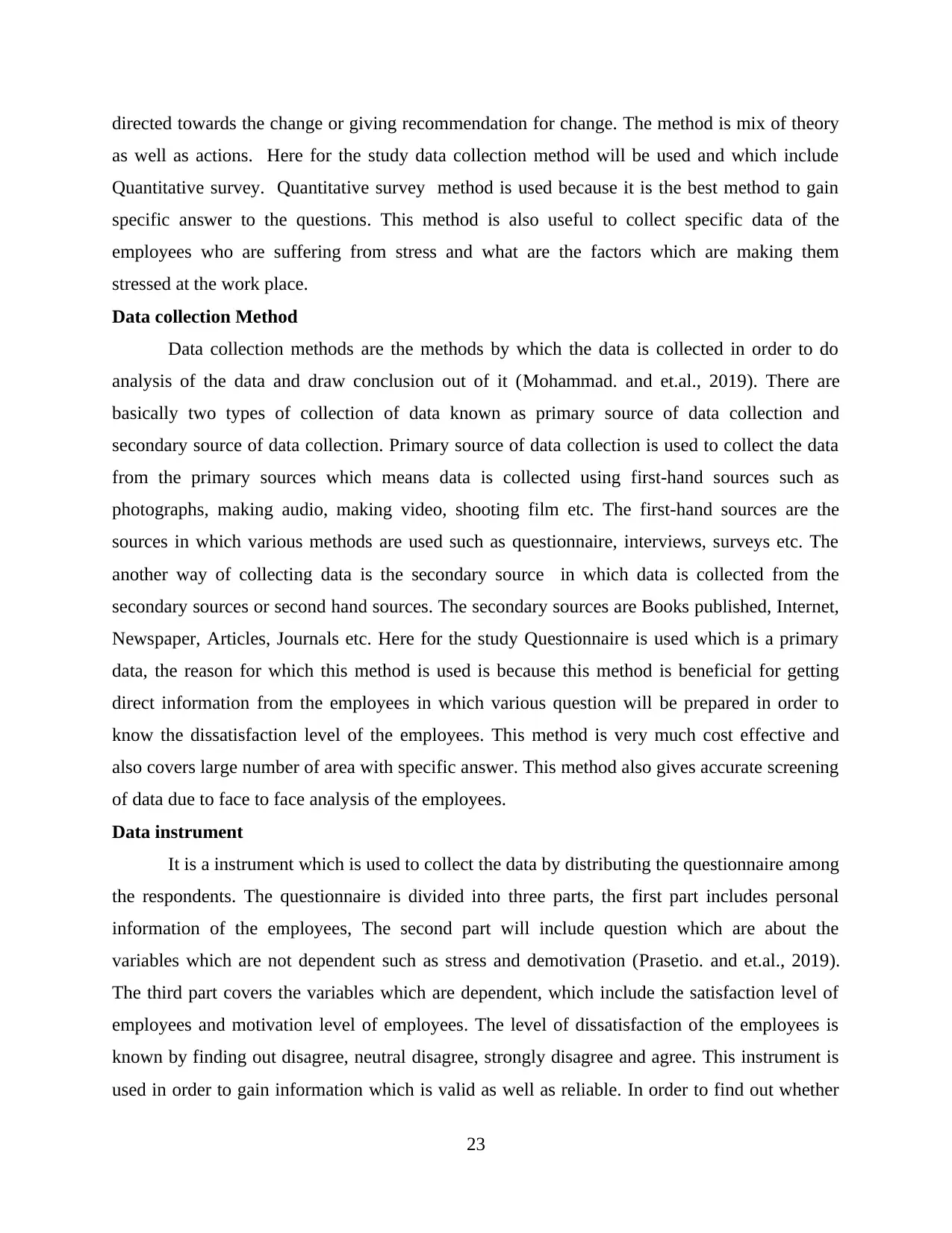
as well as actions. Here for the study data collection method will be used and which include
Quantitative survey. Quantitative survey method is used because it is the best method to gain
specific answer to the questions. This method is also useful to collect specific data of the
employees who are suffering from stress and what are the factors which are making them
stressed at the work place.
Data collection Method
Data collection methods are the methods by which the data is collected in order to do
analysis of the data and draw conclusion out of it (Mohammad. and et.al., 2019). There are
basically two types of collection of data known as primary source of data collection and
secondary source of data collection. Primary source of data collection is used to collect the data
from the primary sources which means data is collected using first-hand sources such as
photographs, making audio, making video, shooting film etc. The first-hand sources are the
sources in which various methods are used such as questionnaire, interviews, surveys etc. The
another way of collecting data is the secondary source in which data is collected from the
secondary sources or second hand sources. The secondary sources are Books published, Internet,
Newspaper, Articles, Journals etc. Here for the study Questionnaire is used which is a primary
data, the reason for which this method is used is because this method is beneficial for getting
direct information from the employees in which various question will be prepared in order to
know the dissatisfaction level of the employees. This method is very much cost effective and
also covers large number of area with specific answer. This method also gives accurate screening
of data due to face to face analysis of the employees.
Data instrument
It is a instrument which is used to collect the data by distributing the questionnaire among
the respondents. The questionnaire is divided into three parts, the first part includes personal
information of the employees, The second part will include question which are about the
variables which are not dependent such as stress and demotivation (Prasetio. and et.al., 2019).
The third part covers the variables which are dependent, which include the satisfaction level of
employees and motivation level of employees. The level of dissatisfaction of the employees is
known by finding out disagree, neutral disagree, strongly disagree and agree. This instrument is
used in order to gain information which is valid as well as reliable. In order to find out whether
23
⊘ This is a preview!⊘
Do you want full access?
Subscribe today to unlock all pages.

Trusted by 1+ million students worldwide

known as validity test and reliability test. In the validity test the validity of the employees are
known by taking test of the employees by their face validity, fingerprint validity and any special
mark validity. The reliability of questionnaire will be tested by testing whether the person
collecting the data is professional enough or not. The qualification of the person collecting the
data will be checked and then on the basis of which the task will be assigned. The
professionalism of the questions to be asked will also be checked in which it will be checked the
same question is not repeated again and again (Francis, Alagas. and Jambulingam, 2018). In the
study quality of the data collected will be given special importance in which the data collected
must be from reliable sources which are trusted sources such as trusted newspaper and news
channel known as BBC as per the reliability test.
Sampling: Sample of 201 individuals will be taken that are full time employee within an
organization. Simple random sampling method will be used under which on random basis sample
units will be taken from the population.
Questionnaire:
In the research study a questionnaire plays a vital role for data collection pertaining to the
issues raised in the research topic. A well-structured questionnaire is considered as a strong
factor for an effective and efficient research outcome. The main component of a questionnaire
includes general form, sequence of questions, formulation of questions, question’s content and
wording, confidentiality and observing is used. A questionnaire is a research instrument
comprising a series of question for the purpose of gathring information from respondent.
Questionnaire is considered as a written interview which can be carried out face to face, on
telephone, computer or post. In the present research the provisions of Data protection Act, 2018
are duly taken care off, where the privacy of the respondents are well protected and non-
disclosure and confidentiality statements are made available to protect participants privacy and
personal information. Ethical compliances are also accorded with to maintain the disciplinary
code and non to infringe the basic human rights of the respondents in anyway.
Apart from the survey questionnaire which is filled in by the participants, various positive
aspects have been considered while formulation of questionnaire, which are listed below:
The questionnaire is short and simple.
The size of the questionnaire is kept short and compact,
24
Paraphrase This Document

Another link in the question is also there where low of question is from easy to hard,
The use of vague and technical questions is avoided.
Typing of letter type question has been avoided for enhancing analysis.
Limited and controlled questions are framed to indicate high reliability.
Sensitive questions are avoided in order to keep reliability intact.
Data Analysis method:
The methods of data analysis have a focus on strategic approached of taking raw data,
mining them forgetting insight relevant for research and drilling down the information to
transform it into materials, figures and facts into initiatives that benefits research outcomes. In
current report regression method will be used in which there will be dependent and independent
variables and one moderator variable. Baron and Kenny model will take in to account in current
research work. There are basically two methods of data analysis, qualitative and quantitative data
analysis. The qualitative data refers to non-numeric information such as transcript, interviews,
videos, notes, images, audio recordings and text documents. Under this method a wide range of
non-qualifiable data is coded that is categorised under different heads. With codification of data
themes, patterns and relationships are established form the data gathered. Then all of them are
summarised to reach a conclusion over each category. Another method is quantitative data
analysis where numeric data is collected and here the raw material is turned into meaningful data
through application of rationale and critical thinking. This analysis includes the calculation of
frequencies of variables and difference between variables. This approach of analysis is
associated with finding evidences to support or reject a hypothesis which is formulated at the
earlier stages of the research which for this study is in the hypothesis section of chapter 2. Here
in this research quantitative data analysis is done where the use of statistical tool SPSS has been
used to evaluate the data collected form the questionnaire filled in by the employees working in
United Kingdom. The reason for using quantitative data analysis is that with use of SPSS the
hypothesis has either been either accepted or rejected and a relationship among the motivation,
employee performance and organisational stress factors has been established. This analysis has
resulted in giving effective outcome for the research which have been presented in the
conclusion and finding section of the research.
Ethical consideration:
25
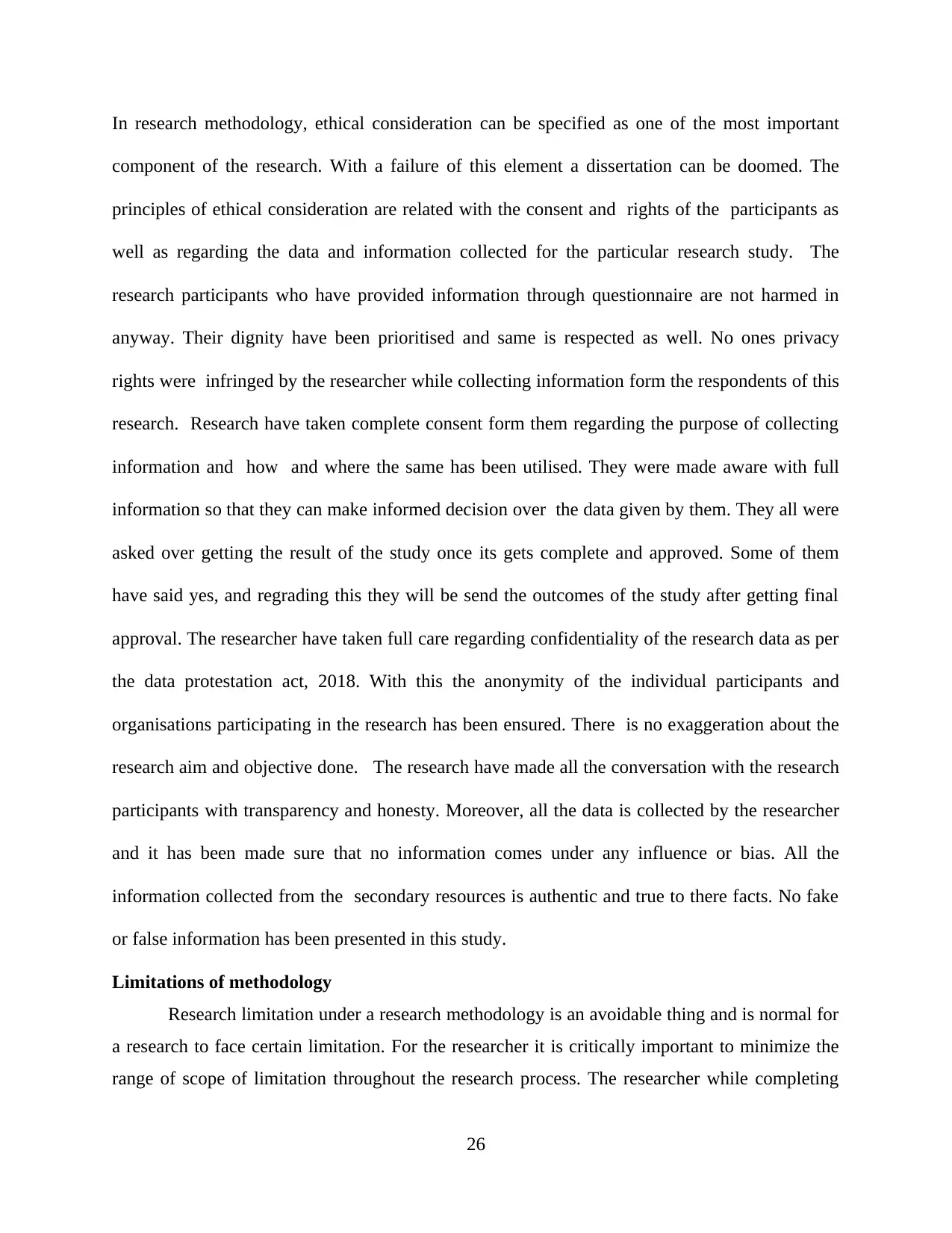
component of the research. With a failure of this element a dissertation can be doomed. The
principles of ethical consideration are related with the consent and rights of the participants as
well as regarding the data and information collected for the particular research study. The
research participants who have provided information through questionnaire are not harmed in
anyway. Their dignity have been prioritised and same is respected as well. No ones privacy
rights were infringed by the researcher while collecting information form the respondents of this
research. Research have taken complete consent form them regarding the purpose of collecting
information and how and where the same has been utilised. They were made aware with full
information so that they can make informed decision over the data given by them. They all were
asked over getting the result of the study once its gets complete and approved. Some of them
have said yes, and regrading this they will be send the outcomes of the study after getting final
approval. The researcher have taken full care regarding confidentiality of the research data as per
the data protestation act, 2018. With this the anonymity of the individual participants and
organisations participating in the research has been ensured. There is no exaggeration about the
research aim and objective done. The research have made all the conversation with the research
participants with transparency and honesty. Moreover, all the data is collected by the researcher
and it has been made sure that no information comes under any influence or bias. All the
information collected from the secondary resources is authentic and true to there facts. No fake
or false information has been presented in this study.
Limitations of methodology
Research limitation under a research methodology is an avoidable thing and is normal for
a research to face certain limitation. For the researcher it is critically important to minimize the
range of scope of limitation throughout the research process. The researcher while completing
26
⊘ This is a preview!⊘
Do you want full access?
Subscribe today to unlock all pages.

Trusted by 1+ million students worldwide
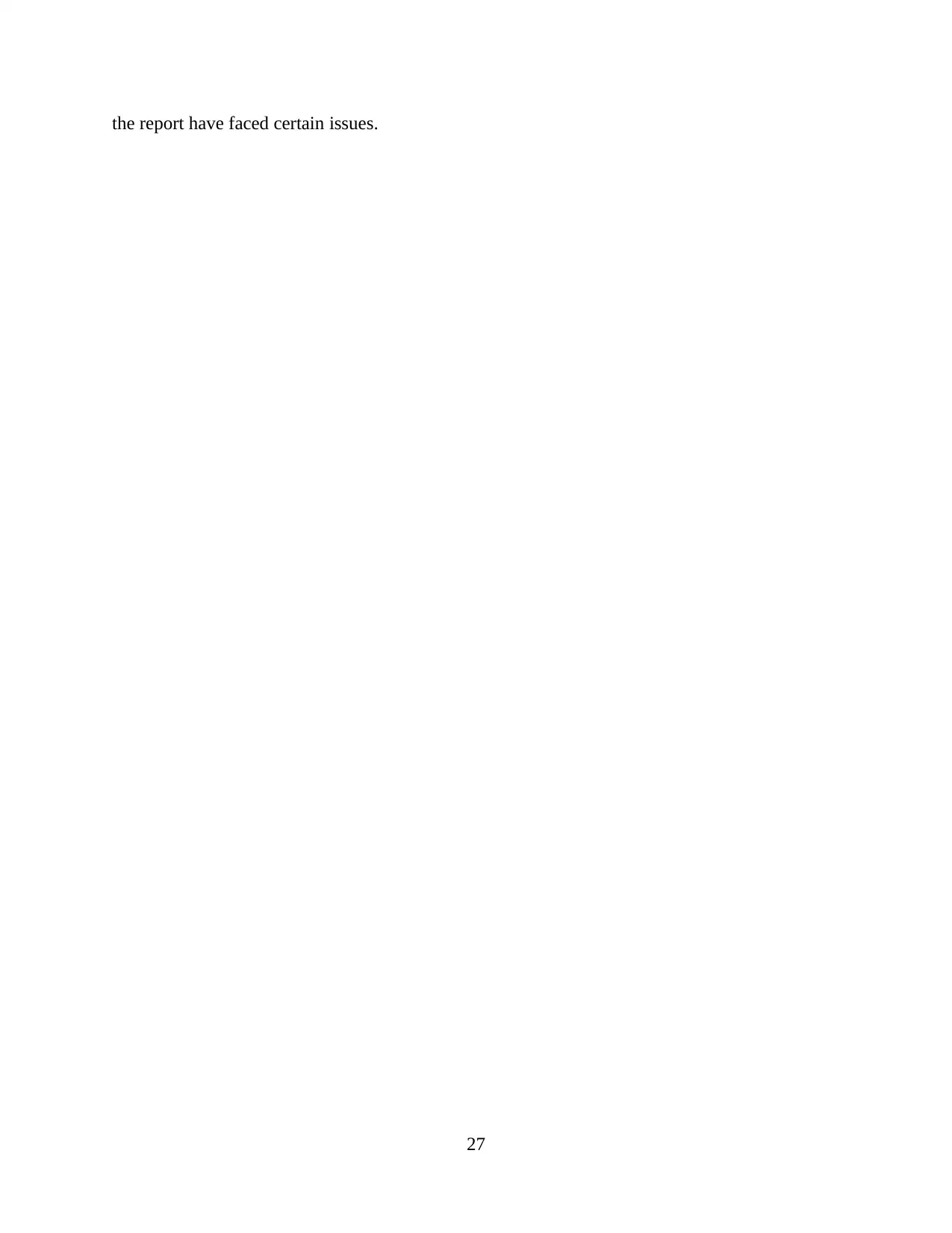
27
Paraphrase This Document
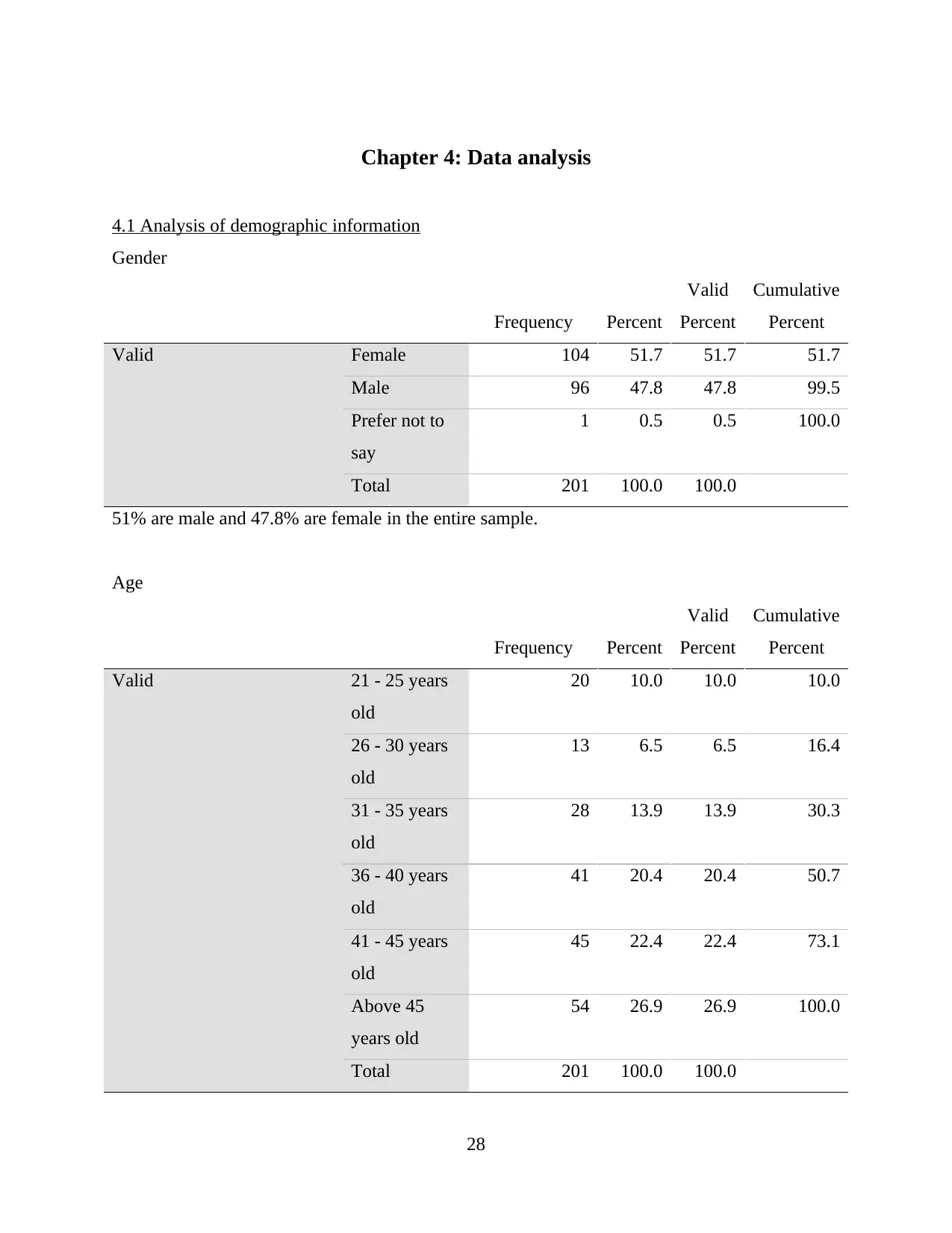
4.1 Analysis of demographic information
Gender
Frequency Percent
Valid
Percent
Cumulative
Percent
Valid Female 104 51.7 51.7 51.7
Male 96 47.8 47.8 99.5
Prefer not to
say
1 0.5 0.5 100.0
Total 201 100.0 100.0
51% are male and 47.8% are female in the entire sample.
Age
Frequency Percent
Valid
Percent
Cumulative
Percent
Valid 21 - 25 years
old
20 10.0 10.0 10.0
26 - 30 years
old
13 6.5 6.5 16.4
31 - 35 years
old
28 13.9 13.9 30.3
36 - 40 years
old
41 20.4 20.4 50.7
41 - 45 years
old
45 22.4 22.4 73.1
Above 45
years old
54 26.9 26.9 100.0
Total 201 100.0 100.0
28
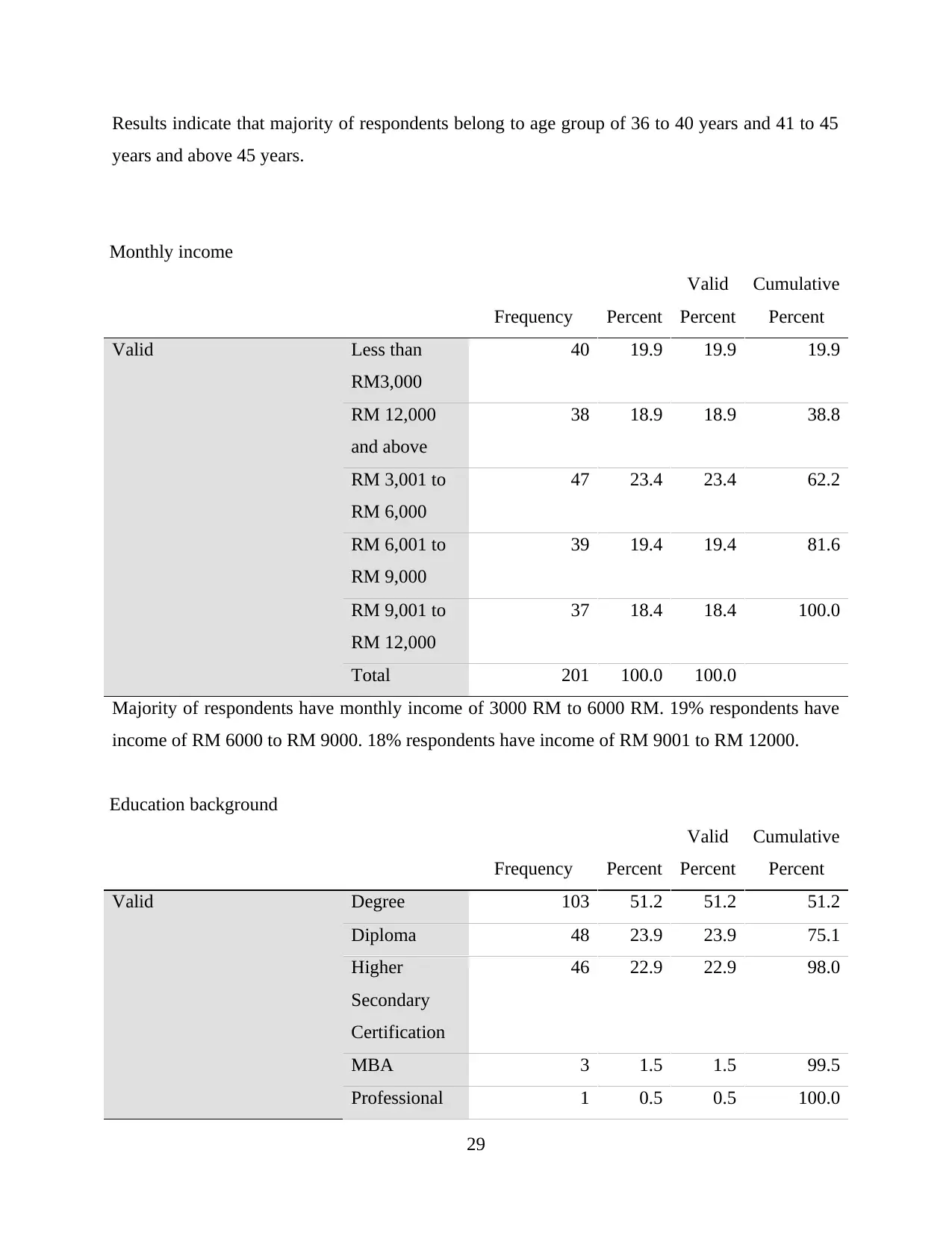
years and above 45 years.
Monthly income
Frequency Percent
Valid
Percent
Cumulative
Percent
Valid Less than
RM3,000
40 19.9 19.9 19.9
RM 12,000
and above
38 18.9 18.9 38.8
RM 3,001 to
RM 6,000
47 23.4 23.4 62.2
RM 6,001 to
RM 9,000
39 19.4 19.4 81.6
RM 9,001 to
RM 12,000
37 18.4 18.4 100.0
Total 201 100.0 100.0
Majority of respondents have monthly income of 3000 RM to 6000 RM. 19% respondents have
income of RM 6000 to RM 9000. 18% respondents have income of RM 9001 to RM 12000.
Education background
Frequency Percent
Valid
Percent
Cumulative
Percent
Valid Degree 103 51.2 51.2 51.2
Diploma 48 23.9 23.9 75.1
Higher
Secondary
Certification
46 22.9 22.9 98.0
MBA 3 1.5 1.5 99.5
Professional 1 0.5 0.5 100.0
29
⊘ This is a preview!⊘
Do you want full access?
Subscribe today to unlock all pages.

Trusted by 1+ million students worldwide
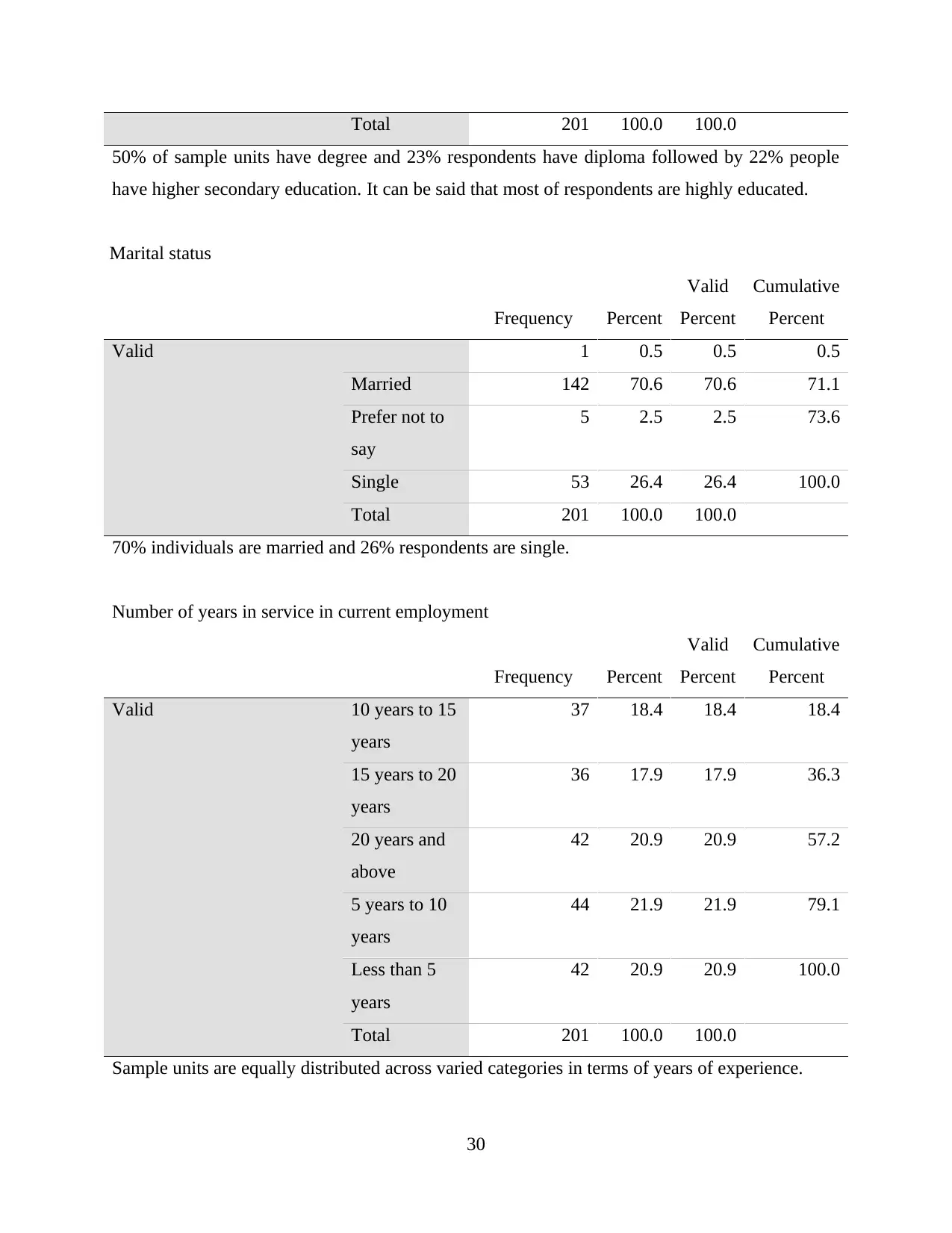
50% of sample units have degree and 23% respondents have diploma followed by 22% people
have higher secondary education. It can be said that most of respondents are highly educated.
Marital status
Frequency Percent
Valid
Percent
Cumulative
Percent
Valid 1 0.5 0.5 0.5
Married 142 70.6 70.6 71.1
Prefer not to
say
5 2.5 2.5 73.6
Single 53 26.4 26.4 100.0
Total 201 100.0 100.0
70% individuals are married and 26% respondents are single.
Number of years in service in current employment
Frequency Percent
Valid
Percent
Cumulative
Percent
Valid 10 years to 15
years
37 18.4 18.4 18.4
15 years to 20
years
36 17.9 17.9 36.3
20 years and
above
42 20.9 20.9 57.2
5 years to 10
years
44 21.9 21.9 79.1
Less than 5
years
42 20.9 20.9 100.0
Total 201 100.0 100.0
Sample units are equally distributed across varied categories in terms of years of experience.
30
Paraphrase This Document
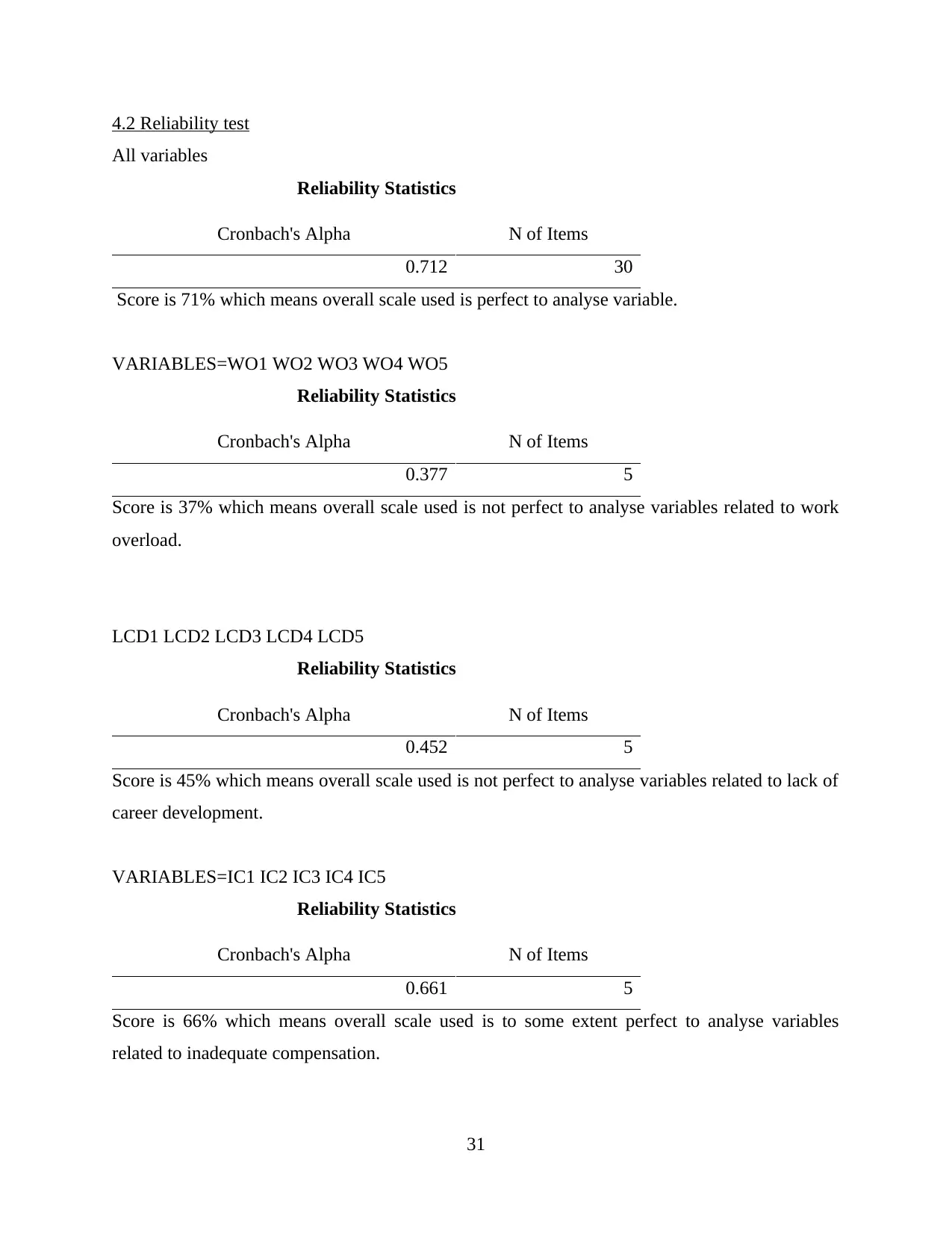
All variables
Reliability Statistics
Cronbach's Alpha N of Items
0.712 30
Score is 71% which means overall scale used is perfect to analyse variable.
VARIABLES=WO1 WO2 WO3 WO4 WO5
Reliability Statistics
Cronbach's Alpha N of Items
0.377 5
Score is 37% which means overall scale used is not perfect to analyse variables related to work
overload.
LCD1 LCD2 LCD3 LCD4 LCD5
Reliability Statistics
Cronbach's Alpha N of Items
0.452 5
Score is 45% which means overall scale used is not perfect to analyse variables related to lack of
career development.
VARIABLES=IC1 IC2 IC3 IC4 IC5
Reliability Statistics
Cronbach's Alpha N of Items
0.661 5
Score is 66% which means overall scale used is to some extent perfect to analyse variables
related to inadequate compensation.
31
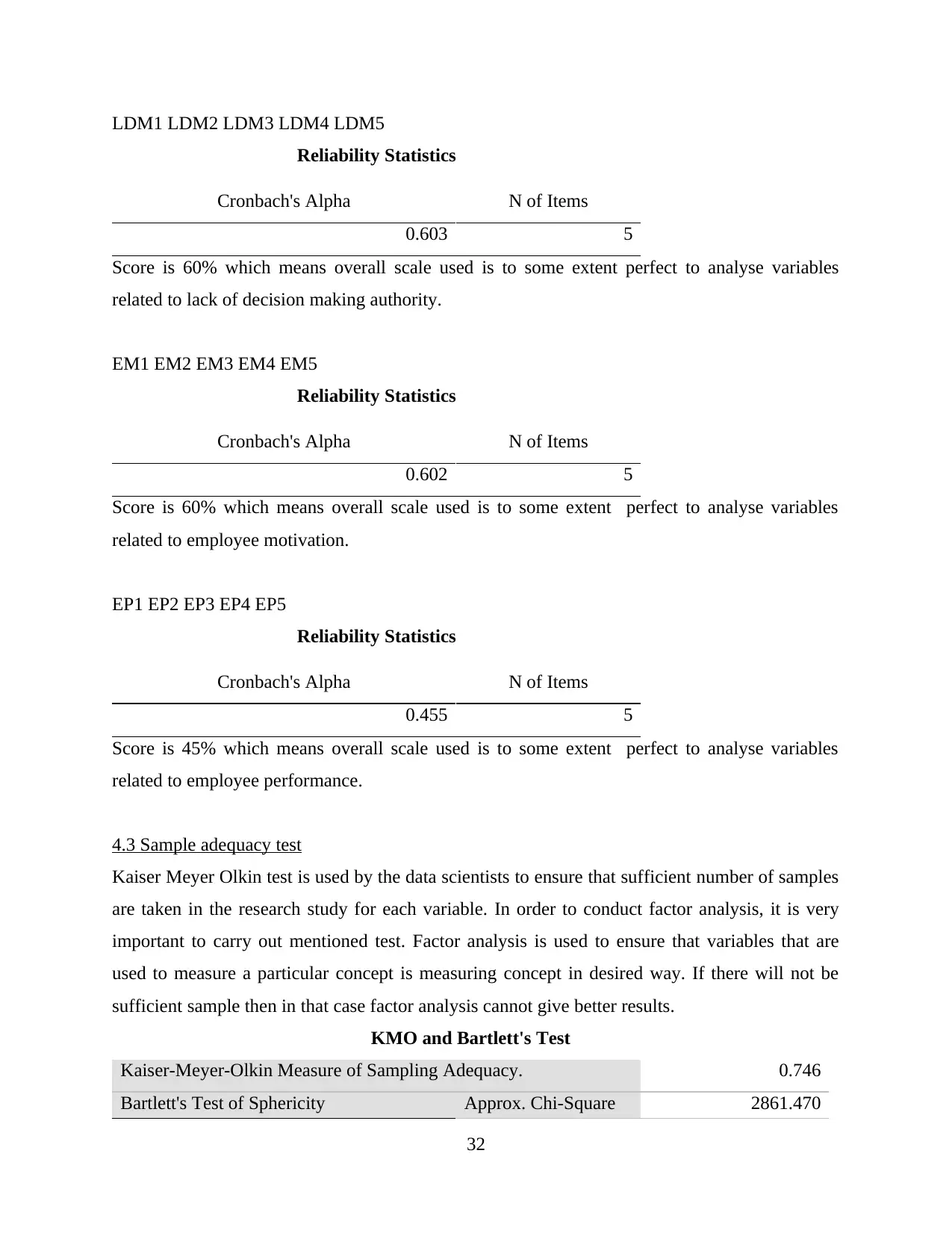
Reliability Statistics
Cronbach's Alpha N of Items
0.603 5
Score is 60% which means overall scale used is to some extent perfect to analyse variables
related to lack of decision making authority.
EM1 EM2 EM3 EM4 EM5
Reliability Statistics
Cronbach's Alpha N of Items
0.602 5
Score is 60% which means overall scale used is to some extent perfect to analyse variables
related to employee motivation.
EP1 EP2 EP3 EP4 EP5
Reliability Statistics
Cronbach's Alpha N of Items
0.455 5
Score is 45% which means overall scale used is to some extent perfect to analyse variables
related to employee performance.
4.3 Sample adequacy test
Kaiser Meyer Olkin test is used by the data scientists to ensure that sufficient number of samples
are taken in the research study for each variable. In order to conduct factor analysis, it is very
important to carry out mentioned test. Factor analysis is used to ensure that variables that are
used to measure a particular concept is measuring concept in desired way. If there will not be
sufficient sample then in that case factor analysis cannot give better results.
KMO and Bartlett's Test
Kaiser-Meyer-Olkin Measure of Sampling Adequacy. 0.746
Bartlett's Test of Sphericity Approx. Chi-Square 2861.470
32
⊘ This is a preview!⊘
Do you want full access?
Subscribe today to unlock all pages.

Trusted by 1+ million students worldwide
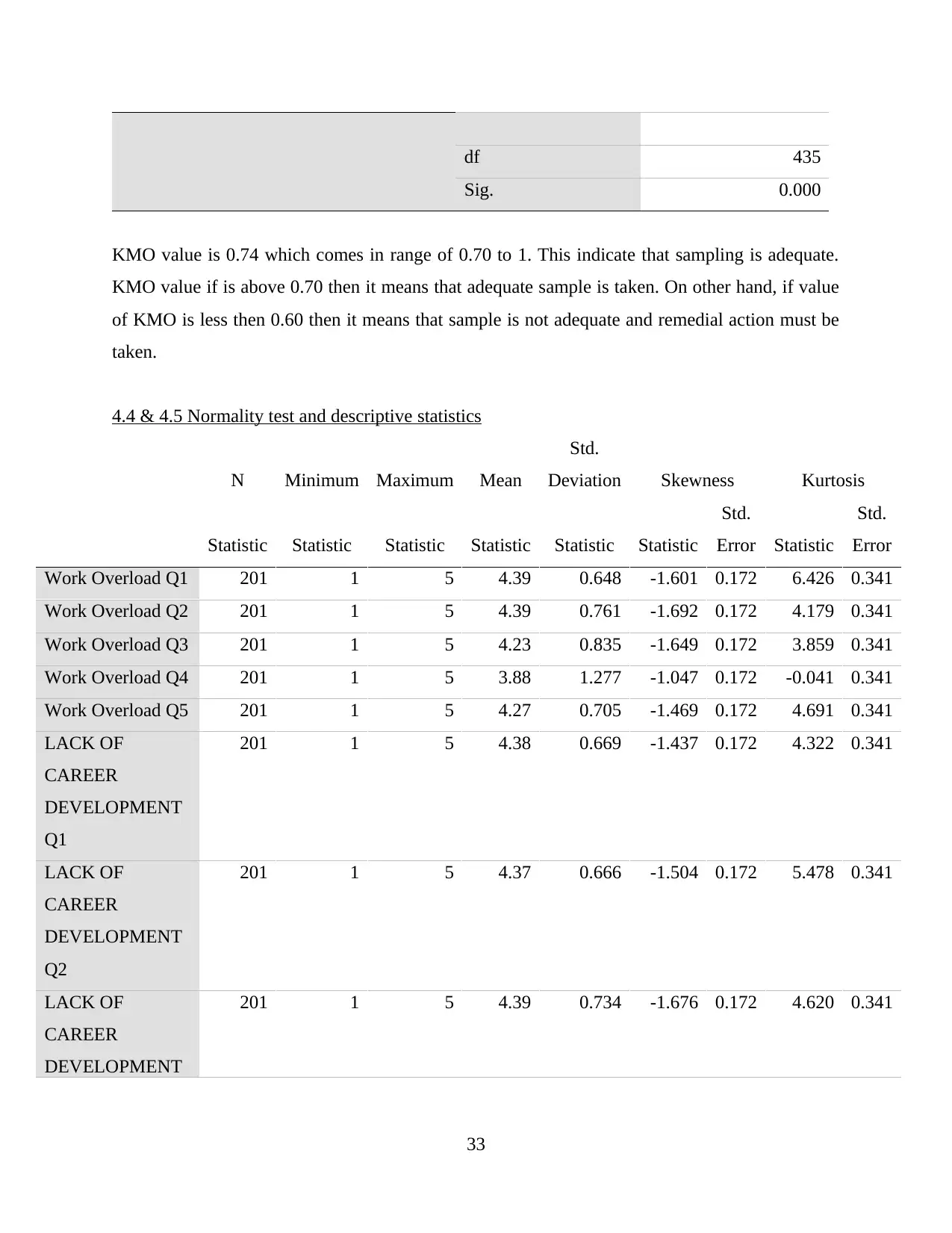
Sig. 0.000
KMO value is 0.74 which comes in range of 0.70 to 1. This indicate that sampling is adequate.
KMO value if is above 0.70 then it means that adequate sample is taken. On other hand, if value
of KMO is less then 0.60 then it means that sample is not adequate and remedial action must be
taken.
4.4 & 4.5 Normality test and descriptive statistics
N Minimum Maximum Mean
Std.
Deviation Skewness Kurtosis
Statistic Statistic Statistic Statistic Statistic Statistic
Std.
Error Statistic
Std.
Error
Work Overload Q1 201 1 5 4.39 0.648 -1.601 0.172 6.426 0.341
Work Overload Q2 201 1 5 4.39 0.761 -1.692 0.172 4.179 0.341
Work Overload Q3 201 1 5 4.23 0.835 -1.649 0.172 3.859 0.341
Work Overload Q4 201 1 5 3.88 1.277 -1.047 0.172 -0.041 0.341
Work Overload Q5 201 1 5 4.27 0.705 -1.469 0.172 4.691 0.341
LACK OF
CAREER
DEVELOPMENT
Q1
201 1 5 4.38 0.669 -1.437 0.172 4.322 0.341
LACK OF
CAREER
DEVELOPMENT
Q2
201 1 5 4.37 0.666 -1.504 0.172 5.478 0.341
LACK OF
CAREER
DEVELOPMENT
201 1 5 4.39 0.734 -1.676 0.172 4.620 0.341
33
Paraphrase This Document
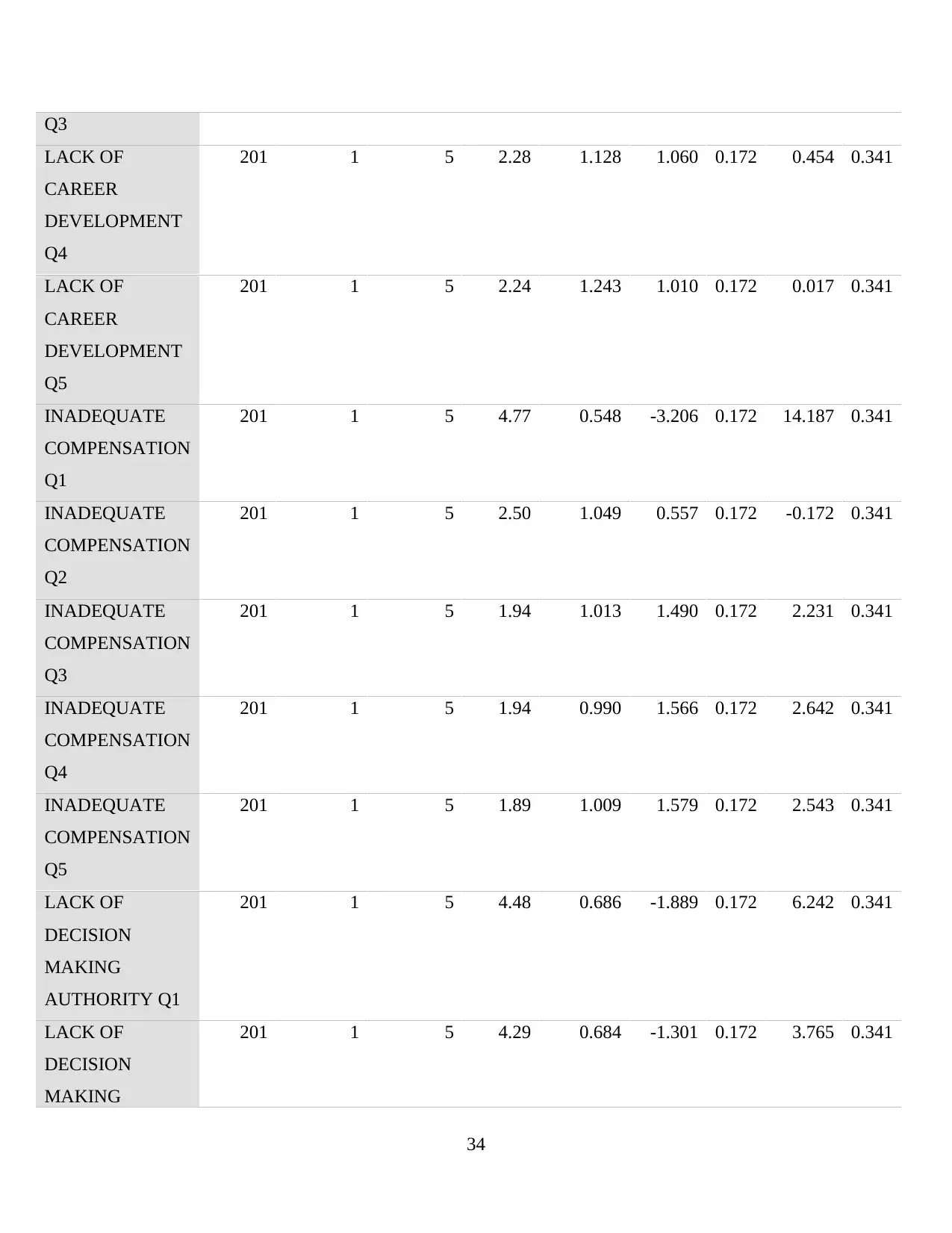
LACK OF
CAREER
DEVELOPMENT
Q4
201 1 5 2.28 1.128 1.060 0.172 0.454 0.341
LACK OF
CAREER
DEVELOPMENT
Q5
201 1 5 2.24 1.243 1.010 0.172 0.017 0.341
INADEQUATE
COMPENSATION
Q1
201 1 5 4.77 0.548 -3.206 0.172 14.187 0.341
INADEQUATE
COMPENSATION
Q2
201 1 5 2.50 1.049 0.557 0.172 -0.172 0.341
INADEQUATE
COMPENSATION
Q3
201 1 5 1.94 1.013 1.490 0.172 2.231 0.341
INADEQUATE
COMPENSATION
Q4
201 1 5 1.94 0.990 1.566 0.172 2.642 0.341
INADEQUATE
COMPENSATION
Q5
201 1 5 1.89 1.009 1.579 0.172 2.543 0.341
LACK OF
DECISION
MAKING
AUTHORITY Q1
201 1 5 4.48 0.686 -1.889 0.172 6.242 0.341
LACK OF
DECISION
MAKING
201 1 5 4.29 0.684 -1.301 0.172 3.765 0.341
34
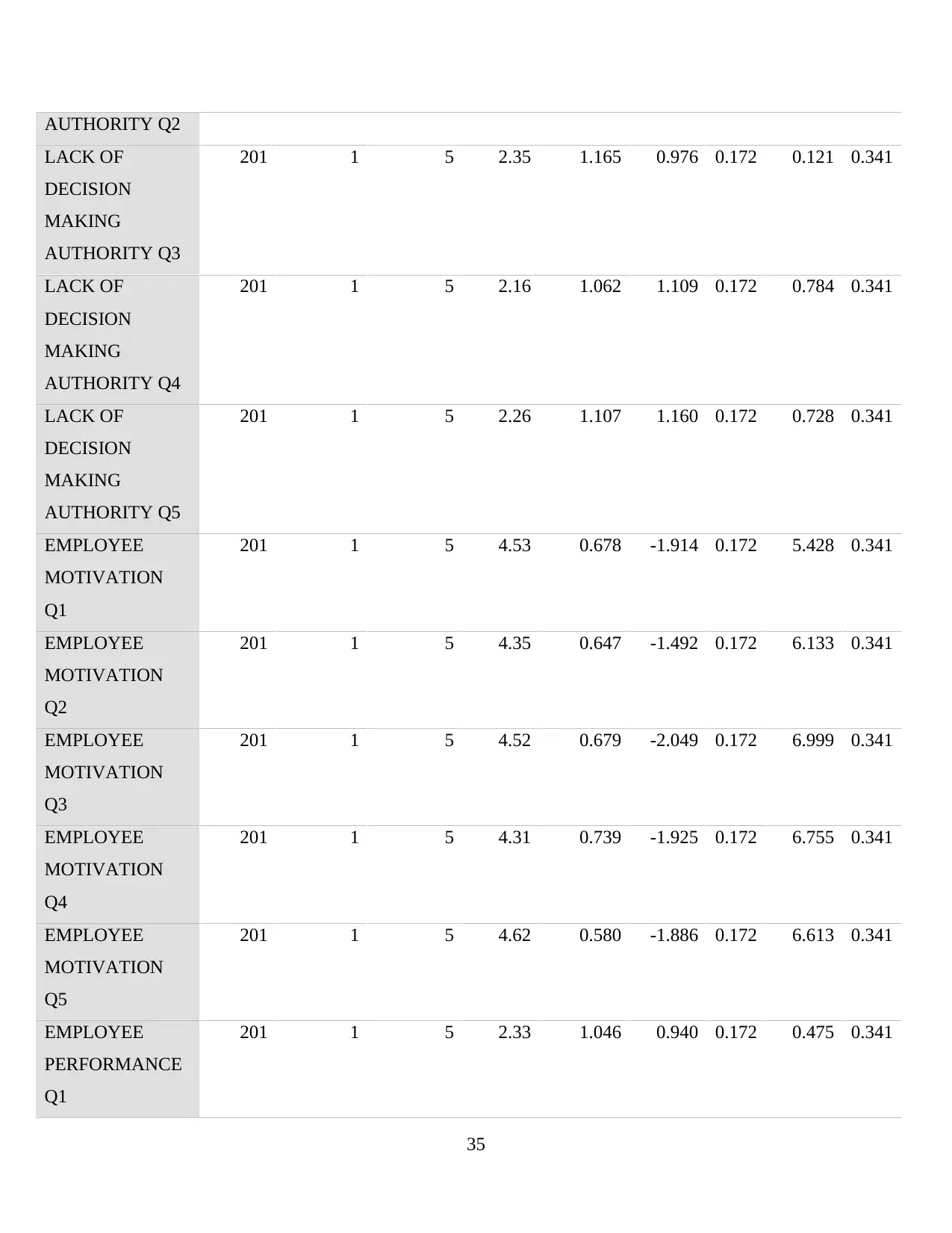
LACK OF
DECISION
MAKING
AUTHORITY Q3
201 1 5 2.35 1.165 0.976 0.172 0.121 0.341
LACK OF
DECISION
MAKING
AUTHORITY Q4
201 1 5 2.16 1.062 1.109 0.172 0.784 0.341
LACK OF
DECISION
MAKING
AUTHORITY Q5
201 1 5 2.26 1.107 1.160 0.172 0.728 0.341
EMPLOYEE
MOTIVATION
Q1
201 1 5 4.53 0.678 -1.914 0.172 5.428 0.341
EMPLOYEE
MOTIVATION
Q2
201 1 5 4.35 0.647 -1.492 0.172 6.133 0.341
EMPLOYEE
MOTIVATION
Q3
201 1 5 4.52 0.679 -2.049 0.172 6.999 0.341
EMPLOYEE
MOTIVATION
Q4
201 1 5 4.31 0.739 -1.925 0.172 6.755 0.341
EMPLOYEE
MOTIVATION
Q5
201 1 5 4.62 0.580 -1.886 0.172 6.613 0.341
EMPLOYEE
PERFORMANCE
Q1
201 1 5 2.33 1.046 0.940 0.172 0.475 0.341
35
⊘ This is a preview!⊘
Do you want full access?
Subscribe today to unlock all pages.

Trusted by 1+ million students worldwide

PERFORMANCE
Q2
201 1 5 4.44 0.847 -2.035 0.172 4.837 0.341
EMPLOYEE
PERFORMANCE
Q3
201 1 5 4.40 0.626 -1.295 0.172 4.564 0.341
EMPLOYEE
PERFORMANCE
Q4
201 1 5 4.54 0.648 -1.776 0.172 5.178 0.341
EMPLOYEE
PERFORMANCE
Q5
201 1 5 4.42 0.644 -1.450 0.172 4.784 0.341
WORK
OVERLOAD
201 1.80 5.00 4.2318 0.52553 -0.845 0.172 2.049 0.341
LACK OF
CAREER
DEVELOPMENT
201 2.40 5.00 3.5323 0.49739 1.078 0.172 1.050 0.341
INADEQUATE
COMPENSATION
201 1.80 5.00 2.6070 0.62238 1.748 0.172 3.736 0.341
LACK OF
DECISION
MAKING
AUTHORITY
201 2.20 5.00 3.1095 0.58716 1.459 0.172 1.762 0.341
EMPLOYEE
MOTIVATION
201 1.00 5.00 4.4667 0.46961 -2.474 0.172 14.414 0.341
EMPLOYEE
PERFORMANCE
201 1.80 5.00 4.0279 0.44048 -0.686 0.172 3.004 0.341
Valid N (listwise) 201
Normal distribution is defined as arrangement of dataset where majority of data points cluster
around mean value of the variable and rest tapper off symmetrically. In order to apply varied
36
Paraphrase This Document
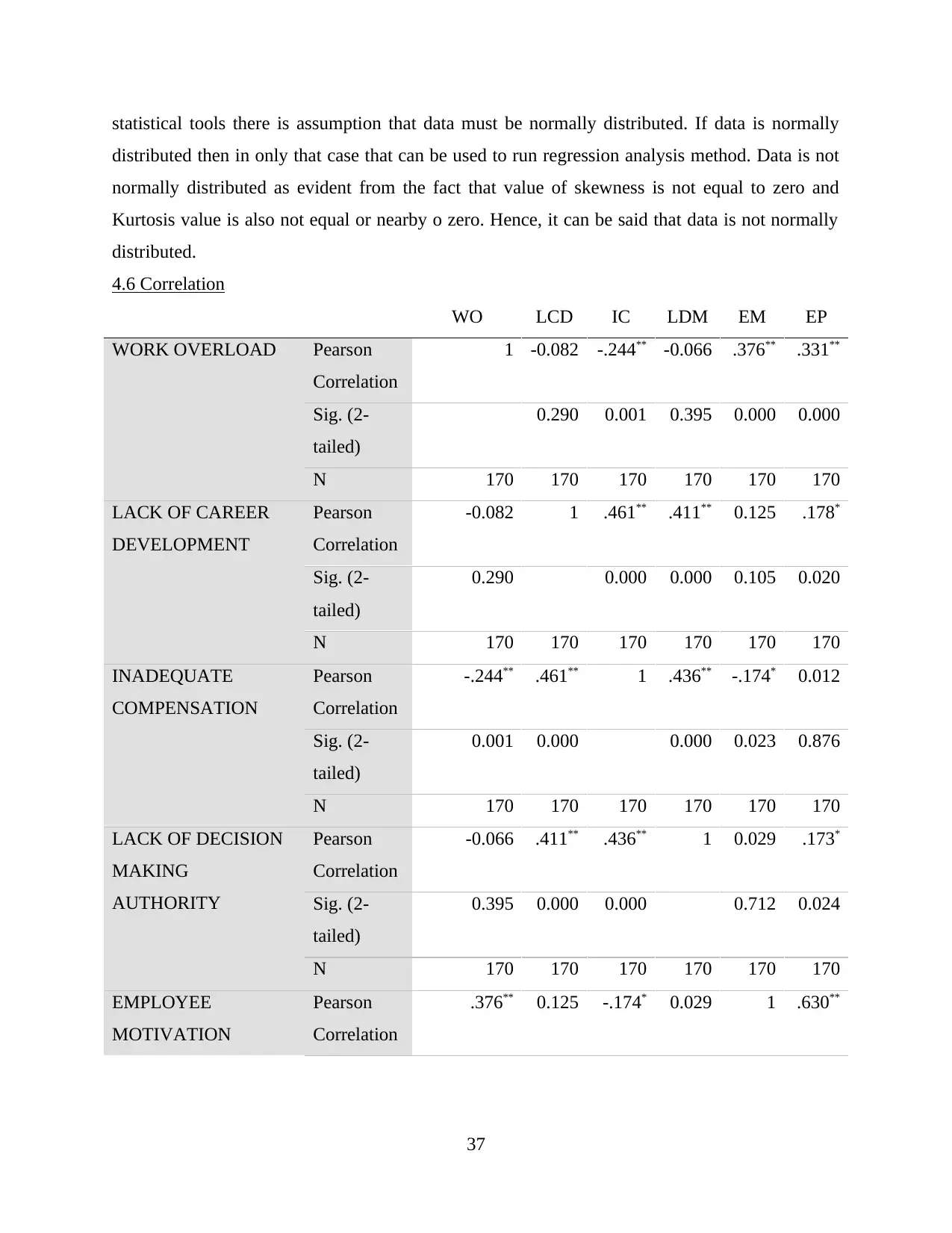
distributed then in only that case that can be used to run regression analysis method. Data is not
normally distributed as evident from the fact that value of skewness is not equal to zero and
Kurtosis value is also not equal or nearby o zero. Hence, it can be said that data is not normally
distributed.
4.6 Correlation
WO LCD IC LDM EM EP
WORK OVERLOAD Pearson
Correlation
1 -0.082 -.244** -0.066 .376** .331**
Sig. (2-
tailed)
0.290 0.001 0.395 0.000 0.000
N 170 170 170 170 170 170
LACK OF CAREER
DEVELOPMENT
Pearson
Correlation
-0.082 1 .461** .411** 0.125 .178*
Sig. (2-
tailed)
0.290 0.000 0.000 0.105 0.020
N 170 170 170 170 170 170
INADEQUATE
COMPENSATION
Pearson
Correlation
-.244** .461** 1 .436** -.174* 0.012
Sig. (2-
tailed)
0.001 0.000 0.000 0.023 0.876
N 170 170 170 170 170 170
LACK OF DECISION
MAKING
AUTHORITY
Pearson
Correlation
-0.066 .411** .436** 1 0.029 .173*
Sig. (2-
tailed)
0.395 0.000 0.000 0.712 0.024
N 170 170 170 170 170 170
EMPLOYEE
MOTIVATION
Pearson
Correlation
.376** 0.125 -.174* 0.029 1 .630**
37
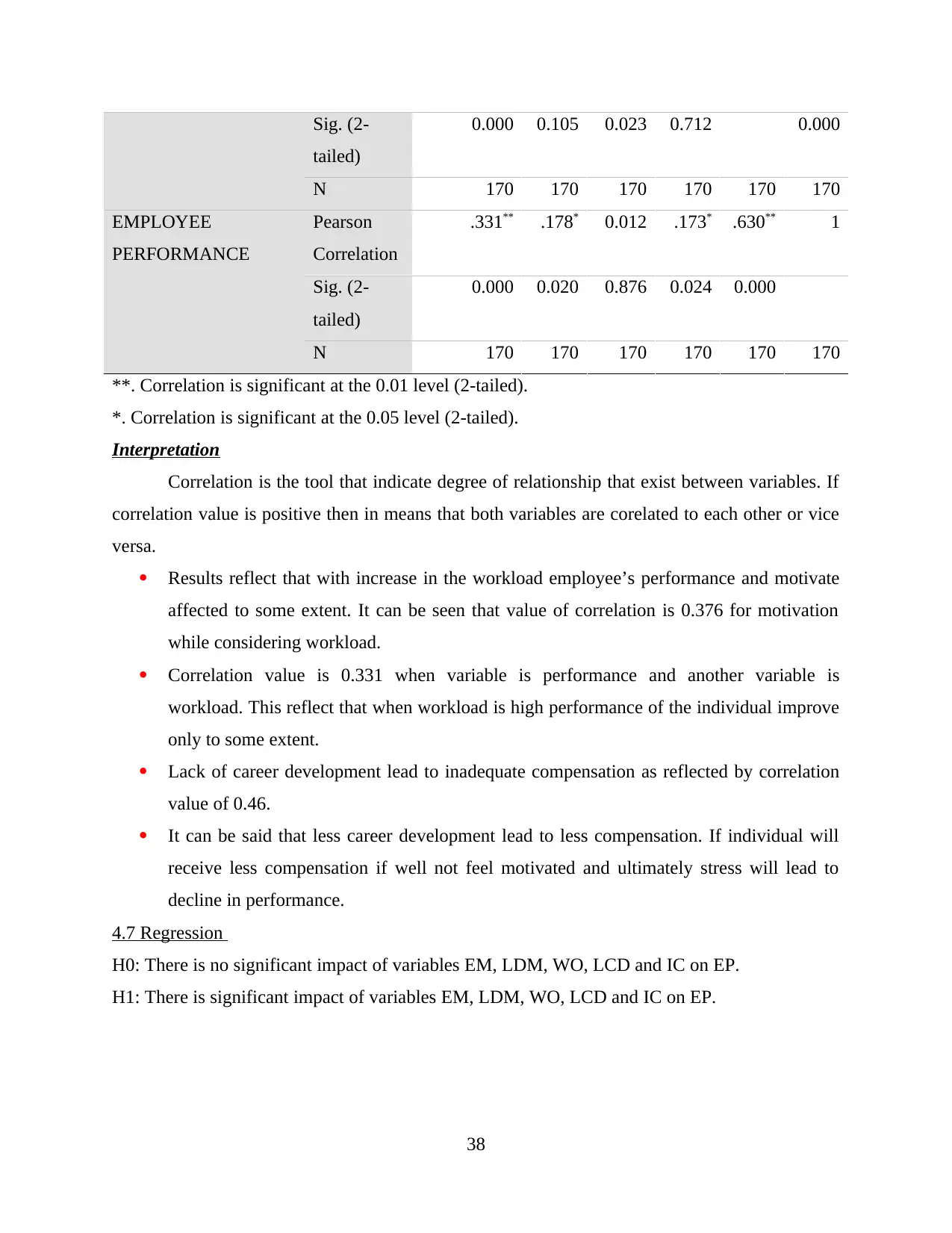
tailed)
0.000 0.105 0.023 0.712 0.000
N 170 170 170 170 170 170
EMPLOYEE
PERFORMANCE
Pearson
Correlation
.331** .178* 0.012 .173* .630** 1
Sig. (2-
tailed)
0.000 0.020 0.876 0.024 0.000
N 170 170 170 170 170 170
**. Correlation is significant at the 0.01 level (2-tailed).
*. Correlation is significant at the 0.05 level (2-tailed).
Interpretation
Correlation is the tool that indicate degree of relationship that exist between variables. If
correlation value is positive then in means that both variables are corelated to each other or vice
versa.
Results reflect that with increase in the workload employee’s performance and motivate
affected to some extent. It can be seen that value of correlation is 0.376 for motivation
while considering workload.
Correlation value is 0.331 when variable is performance and another variable is
workload. This reflect that when workload is high performance of the individual improve
only to some extent.
Lack of career development lead to inadequate compensation as reflected by correlation
value of 0.46.
It can be said that less career development lead to less compensation. If individual will
receive less compensation if well not feel motivated and ultimately stress will lead to
decline in performance.
4.7 Regression
H0: There is no significant impact of variables EM, LDM, WO, LCD and IC on EP.
H1: There is significant impact of variables EM, LDM, WO, LCD and IC on EP.
38
⊘ This is a preview!⊘
Do you want full access?
Subscribe today to unlock all pages.

Trusted by 1+ million students worldwide
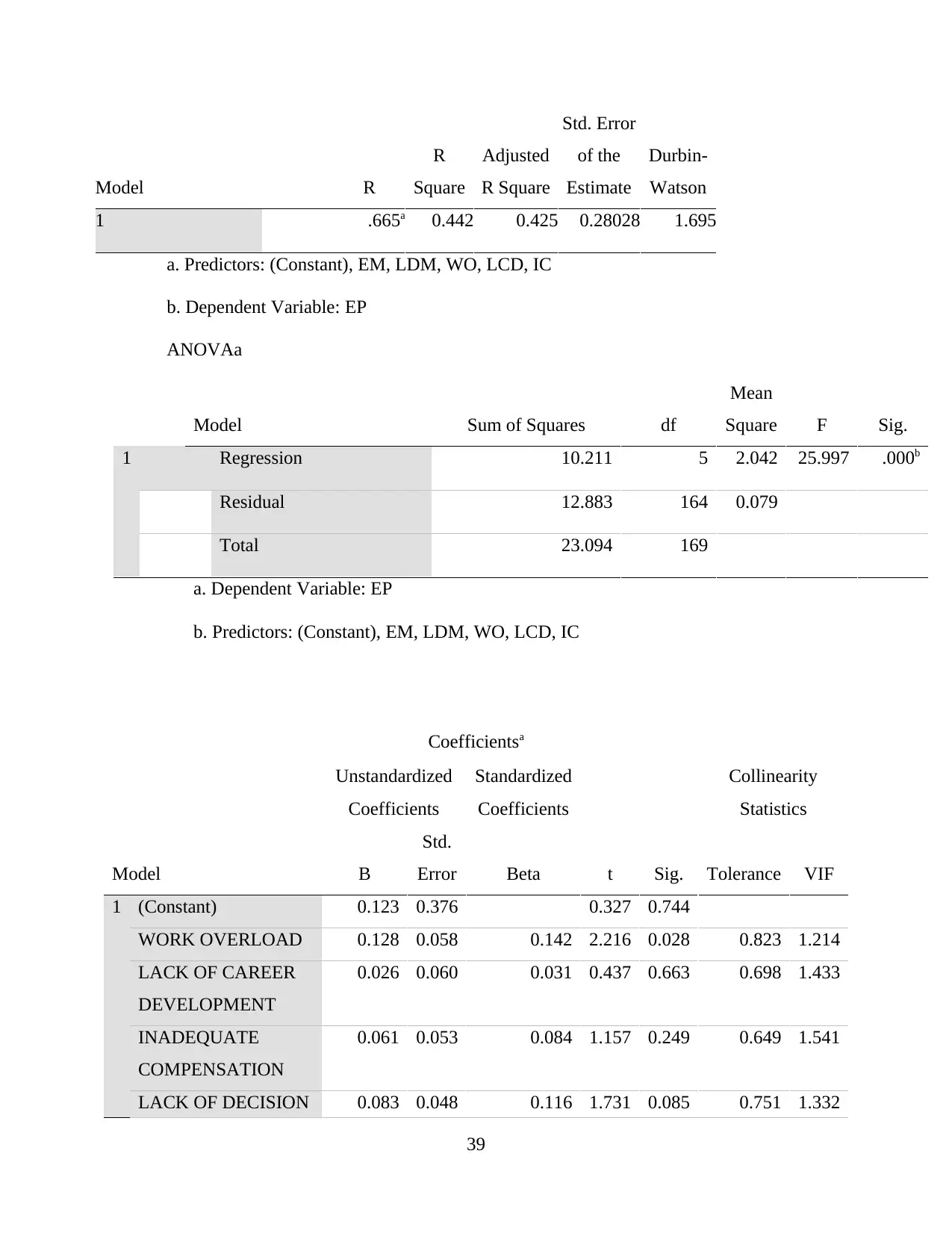
R
Square
Adjusted
R Square
Std. Error
of the
Estimate
Durbin-
Watson
1 .665a 0.442 0.425 0.28028 1.695
a. Predictors: (Constant), EM, LDM, WO, LCD, IC
b. Dependent Variable: EP
ANOVAa
Model Sum of Squares df
Mean
Square F Sig.
1 Regression 10.211 5 2.042 25.997 .000b
Residual 12.883 164 0.079
Total 23.094 169
a. Dependent Variable: EP
b. Predictors: (Constant), EM, LDM, WO, LCD, IC
Coefficientsa
Model
Unstandardized
Coefficients
Standardized
Coefficients
t Sig.
Collinearity
Statistics
B
Std.
Error Beta Tolerance VIF
1 (Constant) 0.123 0.376 0.327 0.744
WORK OVERLOAD 0.128 0.058 0.142 2.216 0.028 0.823 1.214
LACK OF CAREER
DEVELOPMENT
0.026 0.060 0.031 0.437 0.663 0.698 1.433
INADEQUATE
COMPENSATION
0.061 0.053 0.084 1.157 0.249 0.649 1.541
LACK OF DECISION 0.083 0.048 0.116 1.731 0.085 0.751 1.332
39
Paraphrase This Document
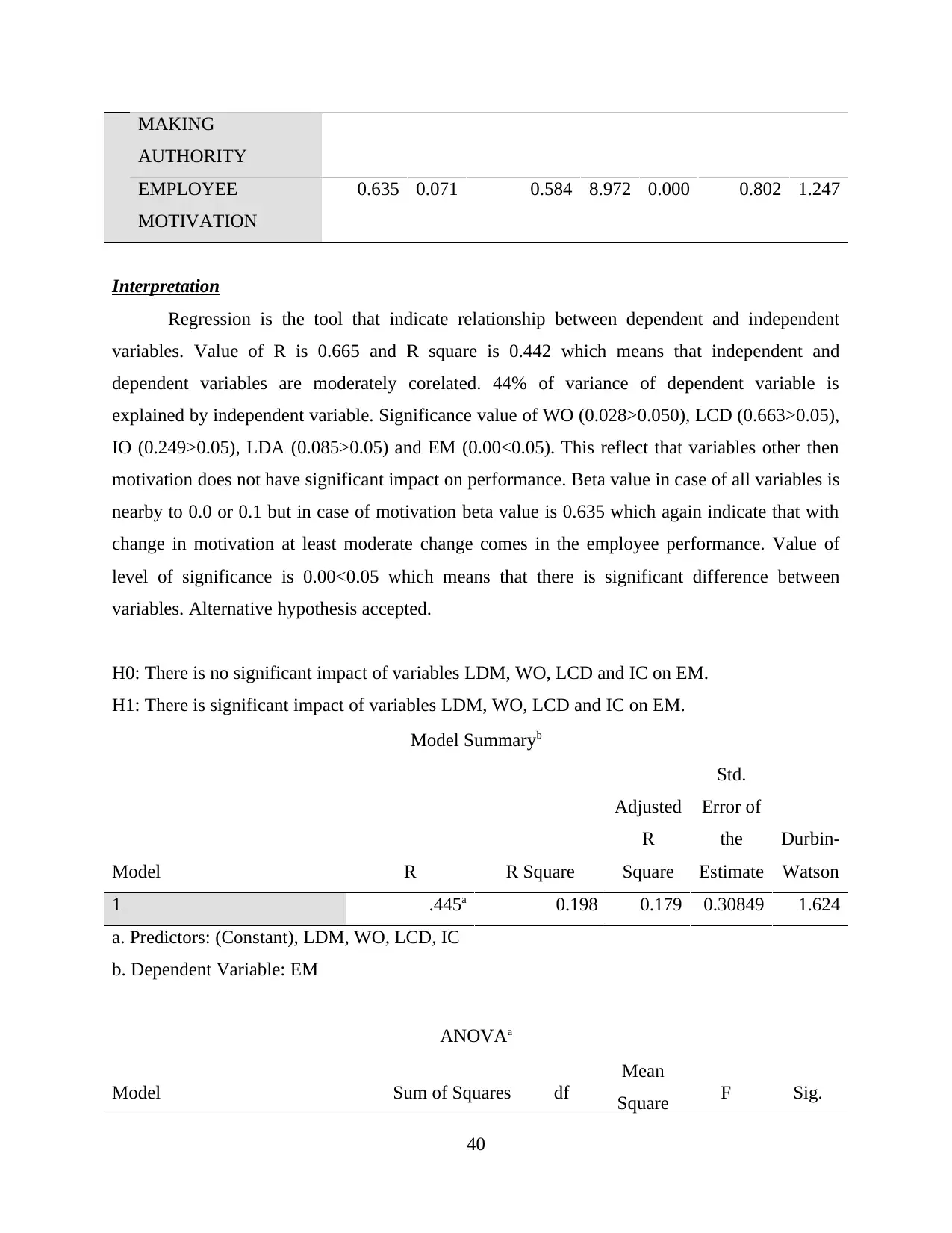
AUTHORITY
EMPLOYEE
MOTIVATION
0.635 0.071 0.584 8.972 0.000 0.802 1.247
Interpretation
Regression is the tool that indicate relationship between dependent and independent
variables. Value of R is 0.665 and R square is 0.442 which means that independent and
dependent variables are moderately corelated. 44% of variance of dependent variable is
explained by independent variable. Significance value of WO (0.028>0.050), LCD (0.663>0.05),
IO (0.249>0.05), LDA (0.085>0.05) and EM (0.00<0.05). This reflect that variables other then
motivation does not have significant impact on performance. Beta value in case of all variables is
nearby to 0.0 or 0.1 but in case of motivation beta value is 0.635 which again indicate that with
change in motivation at least moderate change comes in the employee performance. Value of
level of significance is 0.00<0.05 which means that there is significant difference between
variables. Alternative hypothesis accepted.
H0: There is no significant impact of variables LDM, WO, LCD and IC on EM.
H1: There is significant impact of variables LDM, WO, LCD and IC on EM.
Model Summaryb
Model R R Square
Adjusted
R
Square
Std.
Error of
the
Estimate
Durbin-
Watson
1 .445a 0.198 0.179 0.30849 1.624
a. Predictors: (Constant), LDM, WO, LCD, IC
b. Dependent Variable: EM
ANOVAa
Model Sum of Squares df
Mean
Square F Sig.
40
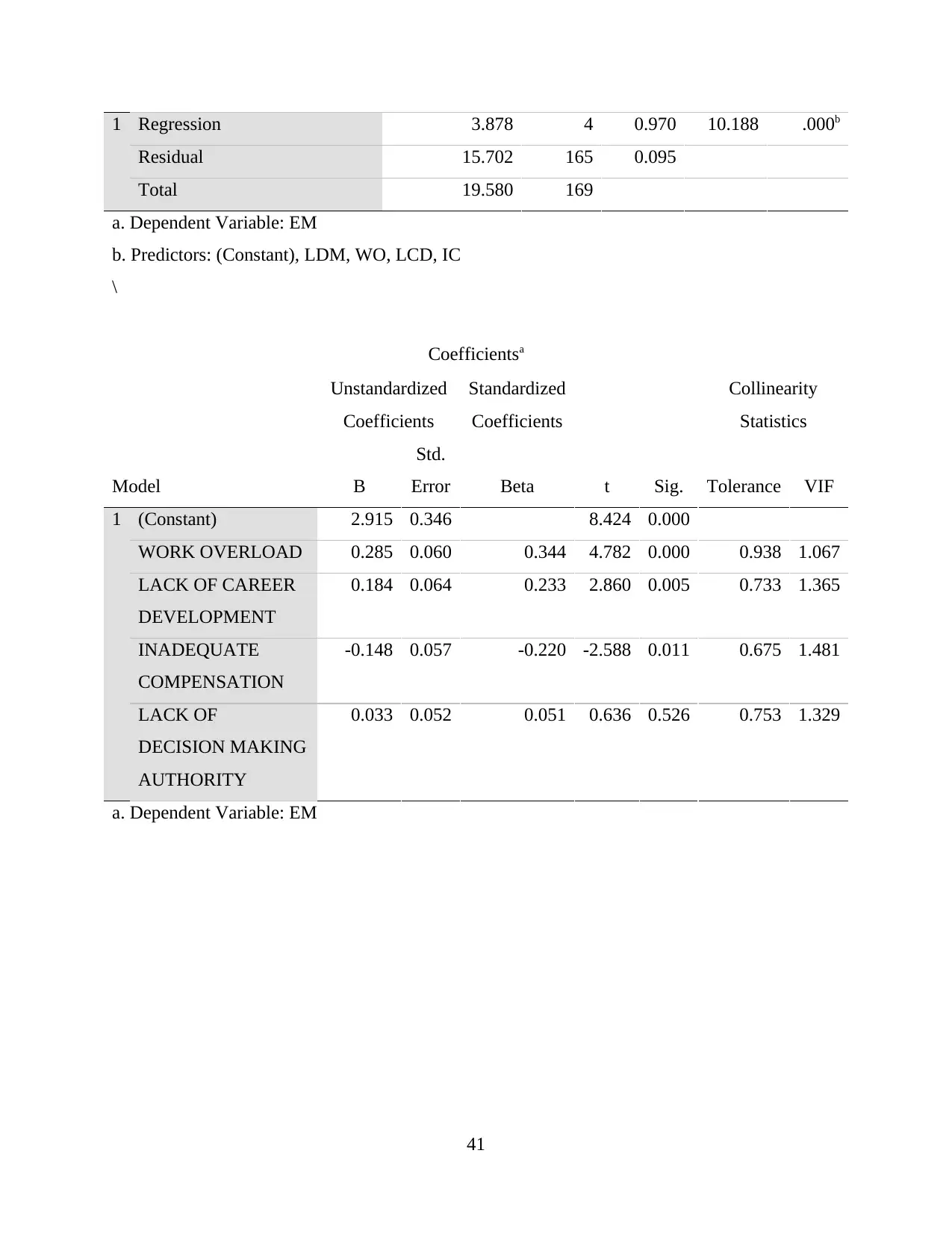
Residual 15.702 165 0.095
Total 19.580 169
a. Dependent Variable: EM
b. Predictors: (Constant), LDM, WO, LCD, IC
\
Coefficientsa
Model
Unstandardized
Coefficients
Standardized
Coefficients
t Sig.
Collinearity
Statistics
B
Std.
Error Beta Tolerance VIF
1 (Constant) 2.915 0.346 8.424 0.000
WORK OVERLOAD 0.285 0.060 0.344 4.782 0.000 0.938 1.067
LACK OF CAREER
DEVELOPMENT
0.184 0.064 0.233 2.860 0.005 0.733 1.365
INADEQUATE
COMPENSATION
-0.148 0.057 -0.220 -2.588 0.011 0.675 1.481
LACK OF
DECISION MAKING
AUTHORITY
0.033 0.052 0.051 0.636 0.526 0.753 1.329
a. Dependent Variable: EM
41
⊘ This is a preview!⊘
Do you want full access?
Subscribe today to unlock all pages.

Trusted by 1+ million students worldwide
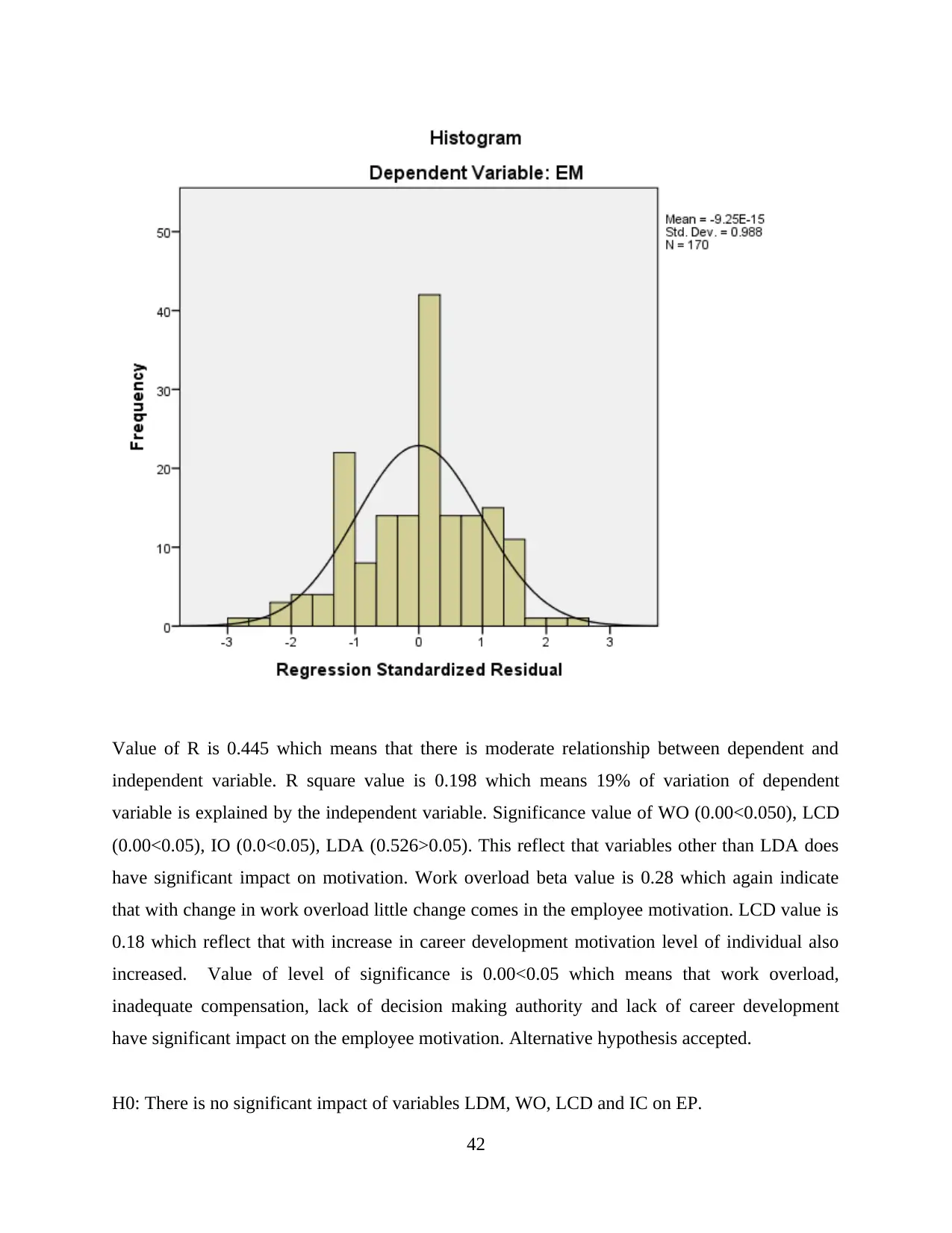
independent variable. R square value is 0.198 which means 19% of variation of dependent
variable is explained by the independent variable. Significance value of WO (0.00<0.050), LCD
(0.00<0.05), IO (0.0<0.05), LDA (0.526>0.05). This reflect that variables other than LDA does
have significant impact on motivation. Work overload beta value is 0.28 which again indicate
that with change in work overload little change comes in the employee motivation. LCD value is
0.18 which reflect that with increase in career development motivation level of individual also
increased. Value of level of significance is 0.00<0.05 which means that work overload,
inadequate compensation, lack of decision making authority and lack of career development
have significant impact on the employee motivation. Alternative hypothesis accepted.
H0: There is no significant impact of variables LDM, WO, LCD and IC on EP.
42
Paraphrase This Document
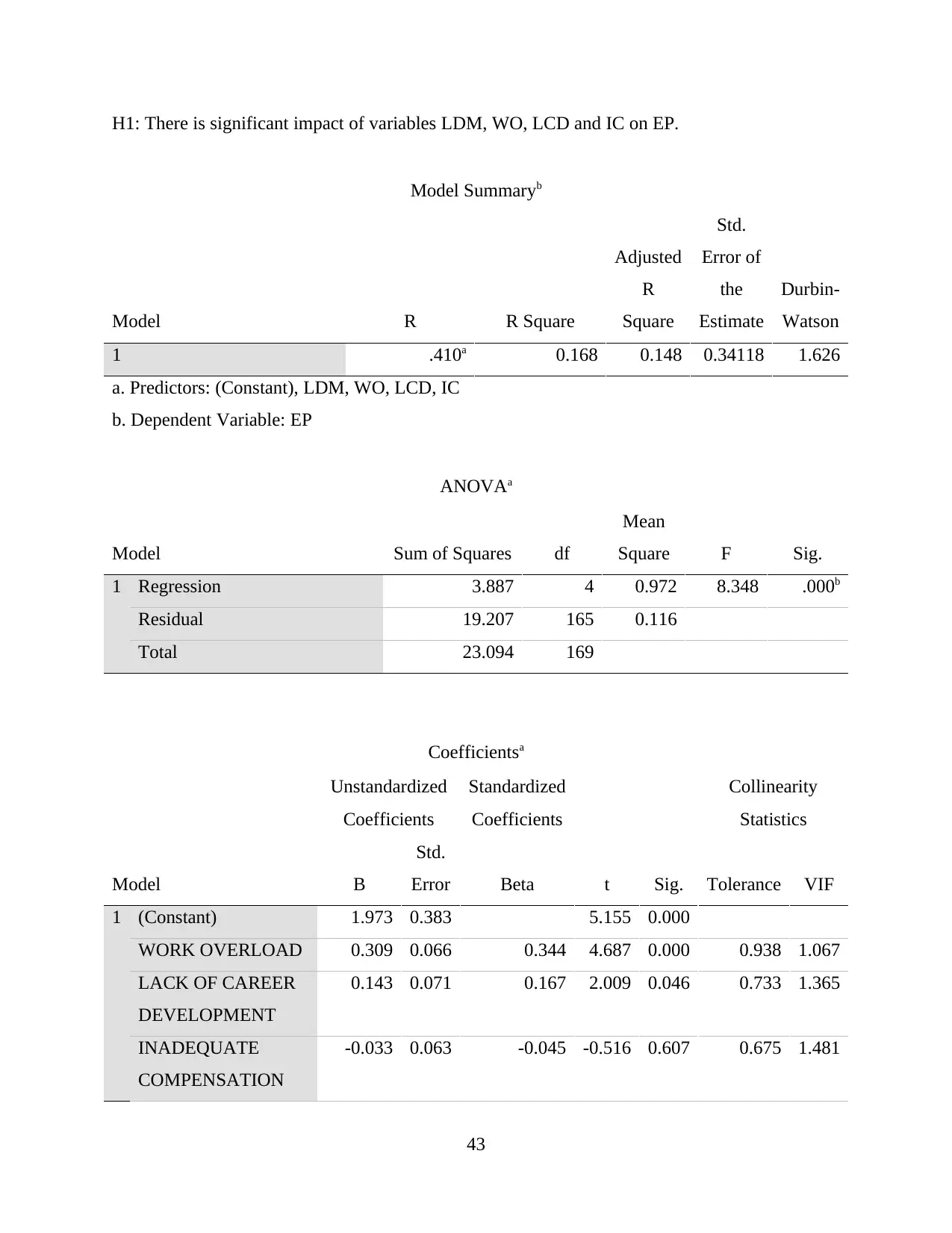
Model Summaryb
Model R R Square
Adjusted
R
Square
Std.
Error of
the
Estimate
Durbin-
Watson
1 .410a 0.168 0.148 0.34118 1.626
a. Predictors: (Constant), LDM, WO, LCD, IC
b. Dependent Variable: EP
ANOVAa
Model Sum of Squares df
Mean
Square F Sig.
1 Regression 3.887 4 0.972 8.348 .000b
Residual 19.207 165 0.116
Total 23.094 169
Coefficientsa
Model
Unstandardized
Coefficients
Standardized
Coefficients
t Sig.
Collinearity
Statistics
B
Std.
Error Beta Tolerance VIF
1 (Constant) 1.973 0.383 5.155 0.000
WORK OVERLOAD 0.309 0.066 0.344 4.687 0.000 0.938 1.067
LACK OF CAREER
DEVELOPMENT
0.143 0.071 0.167 2.009 0.046 0.733 1.365
INADEQUATE
COMPENSATION
-0.033 0.063 -0.045 -0.516 0.607 0.675 1.481
43
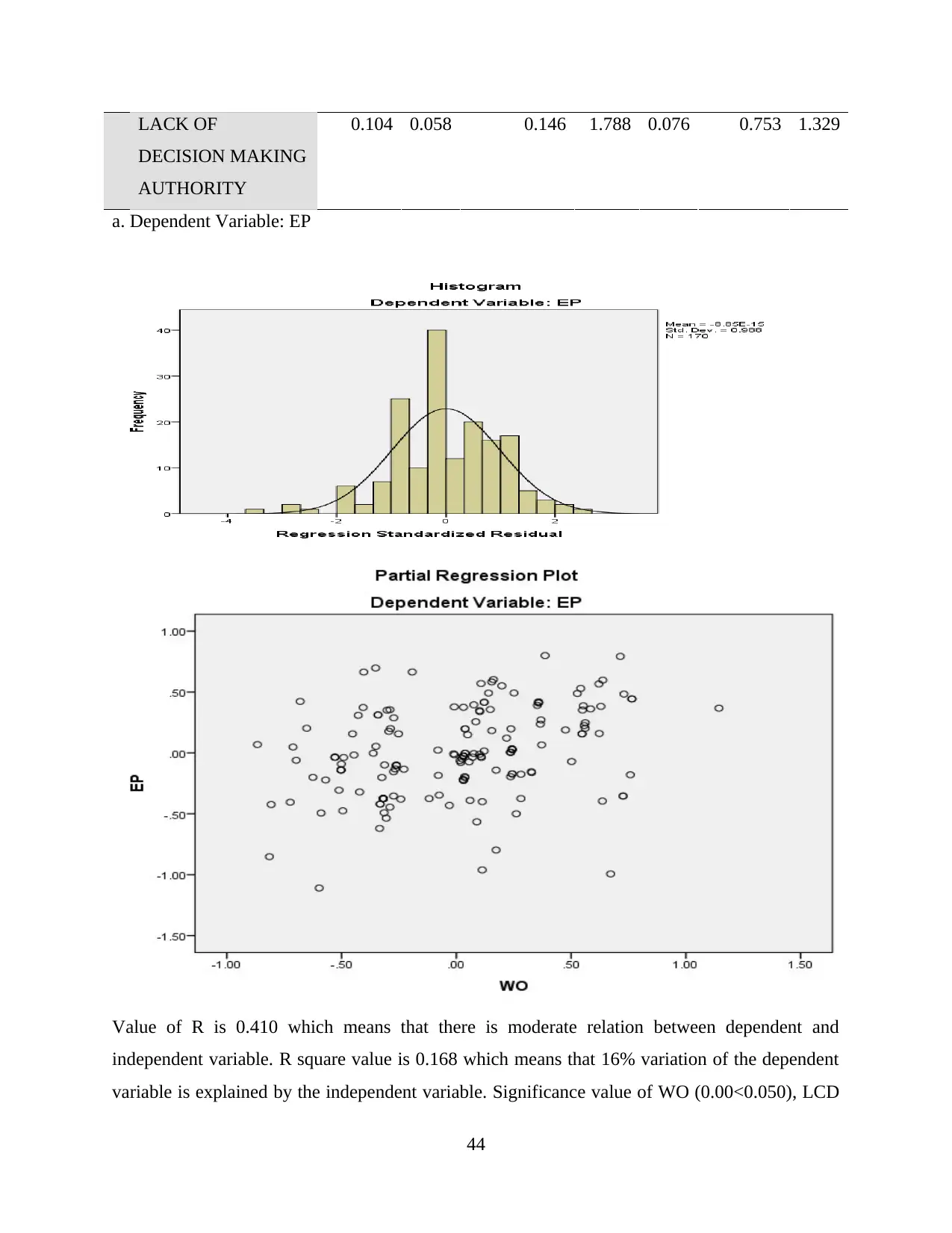
DECISION MAKING
AUTHORITY
0.104 0.058 0.146 1.788 0.076 0.753 1.329
a. Dependent Variable: EP
Value of R is 0.410 which means that there is moderate relation between dependent and
independent variable. R square value is 0.168 which means that 16% variation of the dependent
variable is explained by the independent variable. Significance value of WO (0.00<0.050), LCD
44
⊘ This is a preview!⊘
Do you want full access?
Subscribe today to unlock all pages.

Trusted by 1+ million students worldwide
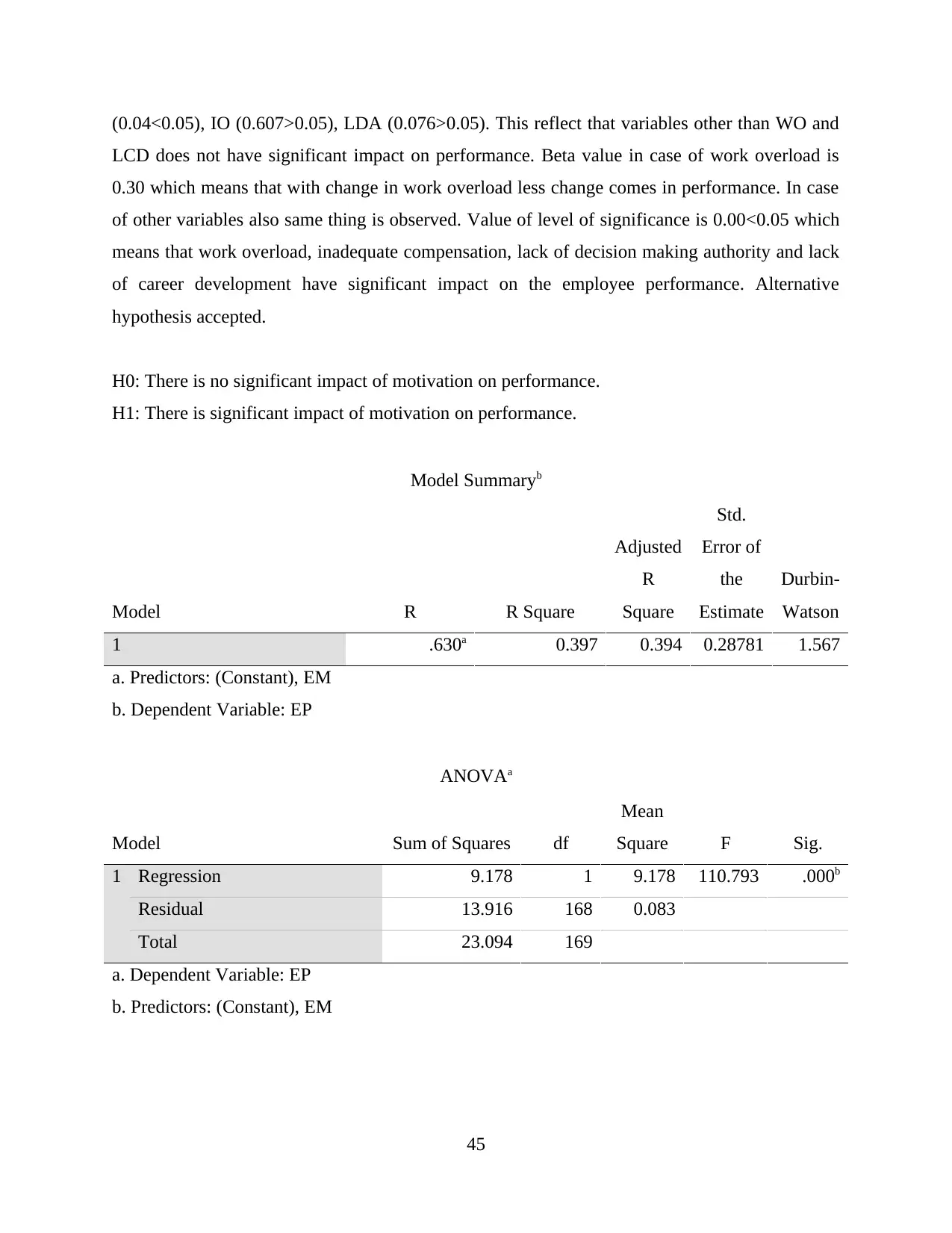
LCD does not have significant impact on performance. Beta value in case of work overload is
0.30 which means that with change in work overload less change comes in performance. In case
of other variables also same thing is observed. Value of level of significance is 0.00<0.05 which
means that work overload, inadequate compensation, lack of decision making authority and lack
of career development have significant impact on the employee performance. Alternative
hypothesis accepted.
H0: There is no significant impact of motivation on performance.
H1: There is significant impact of motivation on performance.
Model Summaryb
Model R R Square
Adjusted
R
Square
Std.
Error of
the
Estimate
Durbin-
Watson
1 .630a 0.397 0.394 0.28781 1.567
a. Predictors: (Constant), EM
b. Dependent Variable: EP
ANOVAa
Model Sum of Squares df
Mean
Square F Sig.
1 Regression 9.178 1 9.178 110.793 .000b
Residual 13.916 168 0.083
Total 23.094 169
a. Dependent Variable: EP
b. Predictors: (Constant), EM
45
Paraphrase This Document

variation in the dependent variable is explained by the independent variable. Value of level of
significance is 0.00<0.05 employee motivation has significant impact on employee performance.
Beta value is 0.685 which means that with change in motivation performance significantly get
changed. Alternative hypothesis accepted.
46
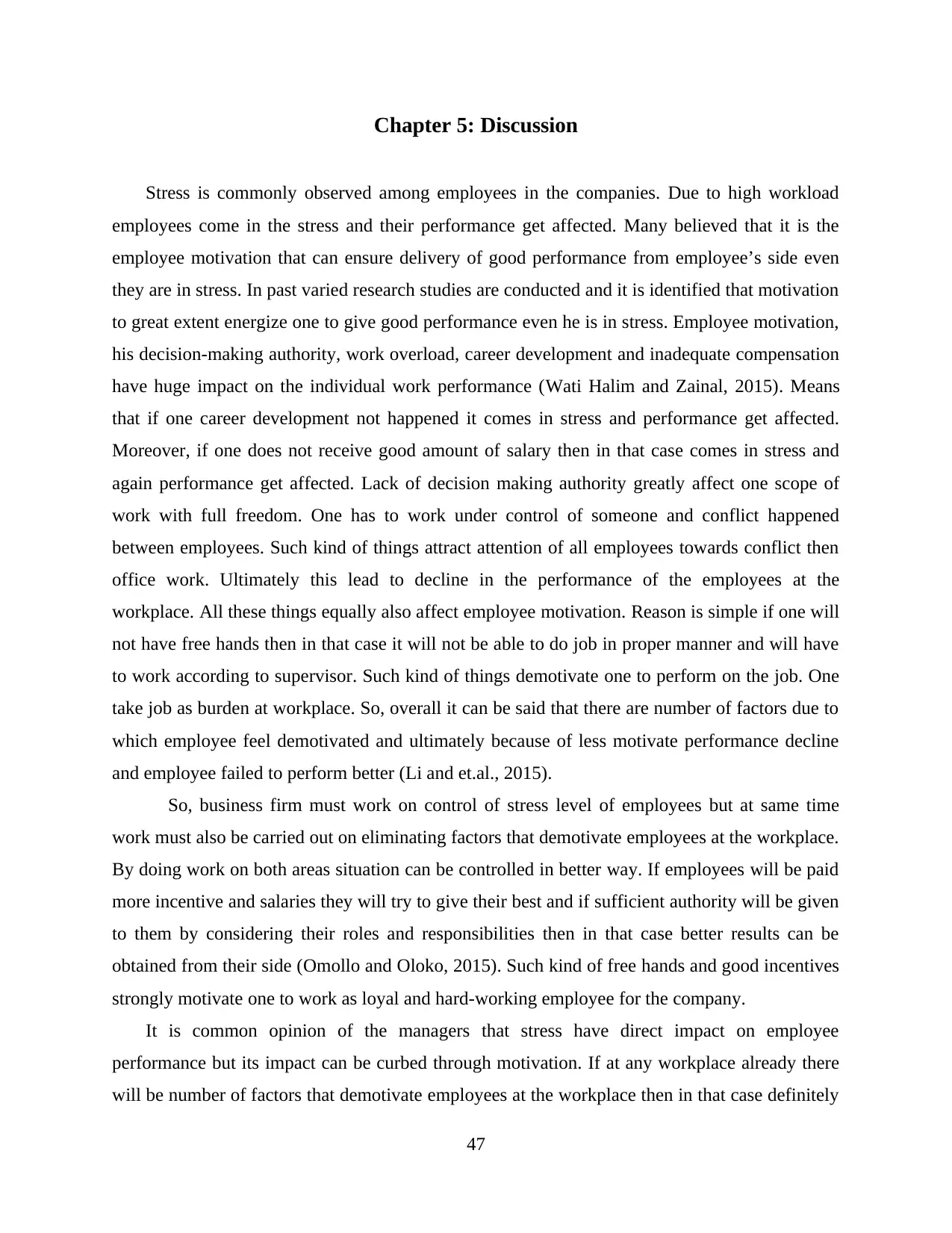
Stress is commonly observed among employees in the companies. Due to high workload
employees come in the stress and their performance get affected. Many believed that it is the
employee motivation that can ensure delivery of good performance from employee’s side even
they are in stress. In past varied research studies are conducted and it is identified that motivation
to great extent energize one to give good performance even he is in stress. Employee motivation,
his decision-making authority, work overload, career development and inadequate compensation
have huge impact on the individual work performance (Wati Halim and Zainal, 2015). Means
that if one career development not happened it comes in stress and performance get affected.
Moreover, if one does not receive good amount of salary then in that case comes in stress and
again performance get affected. Lack of decision making authority greatly affect one scope of
work with full freedom. One has to work under control of someone and conflict happened
between employees. Such kind of things attract attention of all employees towards conflict then
office work. Ultimately this lead to decline in the performance of the employees at the
workplace. All these things equally also affect employee motivation. Reason is simple if one will
not have free hands then in that case it will not be able to do job in proper manner and will have
to work according to supervisor. Such kind of things demotivate one to perform on the job. One
take job as burden at workplace. So, overall it can be said that there are number of factors due to
which employee feel demotivated and ultimately because of less motivate performance decline
and employee failed to perform better (Li and et.al., 2015).
So, business firm must work on control of stress level of employees but at same time
work must also be carried out on eliminating factors that demotivate employees at the workplace.
By doing work on both areas situation can be controlled in better way. If employees will be paid
more incentive and salaries they will try to give their best and if sufficient authority will be given
to them by considering their roles and responsibilities then in that case better results can be
obtained from their side (Omollo and Oloko, 2015). Such kind of free hands and good incentives
strongly motivate one to work as loyal and hard-working employee for the company.
It is common opinion of the managers that stress have direct impact on employee
performance but its impact can be curbed through motivation. If at any workplace already there
will be number of factors that demotivate employees at the workplace then in that case definitely
47
⊘ This is a preview!⊘
Do you want full access?
Subscribe today to unlock all pages.

Trusted by 1+ million students worldwide
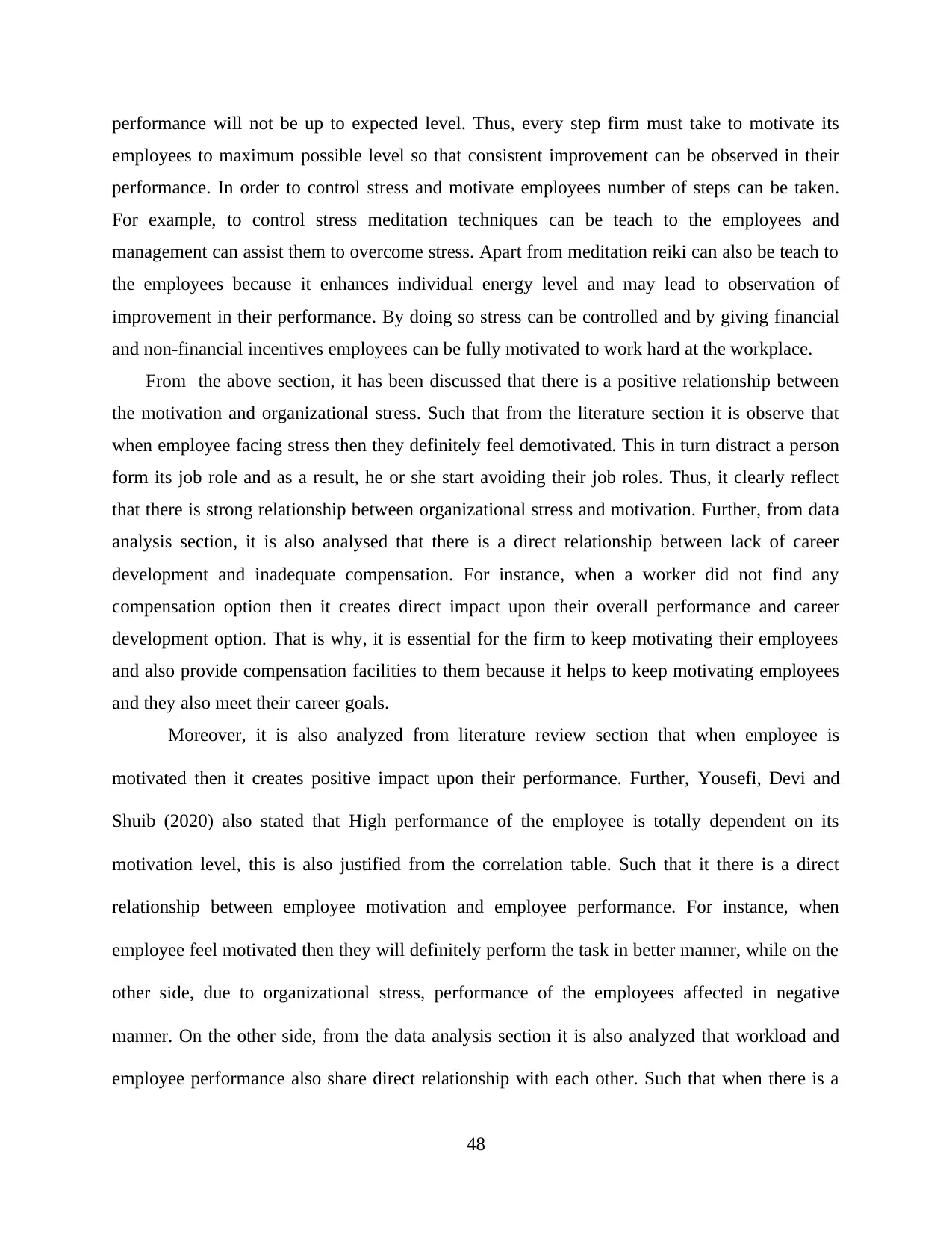
employees to maximum possible level so that consistent improvement can be observed in their
performance. In order to control stress and motivate employees number of steps can be taken.
For example, to control stress meditation techniques can be teach to the employees and
management can assist them to overcome stress. Apart from meditation reiki can also be teach to
the employees because it enhances individual energy level and may lead to observation of
improvement in their performance. By doing so stress can be controlled and by giving financial
and non-financial incentives employees can be fully motivated to work hard at the workplace.
From the above section, it has been discussed that there is a positive relationship between
the motivation and organizational stress. Such that from the literature section it is observe that
when employee facing stress then they definitely feel demotivated. This in turn distract a person
form its job role and as a result, he or she start avoiding their job roles. Thus, it clearly reflect
that there is strong relationship between organizational stress and motivation. Further, from data
analysis section, it is also analysed that there is a direct relationship between lack of career
development and inadequate compensation. For instance, when a worker did not find any
compensation option then it creates direct impact upon their overall performance and career
development option. That is why, it is essential for the firm to keep motivating their employees
and also provide compensation facilities to them because it helps to keep motivating employees
and they also meet their career goals.
Moreover, it is also analyzed from literature review section that when employee is
motivated then it creates positive impact upon their performance. Further, Yousefi, Devi and
Shuib (2020) also stated that High performance of the employee is totally dependent on its
motivation level, this is also justified from the correlation table. Such that it there is a direct
relationship between employee motivation and employee performance. For instance, when
employee feel motivated then they will definitely perform the task in better manner, while on the
other side, due to organizational stress, performance of the employees affected in negative
manner. On the other side, from the data analysis section it is also analyzed that workload and
employee performance also share direct relationship with each other. Such that when there is a
48
Paraphrase This Document
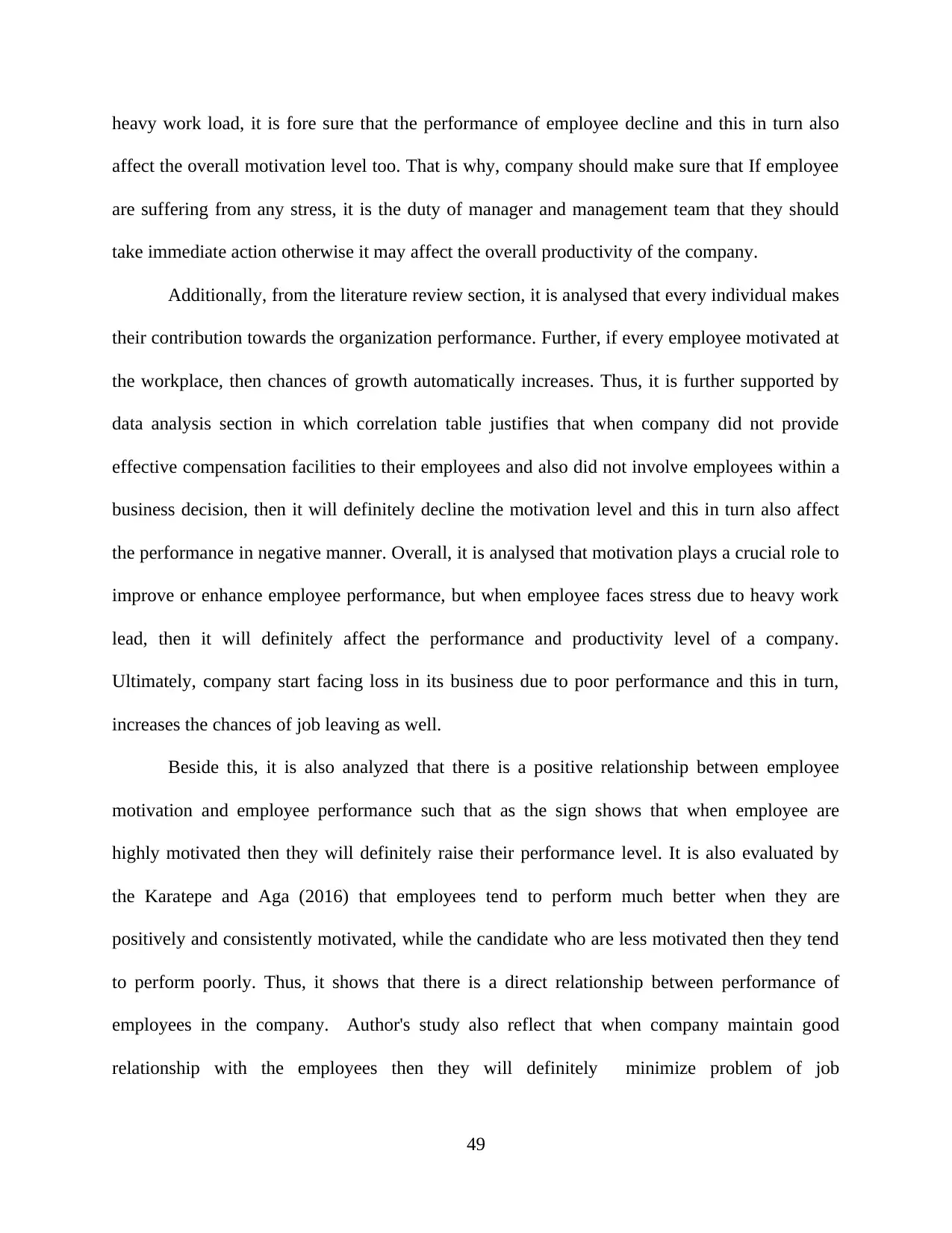
affect the overall motivation level too. That is why, company should make sure that If employee
are suffering from any stress, it is the duty of manager and management team that they should
take immediate action otherwise it may affect the overall productivity of the company.
Additionally, from the literature review section, it is analysed that every individual makes
their contribution towards the organization performance. Further, if every employee motivated at
the workplace, then chances of growth automatically increases. Thus, it is further supported by
data analysis section in which correlation table justifies that when company did not provide
effective compensation facilities to their employees and also did not involve employees within a
business decision, then it will definitely decline the motivation level and this in turn also affect
the performance in negative manner. Overall, it is analysed that motivation plays a crucial role to
improve or enhance employee performance, but when employee faces stress due to heavy work
lead, then it will definitely affect the performance and productivity level of a company.
Ultimately, company start facing loss in its business due to poor performance and this in turn,
increases the chances of job leaving as well.
Beside this, it is also analyzed that there is a positive relationship between employee
motivation and employee performance such that as the sign shows that when employee are
highly motivated then they will definitely raise their performance level. It is also evaluated by
the Karatepe and Aga (2016) that employees tend to perform much better when they are
positively and consistently motivated, while the candidate who are less motivated then they tend
to perform poorly. Thus, it shows that there is a direct relationship between performance of
employees in the company. Author's study also reflect that when company maintain good
relationship with the employees then they will definitely minimize problem of job
49
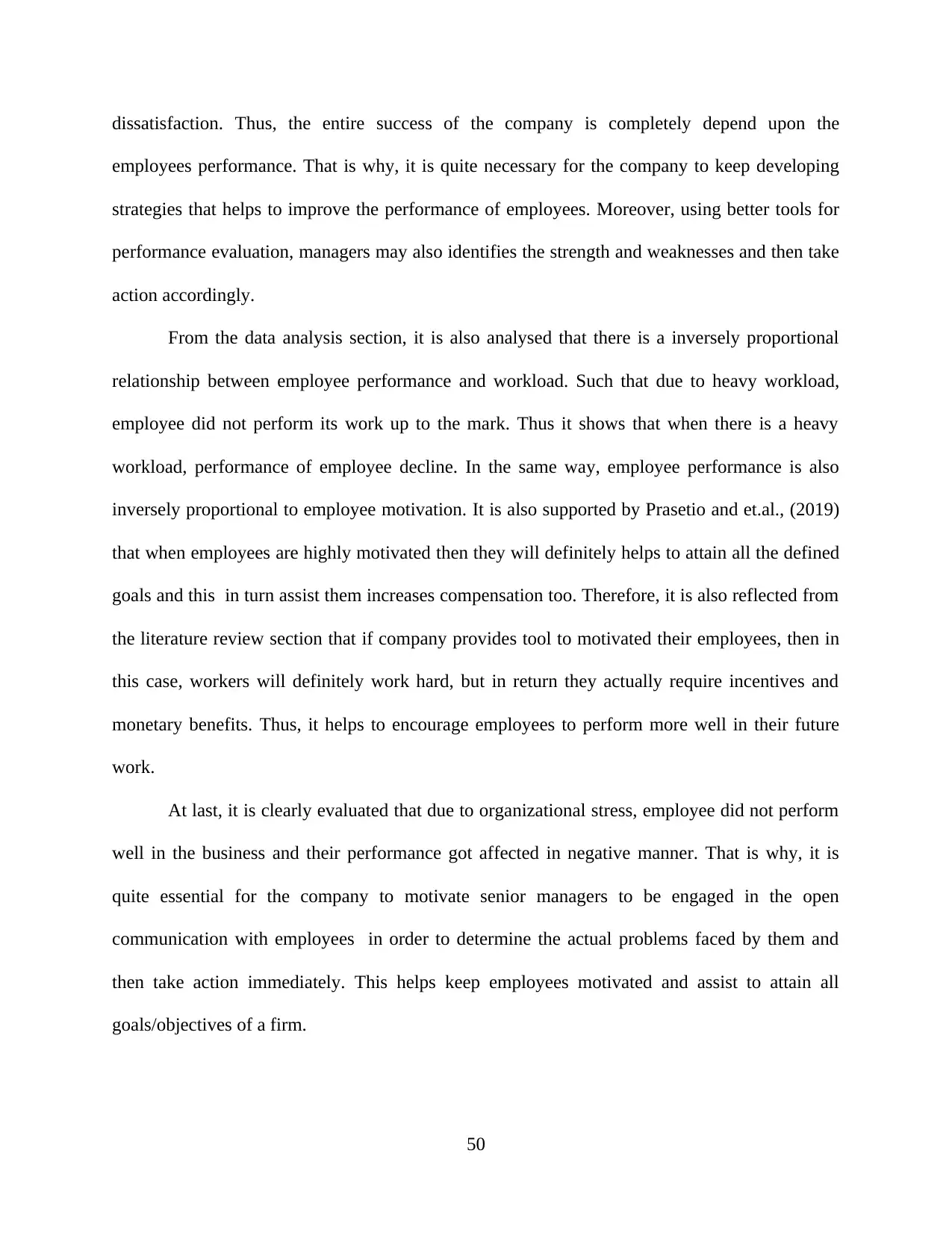
employees performance. That is why, it is quite necessary for the company to keep developing
strategies that helps to improve the performance of employees. Moreover, using better tools for
performance evaluation, managers may also identifies the strength and weaknesses and then take
action accordingly.
From the data analysis section, it is also analysed that there is a inversely proportional
relationship between employee performance and workload. Such that due to heavy workload,
employee did not perform its work up to the mark. Thus it shows that when there is a heavy
workload, performance of employee decline. In the same way, employee performance is also
inversely proportional to employee motivation. It is also supported by Prasetio and et.al., (2019)
that when employees are highly motivated then they will definitely helps to attain all the defined
goals and this in turn assist them increases compensation too. Therefore, it is also reflected from
the literature review section that if company provides tool to motivated their employees, then in
this case, workers will definitely work hard, but in return they actually require incentives and
monetary benefits. Thus, it helps to encourage employees to perform more well in their future
work.
At last, it is clearly evaluated that due to organizational stress, employee did not perform
well in the business and their performance got affected in negative manner. That is why, it is
quite essential for the company to motivate senior managers to be engaged in the open
communication with employees in order to determine the actual problems faced by them and
then take action immediately. This helps keep employees motivated and assist to attain all
goals/objectives of a firm.
50
⊘ This is a preview!⊘
Do you want full access?
Subscribe today to unlock all pages.

Trusted by 1+ million students worldwide

5.1 Conclusion
The entire research that was conducted above on the role of employee motivation on minimizing
the employee performance and their stress level help in concluding that stress f the employees is
regularly Rising and hence their exists an inverse relation between the employee stress level and
their performance level. As the stress level in the employee increases, it automatically leads to a
lower performance level.
The purpose due to which this research was carried was to help the organizations in recognizing
that whether their employees are stressed or not and up to what level, it is affecting the
performance of such stressed employees in the company. Through the literature review section, it
can be concluded that the employee motivation can be enhanced by the implementation of
various tools and techniques or different models. The Herzberg two factor theory was critically
analysed where the researcher concluded that this theory helps the managers of developing the
quality of multi Skilling as the employee works on multiple platforms simultaneously and thus
they become more motivated to work harder and more dedicatedly trying to achieve the
organizational objectives. This theory was then compared to various other theories and the
factors associated with such theories of employee motivation which helped in ascertaining that
different models have different pro and cons that are inherent to each one of them. Through
every theory was found to have some faults.
The literature review section analysed various theories as well that were associated to the
employee motivation and it was found that the key performance indicator could be declared as
the best tool that could be used in measuring the employee performance and further, the Effort
Reward Imbalance Model was found to be the best model that could help in reducing the
organizational stress and therefore, it was concluded that both of them could be collectively used
to manage the problem of declining employee performance due to increasing stress levels. It was
further concluded in the research undertaken above in analysing that the stress depicts that the
employee is dissatisfied from the practice that are adopted in the organization and sometimes
organizational policies is not the directly affecting factors but the peer pressure contributes
majorly. It was concluded that when the informal communication in the organization was either
stringent or there was a lack of any sense of belonging in the company then it often tends to
leave employee feeling disrespected and therefore dissatisfied thus affecting the performance. It
51
Paraphrase This Document
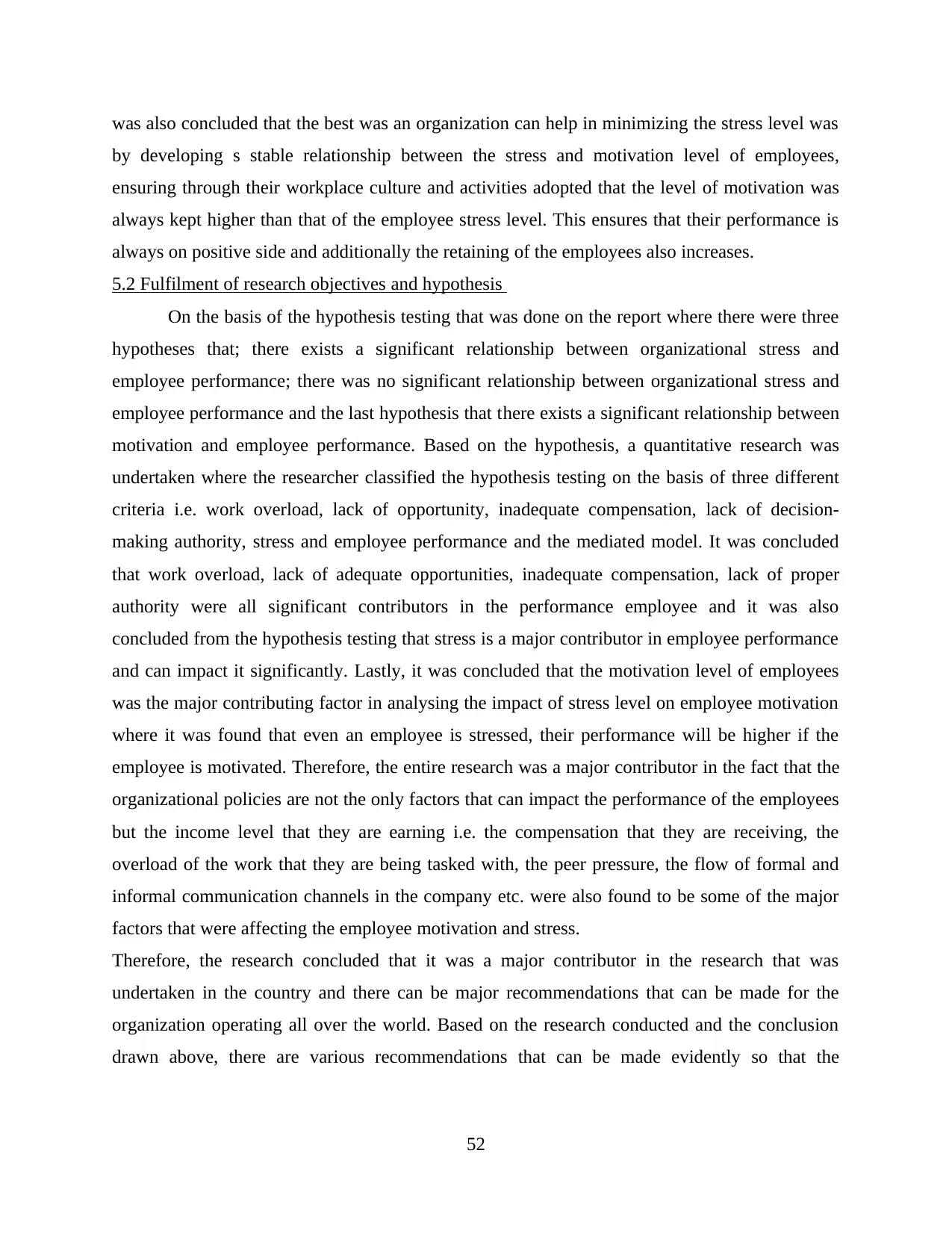
by developing s stable relationship between the stress and motivation level of employees,
ensuring through their workplace culture and activities adopted that the level of motivation was
always kept higher than that of the employee stress level. This ensures that their performance is
always on positive side and additionally the retaining of the employees also increases.
5.2 Fulfilment of research objectives and hypothesis
On the basis of the hypothesis testing that was done on the report where there were three
hypotheses that; there exists a significant relationship between organizational stress and
employee performance; there was no significant relationship between organizational stress and
employee performance and the last hypothesis that there exists a significant relationship between
motivation and employee performance. Based on the hypothesis, a quantitative research was
undertaken where the researcher classified the hypothesis testing on the basis of three different
criteria i.e. work overload, lack of opportunity, inadequate compensation, lack of decision-
making authority, stress and employee performance and the mediated model. It was concluded
that work overload, lack of adequate opportunities, inadequate compensation, lack of proper
authority were all significant contributors in the performance employee and it was also
concluded from the hypothesis testing that stress is a major contributor in employee performance
and can impact it significantly. Lastly, it was concluded that the motivation level of employees
was the major contributing factor in analysing the impact of stress level on employee motivation
where it was found that even an employee is stressed, their performance will be higher if the
employee is motivated. Therefore, the entire research was a major contributor in the fact that the
organizational policies are not the only factors that can impact the performance of the employees
but the income level that they are earning i.e. the compensation that they are receiving, the
overload of the work that they are being tasked with, the peer pressure, the flow of formal and
informal communication channels in the company etc. were also found to be some of the major
factors that were affecting the employee motivation and stress.
Therefore, the research concluded that it was a major contributor in the research that was
undertaken in the country and there can be major recommendations that can be made for the
organization operating all over the world. Based on the research conducted and the conclusion
drawn above, there are various recommendations that can be made evidently so that the
52

level as well.
5.3 Recommendations
At the time of increased workload, employee's performance got affected and that is why,
to overcome such situation, it is recommanded to the firm that sometimes, it should
provide flexibility to their employees which keep motivating them and this in turn also
helps to manage time and employee performance.
Further, when Manager of the firm appreciate their employees when they perform good
work and this in turn, helps to motivate their employees and sustain long term
relationship with company as well. This good practice creates positive impact upon the
performance of a business and this in turn provide range of growth options in near future.
In order to deal with inadequate compensation and lack of career development, it is
recommended to the firm that company's manager provide effective training system to
their employees so that it will help the employees to increases the working performance
and this in turn also raise the business brand image at global level. Moreover, manager
may improve the employee control over the way they do their work by consulting about
the working practices by add new features or remove old practices. This also creates
positive impact upon business and provides positive working environment as well.
Moreover, for enhance motivation level of employees, it is also recommended to the firm
that it may provide incentives and extra monetary benefits to the employees, so that it
will help to keep motivating employees. It is further supported by Giauque, Anderfuhren-
Biget and Varone (2019) that if company provide extra facilities in terms of monetary
and non- monetary benefits, company easily motivating their employees and maintain
long term relationship as well. Along with this, company will easily enhance their
productivity level and this in turns raise production level which helps to improve the
financial performance. Hence, it is observe that by providing extra benefits to the
employees will also assist to motivate the employees. That is why, employee motivation
is used as a tool that helps to reduce stress among them.
It is to be recommended to the firm that by offering flexible work environment to the
employees, organizational stress can be reduced, therefore, it also leads to enhance the
employee performance. Such that this technique helps to boost their morale and this in
53
⊘ This is a preview!⊘
Do you want full access?
Subscribe today to unlock all pages.

Trusted by 1+ million students worldwide

performance. It is also analysed that flexible working environment also increases job
satisfaction and also improve the work/life balance as well.
Moreover, it is also recommended to the firm that by providing effective training session
to their employees will help to reduce organizational stress among workers. Such that
during training session, company may easily motivated their employees and helps to
identify the skills which need to be developed. Further, it is clear that there is a close
relationship between organization stress and motivation. Such that if the employee is
facing stress then their motivation level decline sharply. That is why by providing
effective training session to the employees will help to keep enhancing employee's skills
and motivate them to perform best for the company.
Additionally, it is also recommended to the firm to promote innovation and enhance work
design as well. It is so because in this modern era, the demands and need of people are
changes and that is why, management of the company should make sure that employees
are also developed as per the need. Further, the era is completely based upon advance
things and that is why, company also promote innovation. For that manager has to hire
those candidate who may easily provide new products which in turn assist to work for a
longer time. Or else, company may introduce activities that provide a chance to exploring
employee's abilities.
5.4 Implication for future research
In the current research, scholar did study by taking into account sample of 201 personnel,
working as full time employees within an organization. Thus, in the near future
researcher will definitely increase the sample size so that it will help to get results in
more effective manner. Further, as per the time available scholar should conduct study on
approx. 400-500 personnel which assists in highlighting suitable factors that affects
motivation of majority of personnel. By this, scholar also would become able to identify
the variable that may cause of employee stress and demotivation.
As current report describe different variables and but in near future researcher will take
more factors such that, conflict, team behaviour, culture, structure, team hierarchy etc.
in future, researcher will used qualitative methodology under which interview will be
taken that helps to clearly communicate with specialist workers directly.
54
Paraphrase This Document

also assist the researcher to conclude the results in effective manner. Such that for the
current study, researcher used motivation as a mediated variables, then it future they use
measurement tools to analyse the performance of employees.
It is also recommended to use CFA and SEM as a SPSS amos rather than EFA.
5.5 Limitation of the study
Although the research was constrained only to the employees working in Malaysia, yet the
conclusions can be made on a more generalized basis where the employees working in
companies all over the world are facing similar problems related to work stress. The conclusions
that were drawn related to the problem of declining employee performance due to increasing
work pressure and stress levels can therefore be linked to the employee motivation but on a
broader level , it can be clearly stated that this is also not an adequate solution because stressful
situation is not directly associated with only the employee motivation aspect but there are a
series of aspects that the need to consider before developing a policy. The work culture, HR
policies, working environment and flexibility were found to another set of major determinants of
employee stress level and their performance.
55
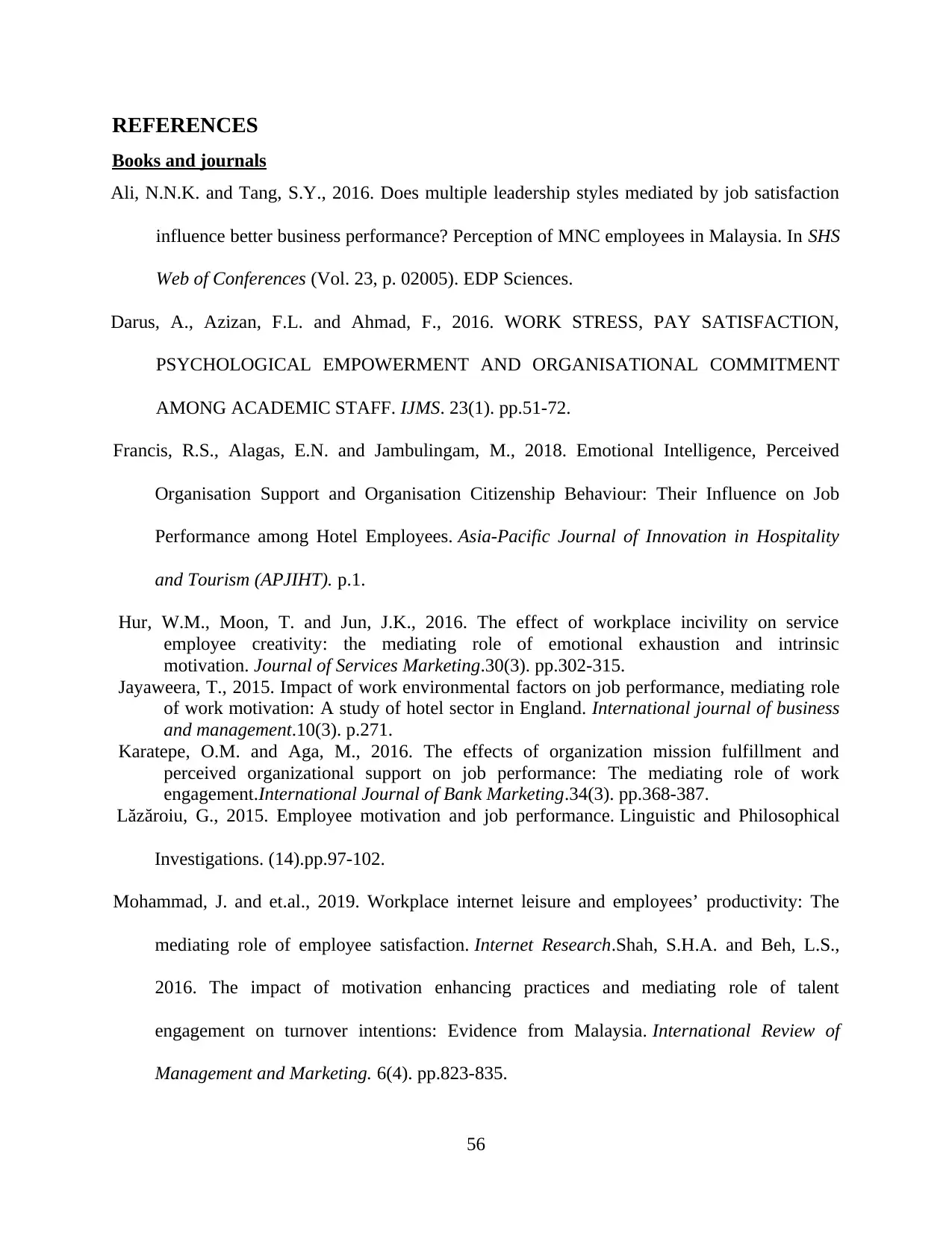
Books and journals
Ali, N.N.K. and Tang, S.Y., 2016. Does multiple leadership styles mediated by job satisfaction
influence better business performance? Perception of MNC employees in Malaysia. In SHS
Web of Conferences (Vol. 23, p. 02005). EDP Sciences.
Darus, A., Azizan, F.L. and Ahmad, F., 2016. WORK STRESS, PAY SATISFACTION,
PSYCHOLOGICAL EMPOWERMENT AND ORGANISATIONAL COMMITMENT
AMONG ACADEMIC STAFF. IJMS. 23(1). pp.51-72.
Francis, R.S., Alagas, E.N. and Jambulingam, M., 2018. Emotional Intelligence, Perceived
Organisation Support and Organisation Citizenship Behaviour: Their Influence on Job
Performance among Hotel Employees. Asia-Pacific Journal of Innovation in Hospitality
and Tourism (APJIHT). p.1.
Hur, W.M., Moon, T. and Jun, J.K., 2016. The effect of workplace incivility on service
employee creativity: the mediating role of emotional exhaustion and intrinsic
motivation. Journal of Services Marketing.30(3). pp.302-315.
Jayaweera, T., 2015. Impact of work environmental factors on job performance, mediating role
of work motivation: A study of hotel sector in England. International journal of business
and management.10(3). p.271.
Karatepe, O.M. and Aga, M., 2016. The effects of organization mission fulfillment and
perceived organizational support on job performance: The mediating role of work
engagement.International Journal of Bank Marketing.34(3). pp.368-387.
Lăzăroiu, G., 2015. Employee motivation and job performance. Linguistic and Philosophical
Investigations. (14).pp.97-102.
Mohammad, J. and et.al., 2019. Workplace internet leisure and employees’ productivity: The
mediating role of employee satisfaction. Internet Research.Shah, S.H.A. and Beh, L.S.,
2016. The impact of motivation enhancing practices and mediating role of talent
engagement on turnover intentions: Evidence from Malaysia. International Review of
Management and Marketing. 6(4). pp.823-835.
56
⊘ This is a preview!⊘
Do you want full access?
Subscribe today to unlock all pages.

Trusted by 1+ million students worldwide
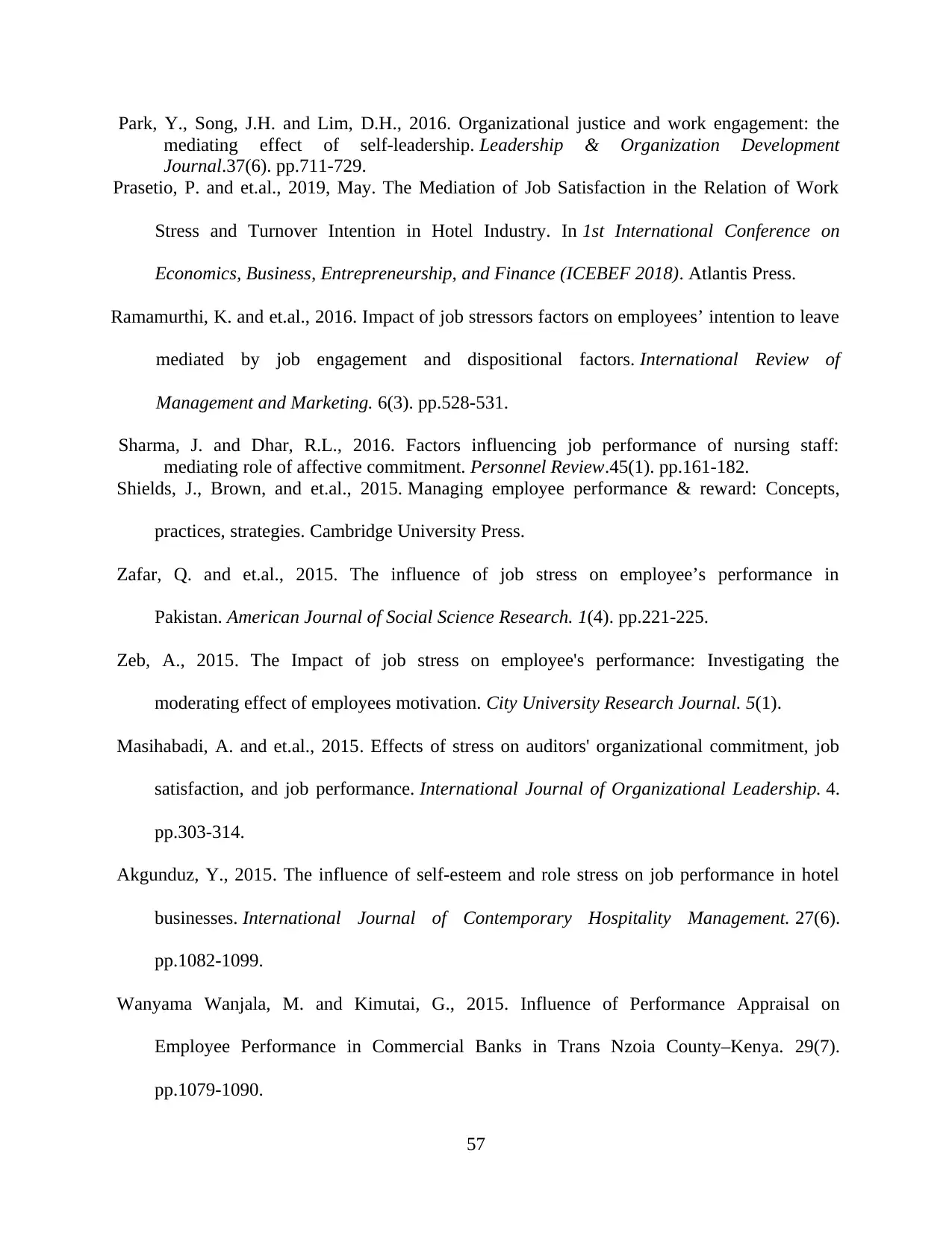
mediating effect of self-leadership. Leadership & Organization Development
Journal.37(6). pp.711-729.
Prasetio, P. and et.al., 2019, May. The Mediation of Job Satisfaction in the Relation of Work
Stress and Turnover Intention in Hotel Industry. In 1st International Conference on
Economics, Business, Entrepreneurship, and Finance (ICEBEF 2018). Atlantis Press.
Ramamurthi, K. and et.al., 2016. Impact of job stressors factors on employees’ intention to leave
mediated by job engagement and dispositional factors. International Review of
Management and Marketing. 6(3). pp.528-531.
Sharma, J. and Dhar, R.L., 2016. Factors influencing job performance of nursing staff:
mediating role of affective commitment. Personnel Review.45(1). pp.161-182.
Shields, J., Brown, and et.al., 2015. Managing employee performance & reward: Concepts,
practices, strategies. Cambridge University Press.
Zafar, Q. and et.al., 2015. The influence of job stress on employee’s performance in
Pakistan. American Journal of Social Science Research. 1(4). pp.221-225.
Zeb, A., 2015. The Impact of job stress on employee's performance: Investigating the
moderating effect of employees motivation. City University Research Journal. 5(1).
Masihabadi, A. and et.al., 2015. Effects of stress on auditors' organizational commitment, job
satisfaction, and job performance. International Journal of Organizational Leadership. 4.
pp.303-314.
Akgunduz, Y., 2015. The influence of self-esteem and role stress on job performance in hotel
businesses. International Journal of Contemporary Hospitality Management. 27(6).
pp.1082-1099.
Wanyama Wanjala, M. and Kimutai, G., 2015. Influence of Performance Appraisal on
Employee Performance in Commercial Banks in Trans Nzoia County–Kenya. 29(7).
pp.1079-1090.
57
Paraphrase This Document
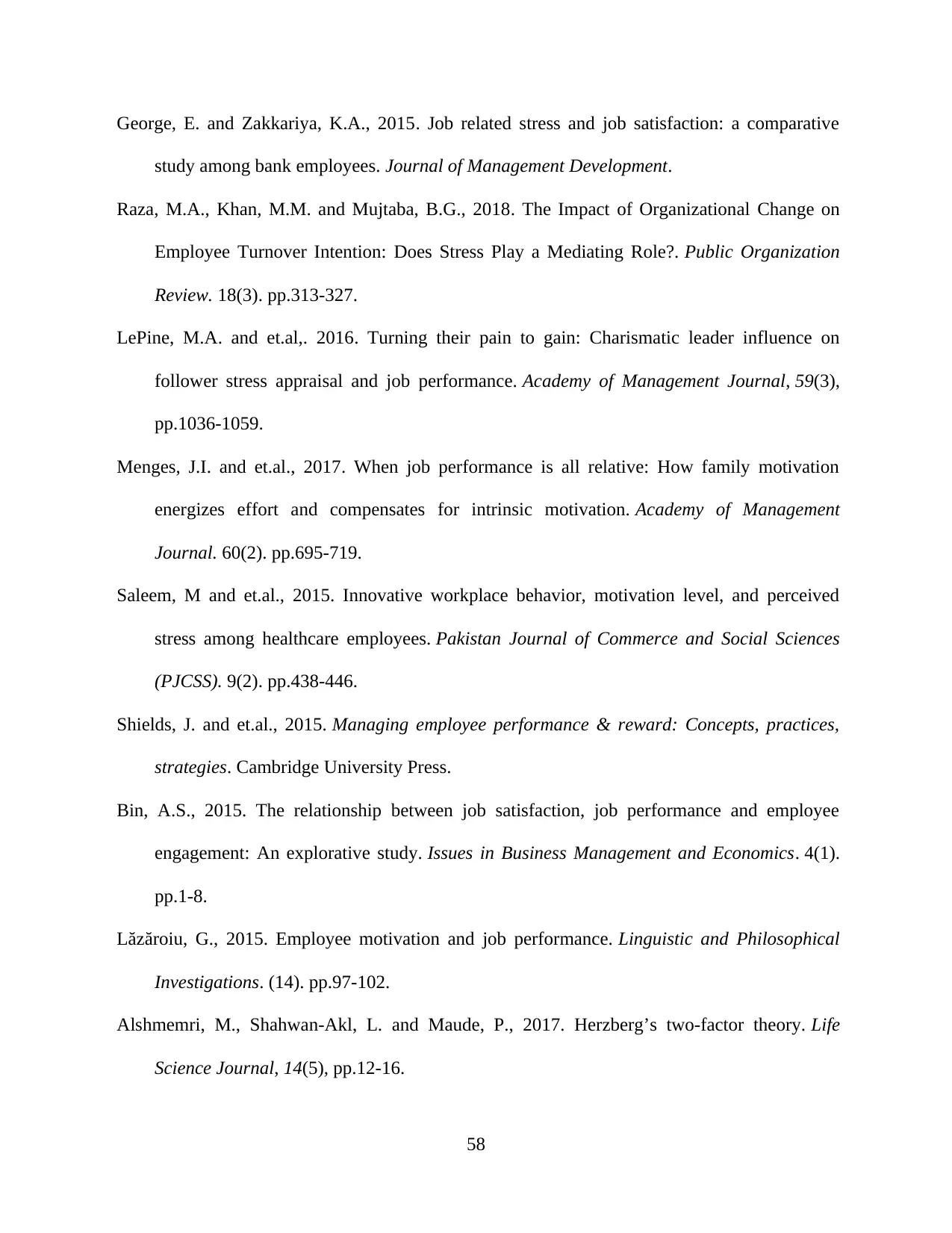
study among bank employees. Journal of Management Development.
Raza, M.A., Khan, M.M. and Mujtaba, B.G., 2018. The Impact of Organizational Change on
Employee Turnover Intention: Does Stress Play a Mediating Role?. Public Organization
Review. 18(3). pp.313-327.
LePine, M.A. and et.al,. 2016. Turning their pain to gain: Charismatic leader influence on
follower stress appraisal and job performance. Academy of Management Journal, 59(3),
pp.1036-1059.
Menges, J.I. and et.al., 2017. When job performance is all relative: How family motivation
energizes effort and compensates for intrinsic motivation. Academy of Management
Journal. 60(2). pp.695-719.
Saleem, M and et.al., 2015. Innovative workplace behavior, motivation level, and perceived
stress among healthcare employees. Pakistan Journal of Commerce and Social Sciences
(PJCSS). 9(2). pp.438-446.
Shields, J. and et.al., 2015. Managing employee performance & reward: Concepts, practices,
strategies. Cambridge University Press.
Bin, A.S., 2015. The relationship between job satisfaction, job performance and employee
engagement: An explorative study. Issues in Business Management and Economics. 4(1).
pp.1-8.
Lăzăroiu, G., 2015. Employee motivation and job performance. Linguistic and Philosophical
Investigations. (14). pp.97-102.
Alshmemri, M., Shahwan-Akl, L. and Maude, P., 2017. Herzberg’s two-factor theory. Life
Science Journal, 14(5), pp.12-16.
58
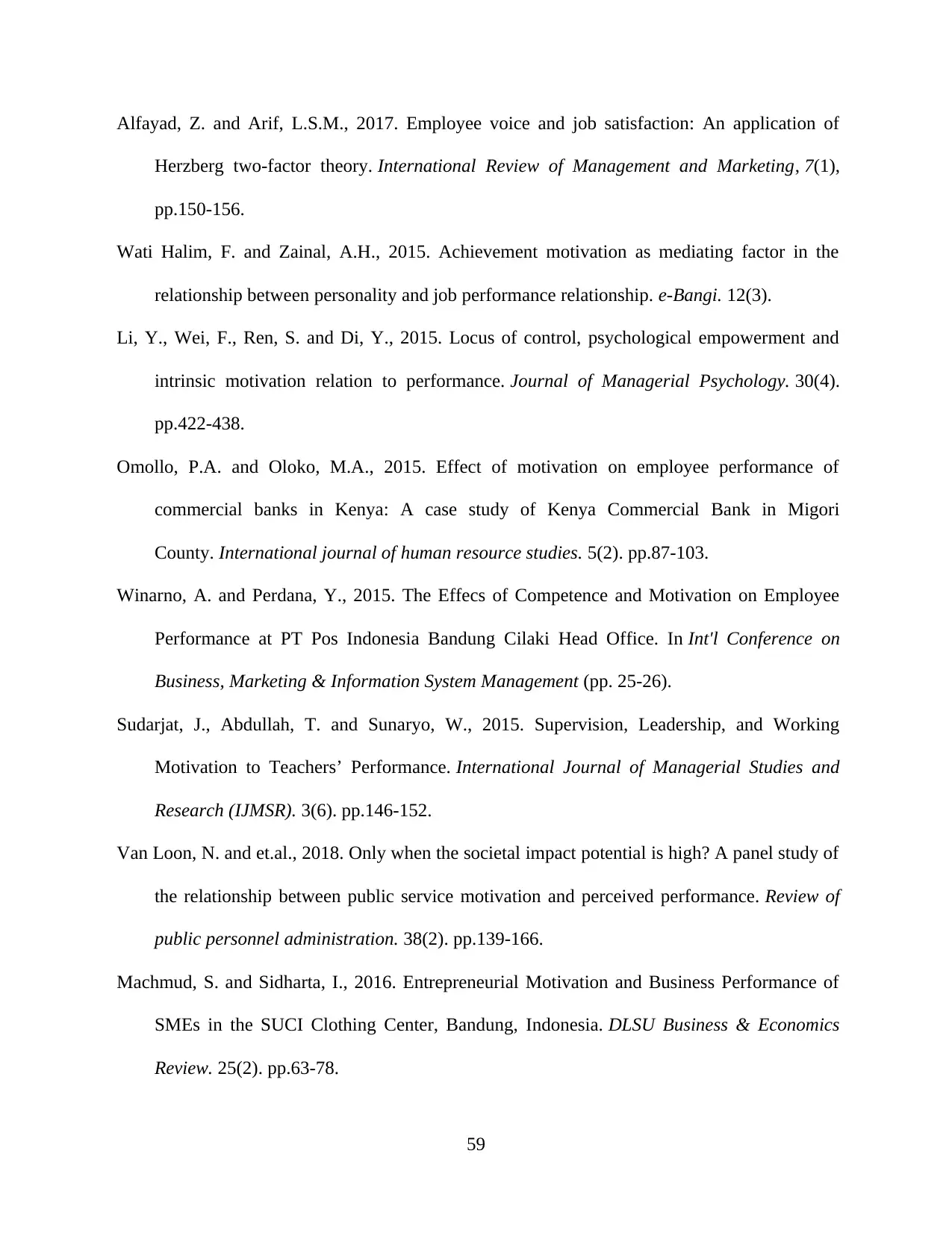
Herzberg two-factor theory. International Review of Management and Marketing, 7(1),
pp.150-156.
Wati Halim, F. and Zainal, A.H., 2015. Achievement motivation as mediating factor in the
relationship between personality and job performance relationship. e-Bangi. 12(3).
Li, Y., Wei, F., Ren, S. and Di, Y., 2015. Locus of control, psychological empowerment and
intrinsic motivation relation to performance. Journal of Managerial Psychology. 30(4).
pp.422-438.
Omollo, P.A. and Oloko, M.A., 2015. Effect of motivation on employee performance of
commercial banks in Kenya: A case study of Kenya Commercial Bank in Migori
County. International journal of human resource studies. 5(2). pp.87-103.
Winarno, A. and Perdana, Y., 2015. The Effecs of Competence and Motivation on Employee
Performance at PT Pos Indonesia Bandung Cilaki Head Office. In Int'l Conference on
Business, Marketing & Information System Management (pp. 25-26).
Sudarjat, J., Abdullah, T. and Sunaryo, W., 2015. Supervision, Leadership, and Working
Motivation to Teachers’ Performance. International Journal of Managerial Studies and
Research (IJMSR). 3(6). pp.146-152.
Van Loon, N. and et.al., 2018. Only when the societal impact potential is high? A panel study of
the relationship between public service motivation and perceived performance. Review of
public personnel administration. 38(2). pp.139-166.
Machmud, S. and Sidharta, I., 2016. Entrepreneurial Motivation and Business Performance of
SMEs in the SUCI Clothing Center, Bandung, Indonesia. DLSU Business & Economics
Review. 25(2). pp.63-78.
59
⊘ This is a preview!⊘
Do you want full access?
Subscribe today to unlock all pages.

Trusted by 1+ million students worldwide
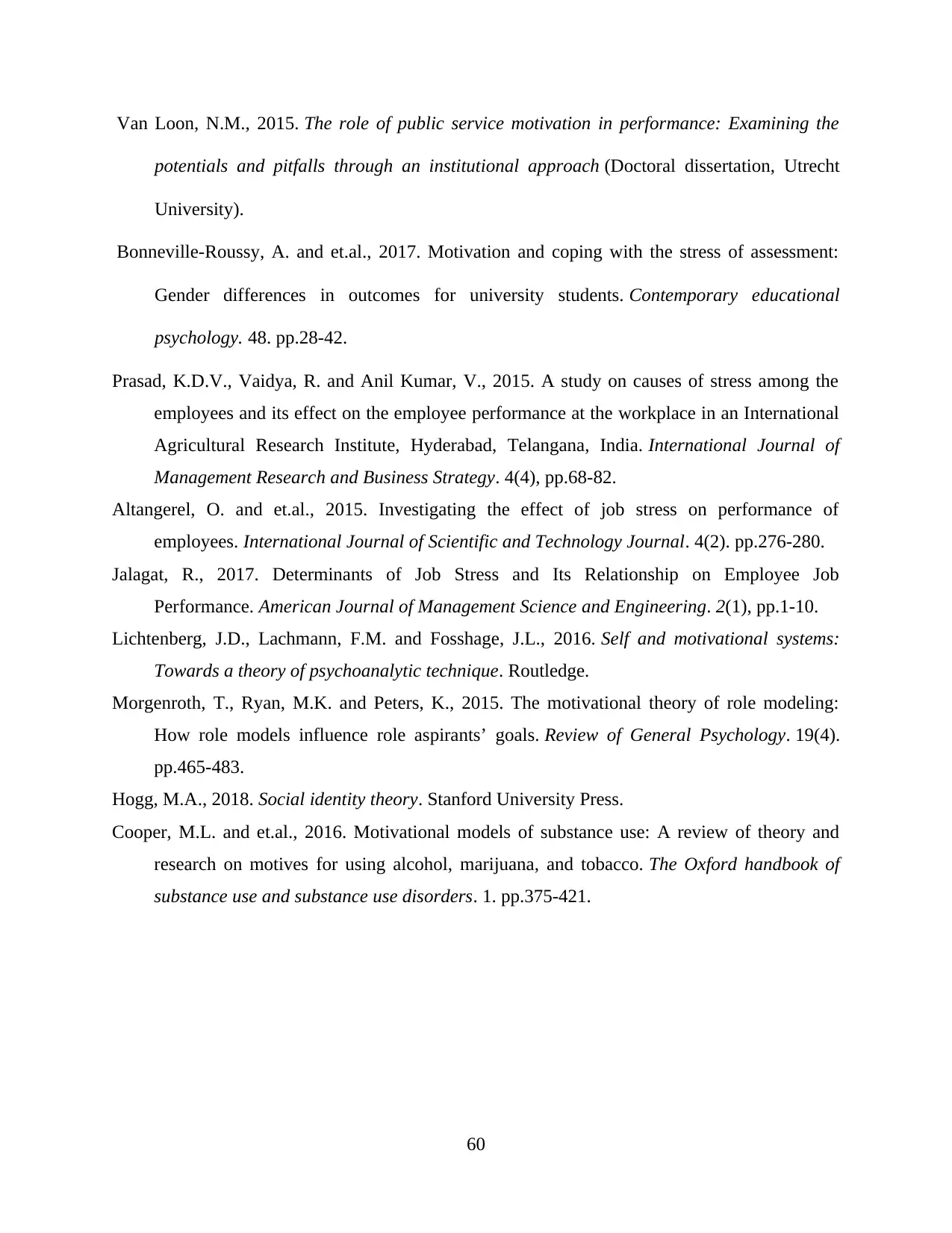
potentials and pitfalls through an institutional approach (Doctoral dissertation, Utrecht
University).
Bonneville-Roussy, A. and et.al., 2017. Motivation and coping with the stress of assessment:
Gender differences in outcomes for university students. Contemporary educational
psychology. 48. pp.28-42.
Prasad, K.D.V., Vaidya, R. and Anil Kumar, V., 2015. A study on causes of stress among the
employees and its effect on the employee performance at the workplace in an International
Agricultural Research Institute, Hyderabad, Telangana, India. International Journal of
Management Research and Business Strategy. 4(4), pp.68-82.
Altangerel, O. and et.al., 2015. Investigating the effect of job stress on performance of
employees. International Journal of Scientific and Technology Journal. 4(2). pp.276-280.
Jalagat, R., 2017. Determinants of Job Stress and Its Relationship on Employee Job
Performance. American Journal of Management Science and Engineering. 2(1), pp.1-10.
Lichtenberg, J.D., Lachmann, F.M. and Fosshage, J.L., 2016. Self and motivational systems:
Towards a theory of psychoanalytic technique. Routledge.
Morgenroth, T., Ryan, M.K. and Peters, K., 2015. The motivational theory of role modeling:
How role models influence role aspirants’ goals. Review of General Psychology. 19(4).
pp.465-483.
Hogg, M.A., 2018. Social identity theory. Stanford University Press.
Cooper, M.L. and et.al., 2016. Motivational models of substance use: A review of theory and
research on motives for using alcohol, marijuana, and tobacco. The Oxford handbook of
substance use and substance use disorders. 1. pp.375-421.
60
Paraphrase This Document

Author year Title Variables Methodology Sample
size
Findings
positive and
negative
Zafar, Q.
and et.al.,
2015
The influence of
job stress on
employee’s
performance in
Pakistan.
job stress,
employee’s
performance.
Non-
probability
sampling
method is
used.
Regression
analysis and
correlation
approach is
used to
investigate
relationship.
Sample
size is 250.
Finding is that
there is
positive
relationship
between stress
and employee
performance.
Zeb, A.,
2015
The Impact of job
stress on
employee's
performance:
Investigating the
moderating effect
of employee’s
motivation
job stress,
employee’s
performance.
Random
sampling
method is
used.
Regression
analysis and
correlation
approach is
used to
investigate
relationship.
Sample
size is 200.
Finding is that
there is
negative
relationship
between stress
and employee
performance.
Masihabadi,
A. and
et.al., 2015
Effects of stress on
auditors'
organizational
commitment, job
Stress,
organizational
commitment,
job
Random
sampling
method is
used.
Sample
size is 170
Finding is that
Job stress via
organizational
commitment
61

job performance
satisfaction,
and job
performance
Regression
analysis
approach is
used to
investigate
relationship.
and job
satisfaction
affected job
performance
negatively
Akgunduz,
Y., 2015
The influence of
self-esteem and
role stress on job
performance in
hotel businesses
self-esteem,
stress, job
performance
Random
sampling
method is
used.
Regression
analysis
approach is
used to
investigate
relationship.
Sample
size is 227.
Finding is that
Job stress had
affected job
performance
negatively.
Wanyama
Wanjala,
M. and
Kimutai,
G., 2015
Influence of
Performance
Appraisal on
Employee
Performance in
Commercial Banks
in Trans Nzoia
County–Kenya
Performance
Appraisal,
Employee
Performance
Random
sampling
method is
used. Chi
square
approach is
used to
investigate
relationship.
Sample
size is 178.
Finding is that
Job stress had
affected job
performance
negatively.
George, E.
and
Zakkariya,
K.A., 2015
Job related stress
and job
satisfaction: a
comparative study
among bank
employees
stress and job
satisfaction
Random
sampling
method is
used.
ANOVA
approach is
Sample
size is 337.
Finding is that
Job stress had
affected job
performance
negatively
62
⊘ This is a preview!⊘
Do you want full access?
Subscribe today to unlock all pages.

Trusted by 1+ million students worldwide
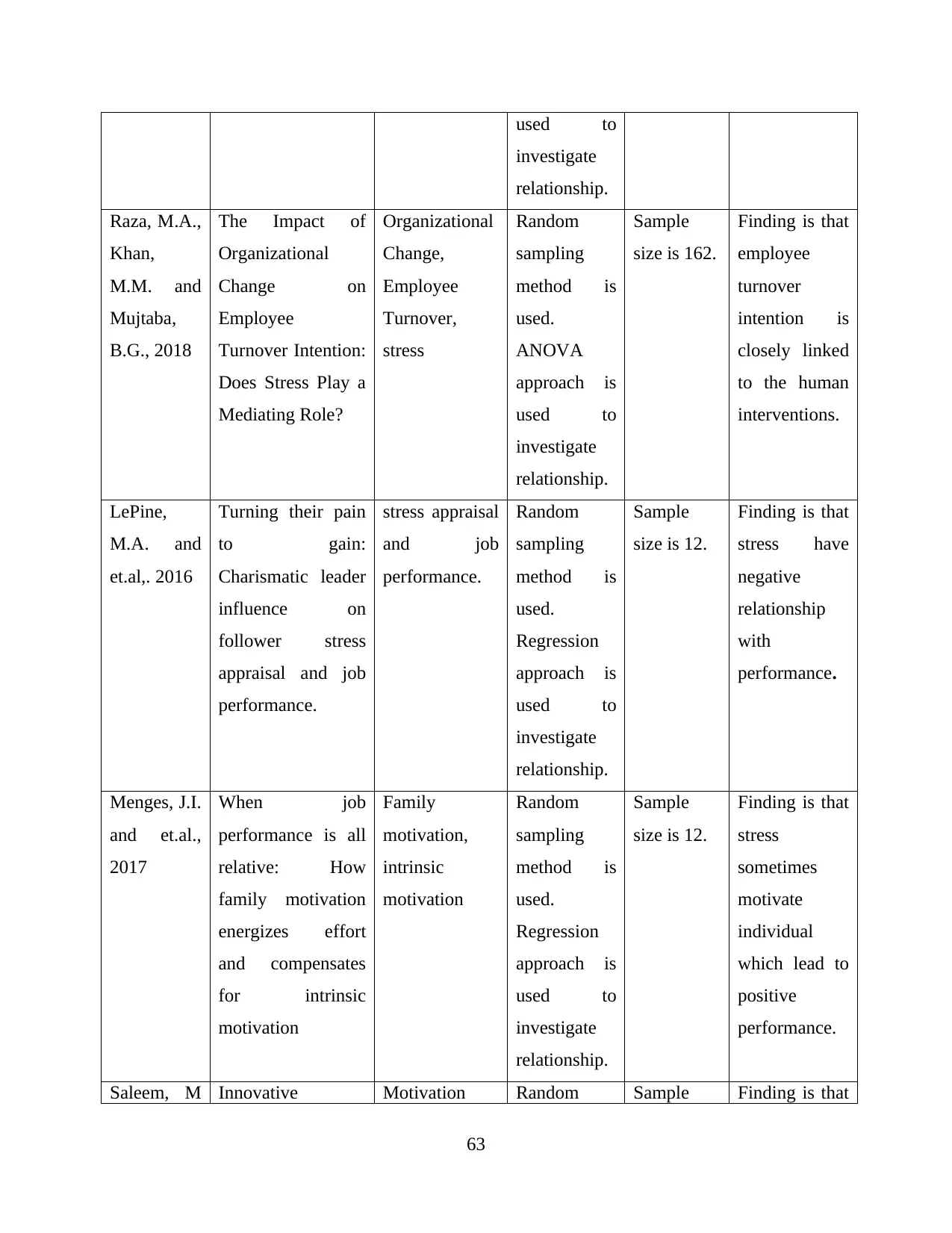
investigate
relationship.
Raza, M.A.,
Khan,
M.M. and
Mujtaba,
B.G., 2018
The Impact of
Organizational
Change on
Employee
Turnover Intention:
Does Stress Play a
Mediating Role?
Organizational
Change,
Employee
Turnover,
stress
Random
sampling
method is
used.
ANOVA
approach is
used to
investigate
relationship.
Sample
size is 162.
Finding is that
employee
turnover
intention is
closely linked
to the human
interventions.
LePine,
M.A. and
et.al,. 2016
Turning their pain
to gain:
Charismatic leader
influence on
follower stress
appraisal and job
performance.
stress appraisal
and job
performance.
Random
sampling
method is
used.
Regression
approach is
used to
investigate
relationship.
Sample
size is 12.
Finding is that
stress have
negative
relationship
with
performance.
Menges, J.I.
and et.al.,
2017
When job
performance is all
relative: How
family motivation
energizes effort
and compensates
for intrinsic
motivation
Family
motivation,
intrinsic
motivation
Random
sampling
method is
used.
Regression
approach is
used to
investigate
relationship.
Sample
size is 12.
Finding is that
stress
sometimes
motivate
individual
which lead to
positive
performance.
Saleem, M Innovative Motivation Random Sample Finding is that
63
Paraphrase This Document

2015
workplace
behavior,
motivation level,
and perceived
stress among
healthcare
employees.
level, and
perceived
stress
sampling
method is
used.
Regression
approach is
used to
investigate
relationship.
size is 20. stress reduce
motivation
level of
individual
which
ultimately
affect their
performance.
Wati
Halim, F.
and Zainal,
A.H., 2015
Achievement
motivation as
mediating factor in
the relationship
between
personality and job
performance
relationship. e-
Bangi
Achievement
motivation,
personality and
job
performance
Random
sampling
method is
used.
Structured
equation
modelling
approach is
used to
investigate
relationship.
Sample
size is 450.
Finding is that
emotional
stability and
motivation are
the one
Li, Y., Wei,
F., Ren, S.
and Di, Y.,
2015
Locus of control,
psychological
empowerment and
intrinsic motivation
relation to
performance.
Locus of
control,
psychological
empowerment
and intrinsic
motivation
Random
sampling
method is
used.
Regression
approach is
used to
investigate
relationship.
Sample
size is 209.
Finding is
intrinsic
motivation
play vital role
in employee
performance
improvement.
Omollo,
P.A. and
Oloko,
Effect of
motivation on
employee
Motivation,
employee
performance
Random
sampling
method is
Sample
size is 45.
Finding is that
reward
motivate
64

commercial banks
in Kenya: A case
study of Kenya
Commercial Bank
in Migori County.
used.
Regression
approach is
used to
investigate
relationship.
employees to
work hard
which
ultimately
improve
performance.
Winarno,
A. and
Perdana,
Y., 2015
The Effecs of
Competence and
Motivation on
Employee
Performance at PT
Pos Indonesia
Bandung Cilaki
Head Office.
Competence
and Motivation
as well as
Employee
Performance.
Random
sampling
method is
used.
Regression
and
correlation
approach is
used to
investigate
relationship.
Sample
size is 78.
Finding is that
motivation
affect
employee’s
performance.
Sudarjat, J.,
Abdullah,
T. and
Sunaryo,
W., 2015
Supervision,
Leadership, and
Working
Motivation to
Teachers’
Performance.
Supervision,
Leadership,
and Working
Motivation as
well as
performance.
Proportional
random
sampling
method is
used.
Regression
approach is
used to
investigate
relationship.
Sample
size is 289.
Finding is that
leadership and
motivation
affect
employee’s
performance.
Van Loon,
N. and
et.al., 2018
Only when the
societal impact
potential is high? A
panel study of the
public service
motivation and
perceived
performance
Regression
approach is
used to
investigate
Secondary
data of
13,967
individuals.
Finding is that
motivation
affect
employee’s
65
⊘ This is a preview!⊘
Do you want full access?
Subscribe today to unlock all pages.

Trusted by 1+ million students worldwide
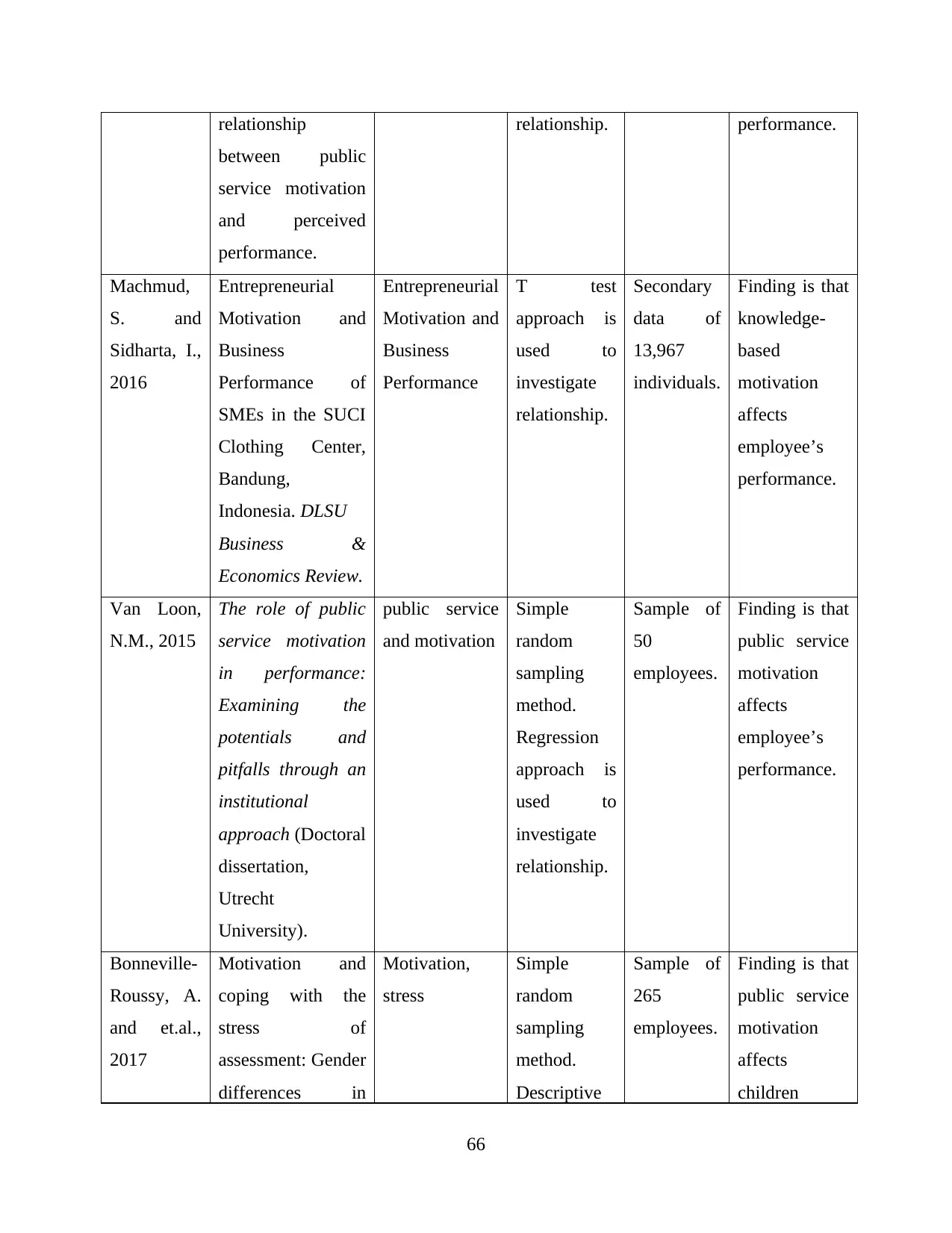
between public
service motivation
and perceived
performance.
relationship. performance.
Machmud,
S. and
Sidharta, I.,
2016
Entrepreneurial
Motivation and
Business
Performance of
SMEs in the SUCI
Clothing Center,
Bandung,
Indonesia. DLSU
Business &
Economics Review.
Entrepreneurial
Motivation and
Business
Performance
T test
approach is
used to
investigate
relationship.
Secondary
data of
13,967
individuals.
Finding is that
knowledge-
based
motivation
affects
employee’s
performance.
Van Loon,
N.M., 2015
The role of public
service motivation
in performance:
Examining the
potentials and
pitfalls through an
institutional
approach (Doctoral
dissertation,
Utrecht
University).
public service
and motivation
Simple
random
sampling
method.
Regression
approach is
used to
investigate
relationship.
Sample of
50
employees.
Finding is that
public service
motivation
affects
employee’s
performance.
Bonneville-
Roussy, A.
and et.al.,
2017
Motivation and
coping with the
stress of
assessment: Gender
differences in
Motivation,
stress
Simple
random
sampling
method.
Descriptive
Sample of
265
employees.
Finding is that
public service
motivation
affects
children
66
Paraphrase This Document
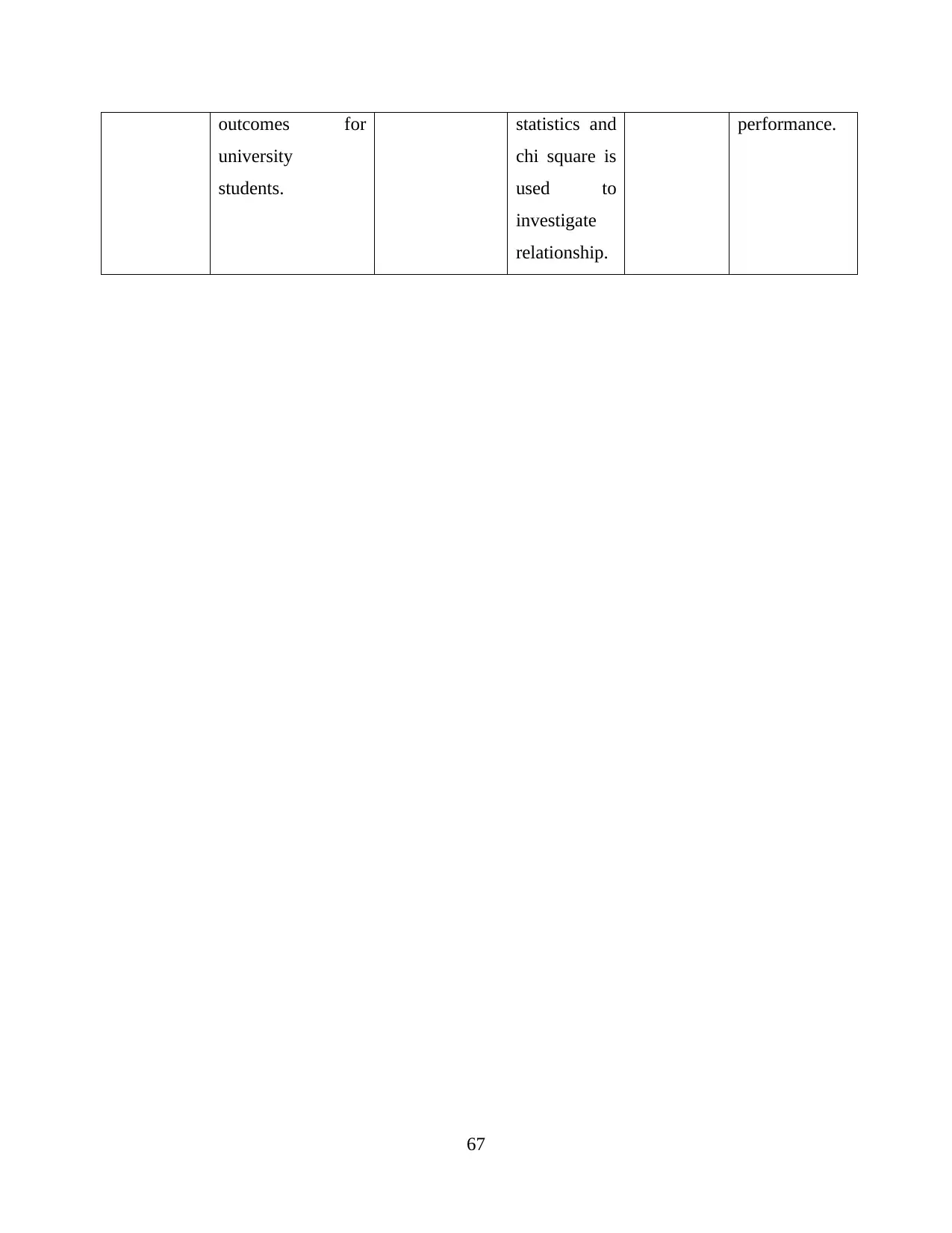
university
students.
statistics and
chi square is
used to
investigate
relationship.
performance.
67
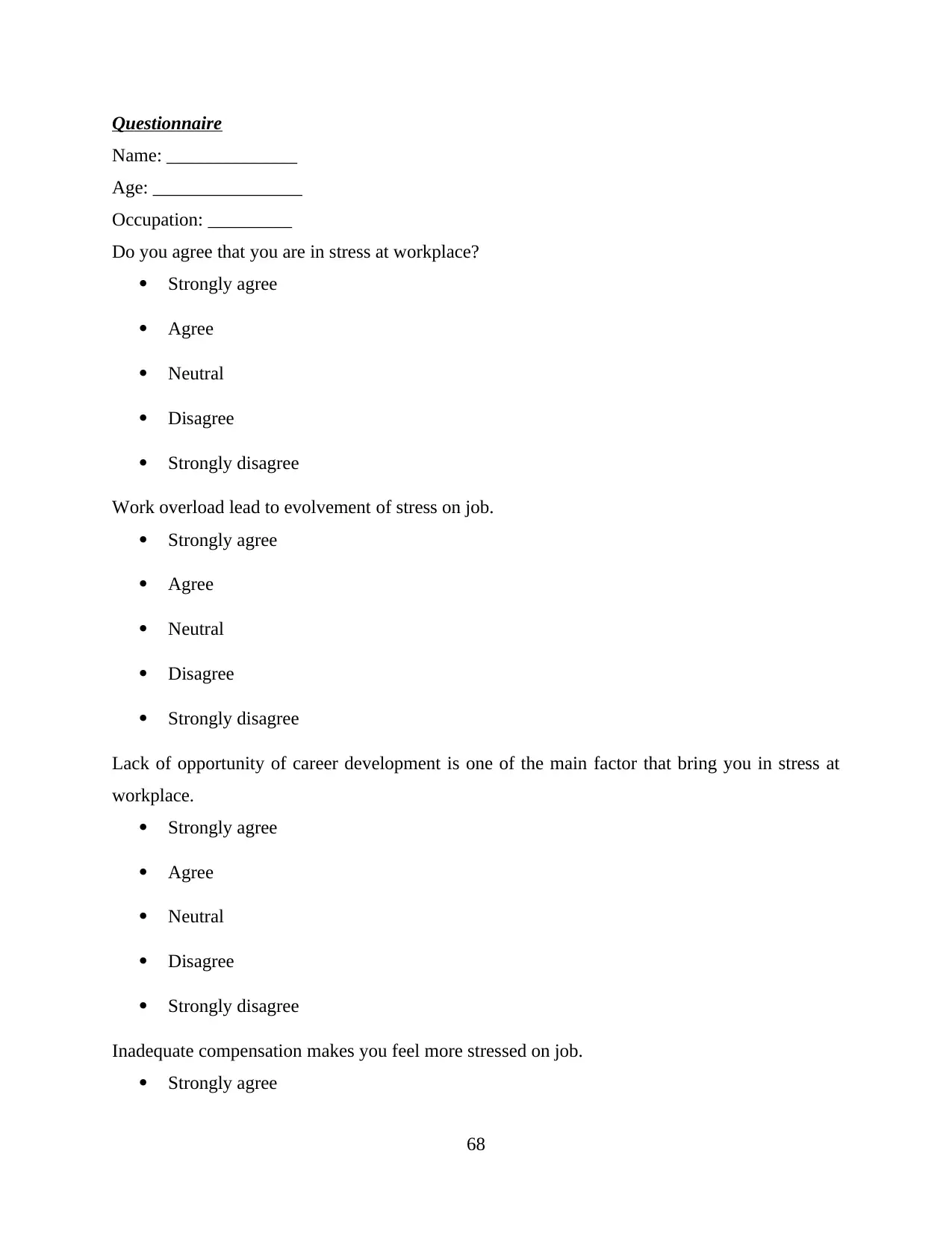
Name: ______________
Age: ________________
Occupation: _________
Do you agree that you are in stress at workplace?
Strongly agree
Agree
Neutral
Disagree
Strongly disagree
Work overload lead to evolvement of stress on job.
Strongly agree
Agree
Neutral
Disagree
Strongly disagree
Lack of opportunity of career development is one of the main factor that bring you in stress at
workplace.
Strongly agree
Agree
Neutral
Disagree
Strongly disagree
Inadequate compensation makes you feel more stressed on job.
Strongly agree
68
⊘ This is a preview!⊘
Do you want full access?
Subscribe today to unlock all pages.

Trusted by 1+ million students worldwide
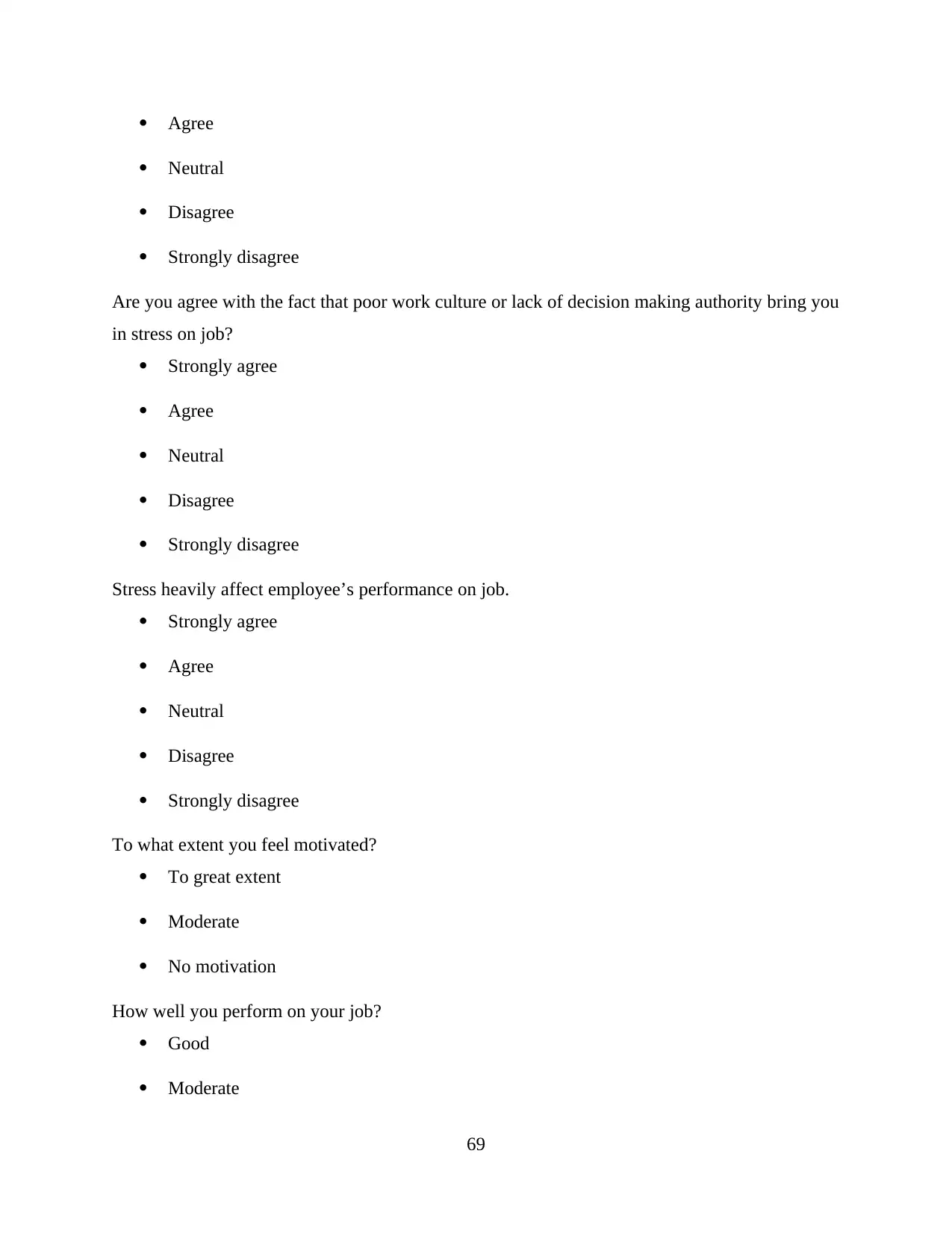
Neutral
Disagree
Strongly disagree
Are you agree with the fact that poor work culture or lack of decision making authority bring you
in stress on job?
Strongly agree
Agree
Neutral
Disagree
Strongly disagree
Stress heavily affect employee’s performance on job.
Strongly agree
Agree
Neutral
Disagree
Strongly disagree
To what extent you feel motivated?
To great extent
Moderate
No motivation
How well you perform on your job?
Good
Moderate
69
Paraphrase This Document
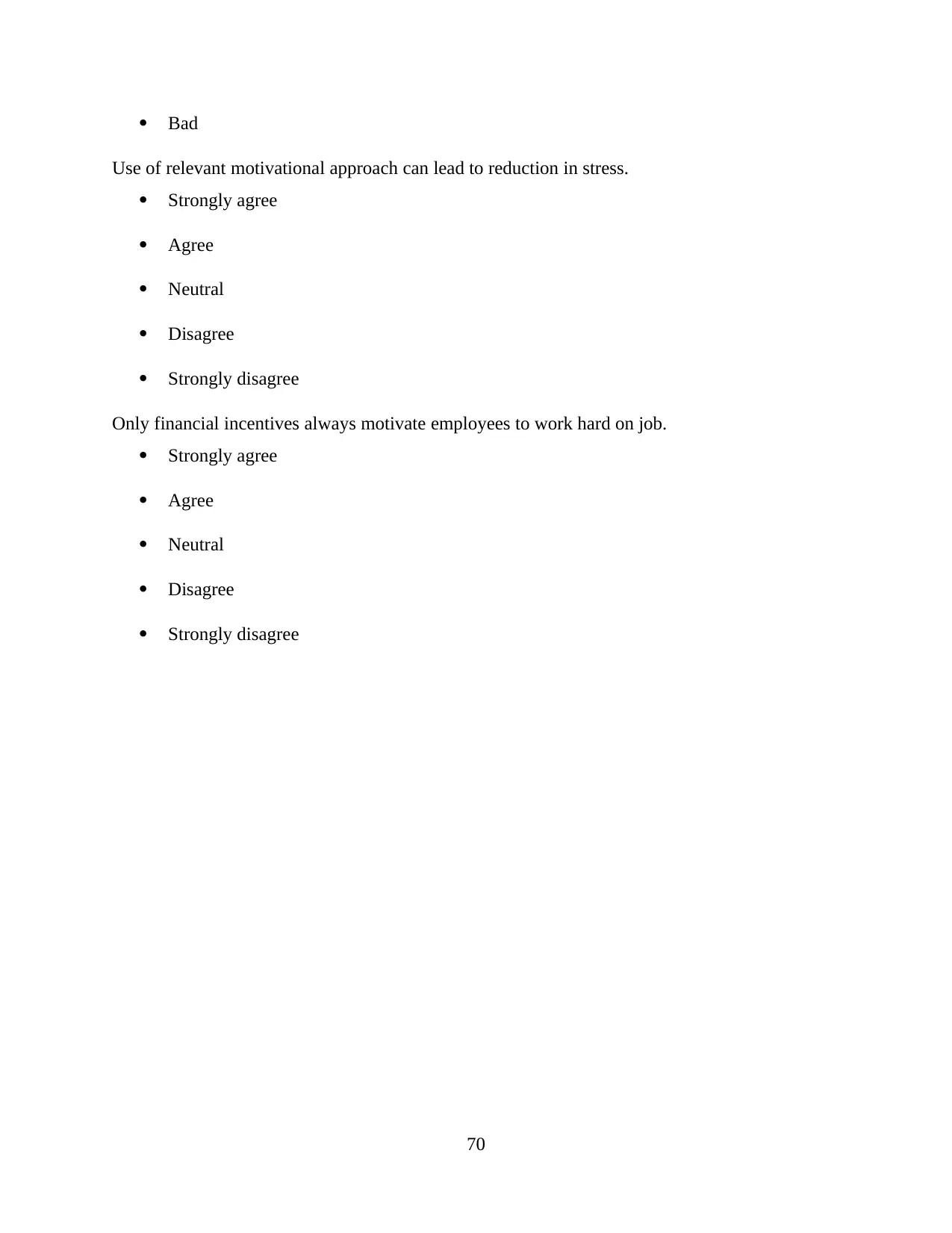
Use of relevant motivational approach can lead to reduction in stress.
Strongly agree
Agree
Neutral
Disagree
Strongly disagree
Only financial incentives always motivate employees to work hard on job.
Strongly agree
Agree
Neutral
Disagree
Strongly disagree
70
Related Documents
Your All-in-One AI-Powered Toolkit for Academic Success.
+13062052269
info@desklib.com
Available 24*7 on WhatsApp / Email
![[object Object]](/_next/static/media/star-bottom.7253800d.svg)
© 2024 | Zucol Services PVT LTD | All rights reserved.





